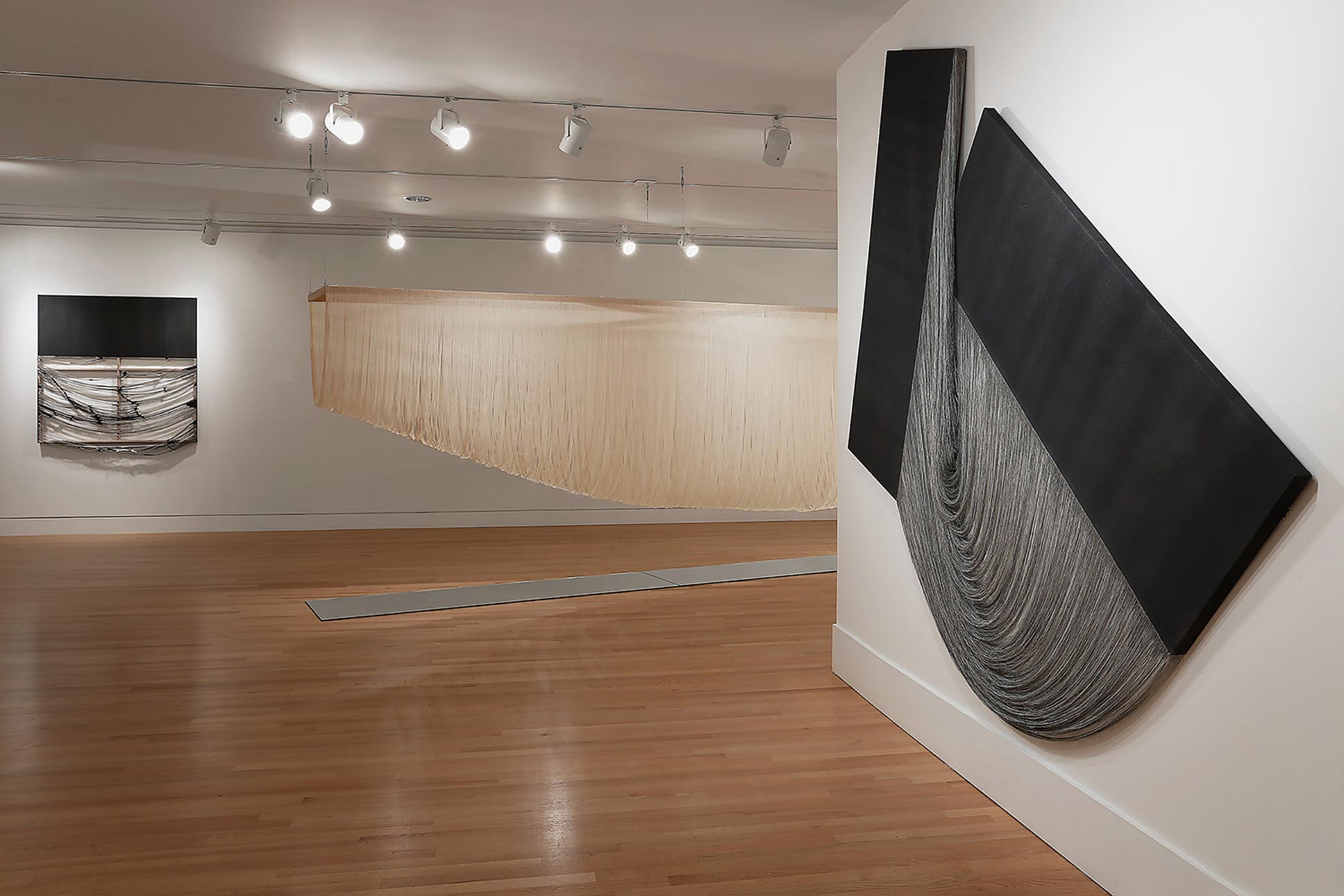
The endeavor of becoming through undoing
The conceptual framework that creation arises from transformation manifests powerfully in the physical realm of art. The core of my artistic practice is precisely what I term the "endeavor of becoming through undoing" - a meticulous, almost introspective process of deconstructing the very foundation of traditional painting. This approach transcends a mere aesthetic choice; it offers a profound metaphor for transformation, challenging my perceptions of finished objects, intrinsic value, and the nature of creative labours itself.
Traditional artistic processes are inherently additive, typically employing a process of “layering” materials and elements over time to complete a work, such as in painting and some sculpture. However, other traditional arts, such as stone and wood carving, employ a “subtractive” process, creating form by removing particular parts from a large block of material. In contemporary art, these boundaries become even more ambiguous, with diverse processes existing that are neither purely additive nor subtractive, or that combine both. My artistic process is fundamentally subtractive, contrasting with the additive approaches, but it is characterized by the “deconstruction” of existing, engineered woven canvases rather than materials that exist in nature.
I systematically reverse the construction process by utilizing an unprimed cotton duck canvas or Belgian linen canvas, materials endorsed by their historic background and inherent characteristics. By painstakingly unraveling and pulling thousands upon thousands of individual warp and weft threads, I disintegrate the image surface. This act of "undoing" is not an erasure, but a re-engagement with the material's latent potential. The removal of threads creates new aspects additively - exposed surfaces and planes that form new structural elements. To reiterate, my process is essentially subtractive, forming the work by removing the warp threads from the canvas.
Through the surfaces and planes created by the thread removal, and the new structural elements they form, I reconstruct a semi-flexible configuration while additively creating new aspects. Things formed through repetition and immense time hold something within them. I blur the boundaries between painting and sculpture, presenting new interpretations of surface, form, and time. And while that time may have the drawback of causing things to become mere shells, I am still intensely drawn to something that persists and endures within them. That something blurs the boundaries of the multi-layered and multifaceted, capable of affirming everything as it quietly engages me.
-
*Installation photographs from the 2018 solo exhibition. For my most recent solo exhibition, held this past September at the Russo Lee Gallery in Portland. This text captures the nebulous thoughts that surfaced while I was immersed in the same space infront of my work. The text does not focus on new ideas or concepts, but rather seeks to articulate the temporal process that encompasses my reflections, activities, and the very act of creating these pieces. I appreciate that this accompanying statement is rather lengthy, and I would be deeply grateful if you could find the time to review it at your convenience.
Image courtesy of the Frye Art Museum, Photo: Mark Woods
The conceptual framework that creation arises from transformation manifests powerfully in the physical realm of art. The core of my artistic practice is precisely what I term the "endeavor of becoming through undoing" - a meticulous, almost introspective process of deconstructing the very foundation of traditional painting. This approach transcends a mere aesthetic choice; it offers a profound metaphor for transformation, challenging my perceptions of finished objects, intrinsic value, and the nature of creative labours itself.
Traditional artistic processes are inherently additive, typically employing a process of “layering” materials and elements over time to complete a work, such as in painting and some sculpture. However, other traditional arts, such as stone and wood carving, employ a “subtractive” process, creating form by removing particular parts from a large block of material. In contemporary art, these boundaries become even more ambiguous, with diverse processes existing that are neither purely additive nor subtractive, or that combine both. My artistic process is fundamentally subtractive, contrasting with the additive approaches, but it is characterized by the “deconstruction” of existing, engineered woven canvases rather than materials that exist in nature.
I systematically reverse the construction process by utilizing an unprimed cotton duck canvas or Belgian linen canvas, materials endorsed by their historic background and inherent characteristics. By painstakingly unraveling and pulling thousands upon thousands of individual warp and weft threads, I disintegrate the image surface. This act of "undoing" is not an erasure, but a re-engagement with the material's latent potential. The removal of threads creates new aspects additively - exposed surfaces and planes that form new structural elements. To reiterate, my process is essentially subtractive, forming the work by removing the warp threads from the canvas.
Through the surfaces and planes created by the thread removal, and the new structural elements they form, I reconstruct a semi-flexible configuration while additively creating new aspects. Things formed through repetition and immense time hold something within them. I blur the boundaries between painting and sculpture, presenting new interpretations of surface, form, and time. And while that time may have the drawback of causing things to become mere shells, I am still intensely drawn to something that persists and endures within them. That something blurs the boundaries of the multi-layered and multifaceted, capable of affirming everything as it quietly engages me.
-
*Installation photographs from the 2018 solo exhibition. For my most recent solo exhibition, held this past September at the Russo Lee Gallery in Portland. This text captures the nebulous thoughts that surfaced while I was immersed in the same space infront of my work. The text does not focus on new ideas or concepts, but rather seeks to articulate the temporal process that encompasses my reflections, activities, and the very act of creating these pieces. I appreciate that this accompanying statement is rather lengthy, and I would be deeply grateful if you could find the time to review it at your convenience.
Image courtesy of the Frye Art Museum, Photo: Mark Woods
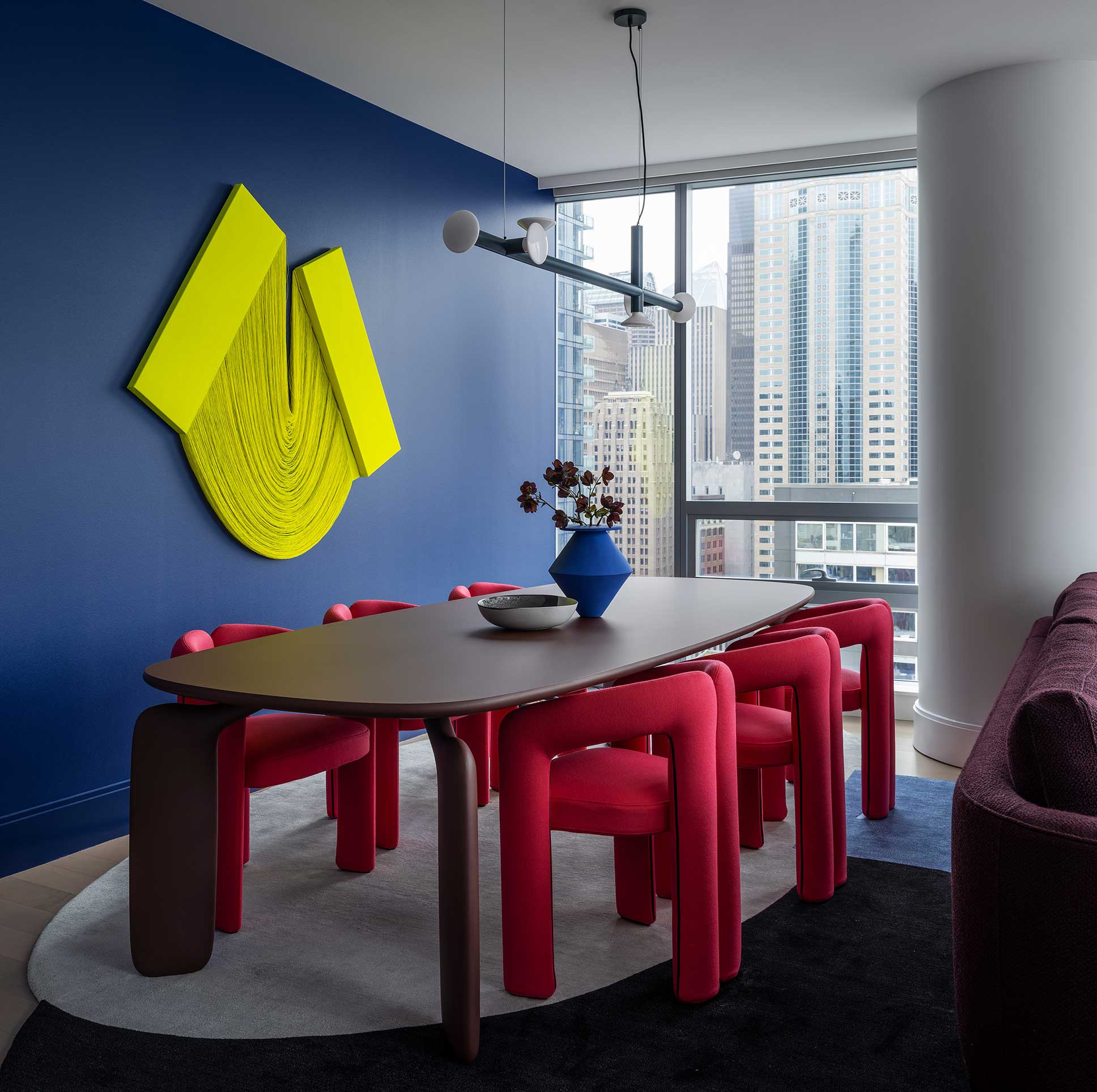
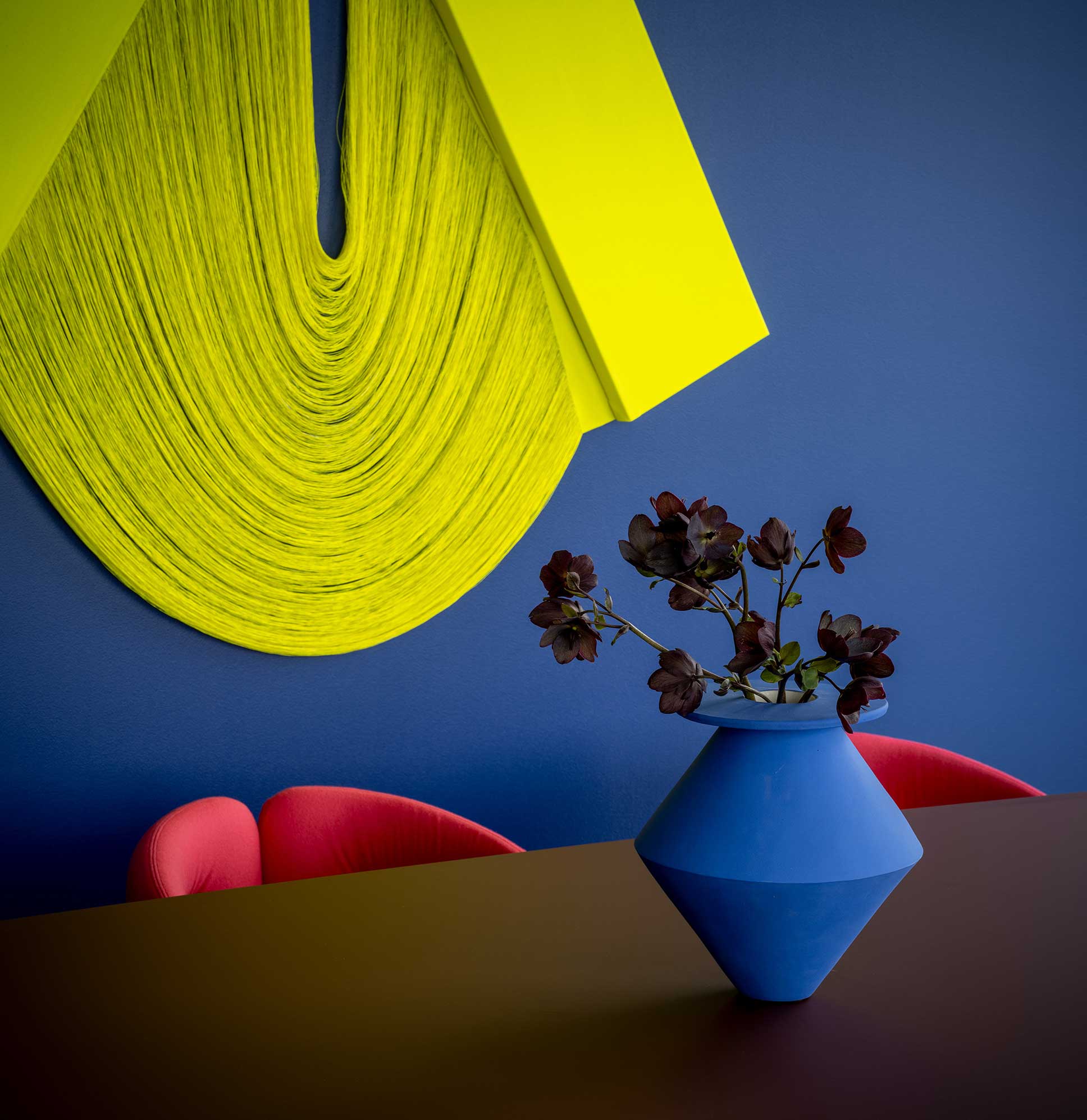
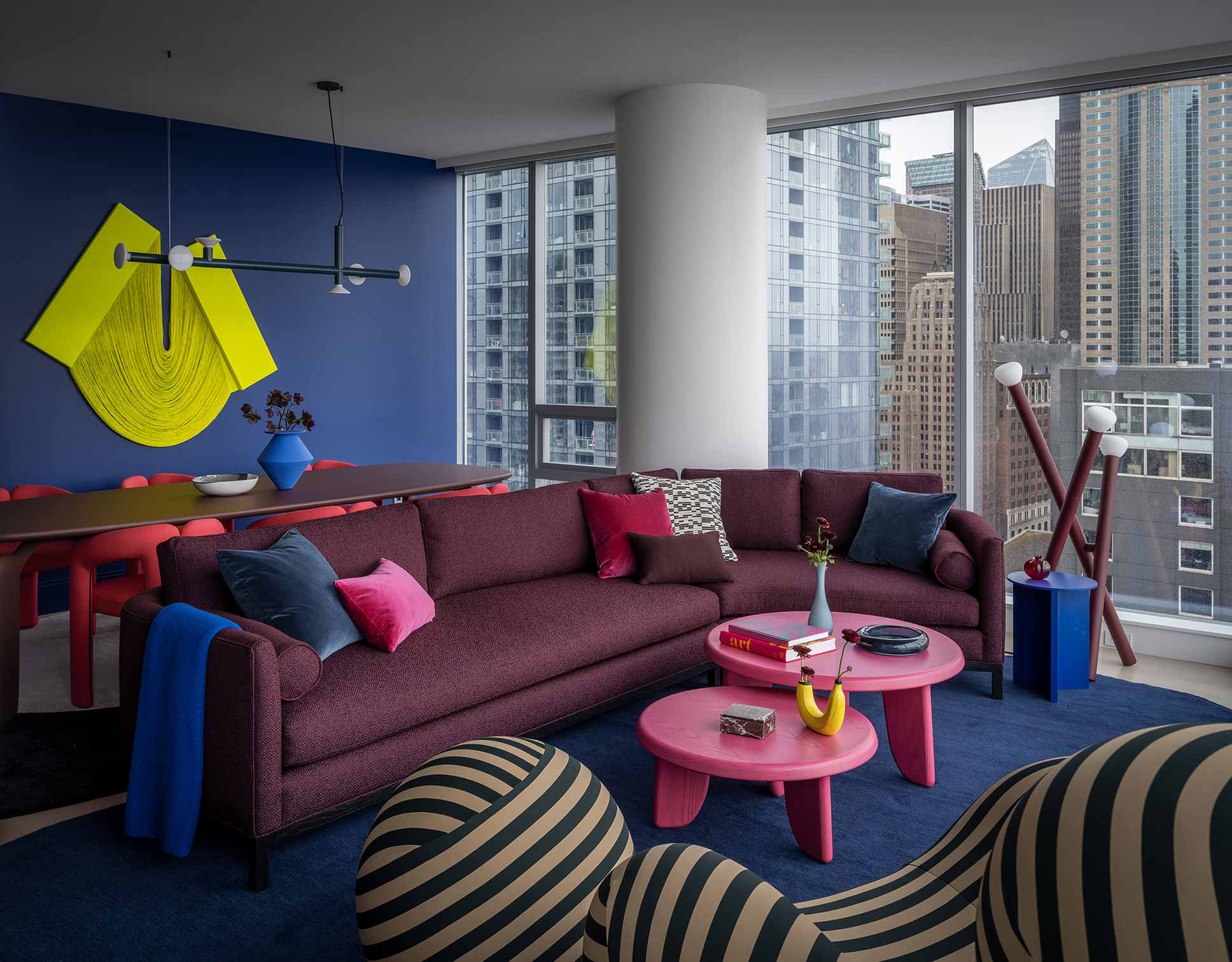
This wall-mounted, fluorescent fan-shaped piece was created for a special project with Michelle Dirkse Interior Design. Retaining the standard fan shape, the piece is distinguished by a unique approach to both color application and framing.
To achieve a consistent, vibrant glow, multiple layers of fluorescent yellow were applied evenly to both sides of the canvas. After this saturation, all vertical (warp) threads in the central section were meticulously removed by hand, and the remaining horizontal (weft) threads were then re-colored to maintain a uniform hue throughout. The method for attaching the wooden frame is also unique: the canvas's left edge was intentionally folded back twice before being secured to the right frame. This process creates subtle, distorted pleats and irregular bulges, causing the material thickness and drape to vary between the left and right sides. Because the fluorescent color absorbs light, the resulting diffuse reflection creates a sense of fluid movement that shifts both vertically and horizontally depending on the viewer's perspective.
I am delighted to have been involved in this project, the overall balance of the various elements is truly wonderful. These three stunning photographs were taken by Aaron Leitz.
fluorescent yellow, untitled
2025
acrylic, graphite, partially unwoven canvas, wood
H60 x W54 x D2 inches
Image courtesy of Michelle Dirkse Interior Design, Photo: Aaron Leitz
To achieve a consistent, vibrant glow, multiple layers of fluorescent yellow were applied evenly to both sides of the canvas. After this saturation, all vertical (warp) threads in the central section were meticulously removed by hand, and the remaining horizontal (weft) threads were then re-colored to maintain a uniform hue throughout. The method for attaching the wooden frame is also unique: the canvas's left edge was intentionally folded back twice before being secured to the right frame. This process creates subtle, distorted pleats and irregular bulges, causing the material thickness and drape to vary between the left and right sides. Because the fluorescent color absorbs light, the resulting diffuse reflection creates a sense of fluid movement that shifts both vertically and horizontally depending on the viewer's perspective.
I am delighted to have been involved in this project, the overall balance of the various elements is truly wonderful. These three stunning photographs were taken by Aaron Leitz.
fluorescent yellow, untitled
2025
acrylic, graphite, partially unwoven canvas, wood
H60 x W54 x D2 inches
Image courtesy of Michelle Dirkse Interior Design, Photo: Aaron Leitz
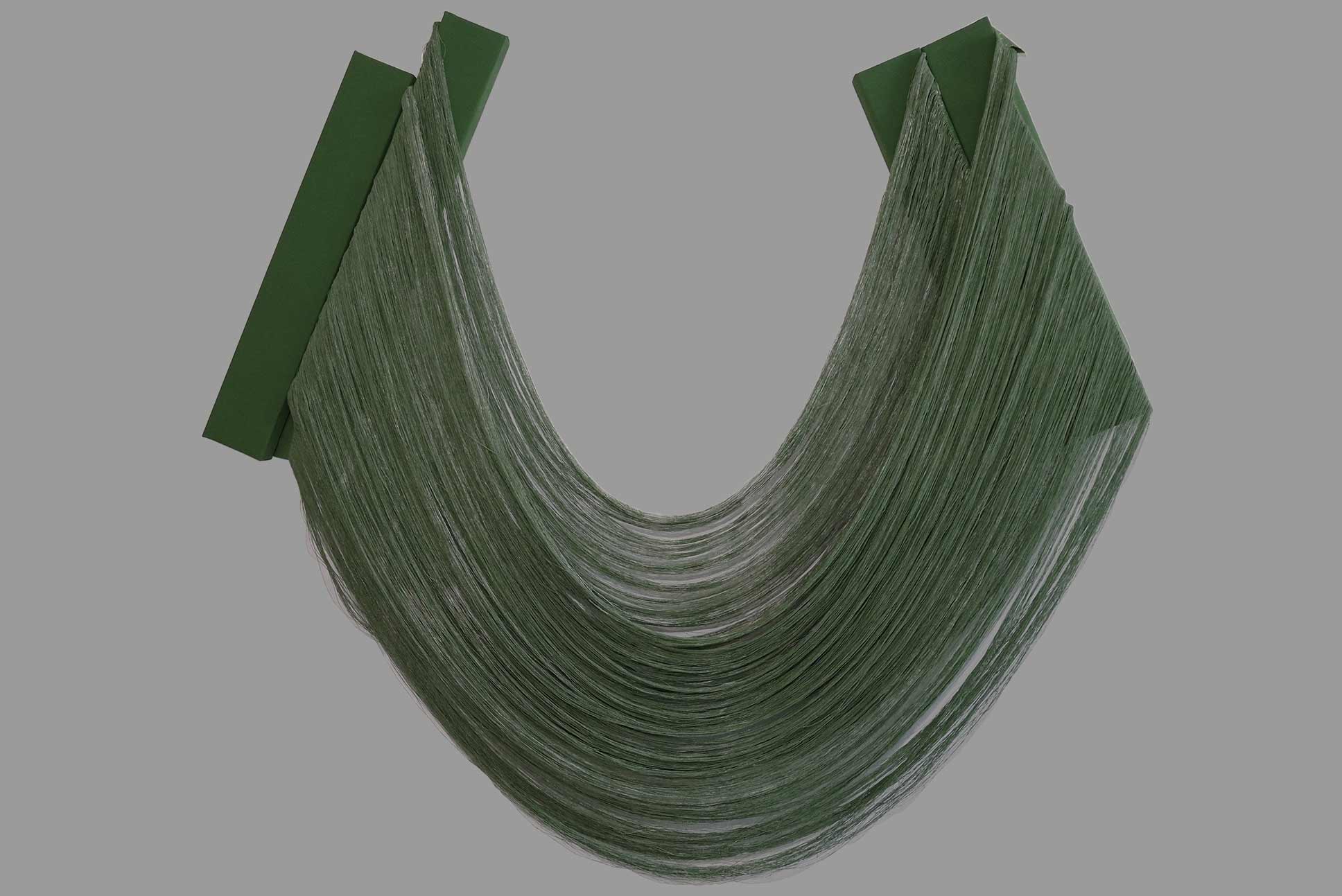
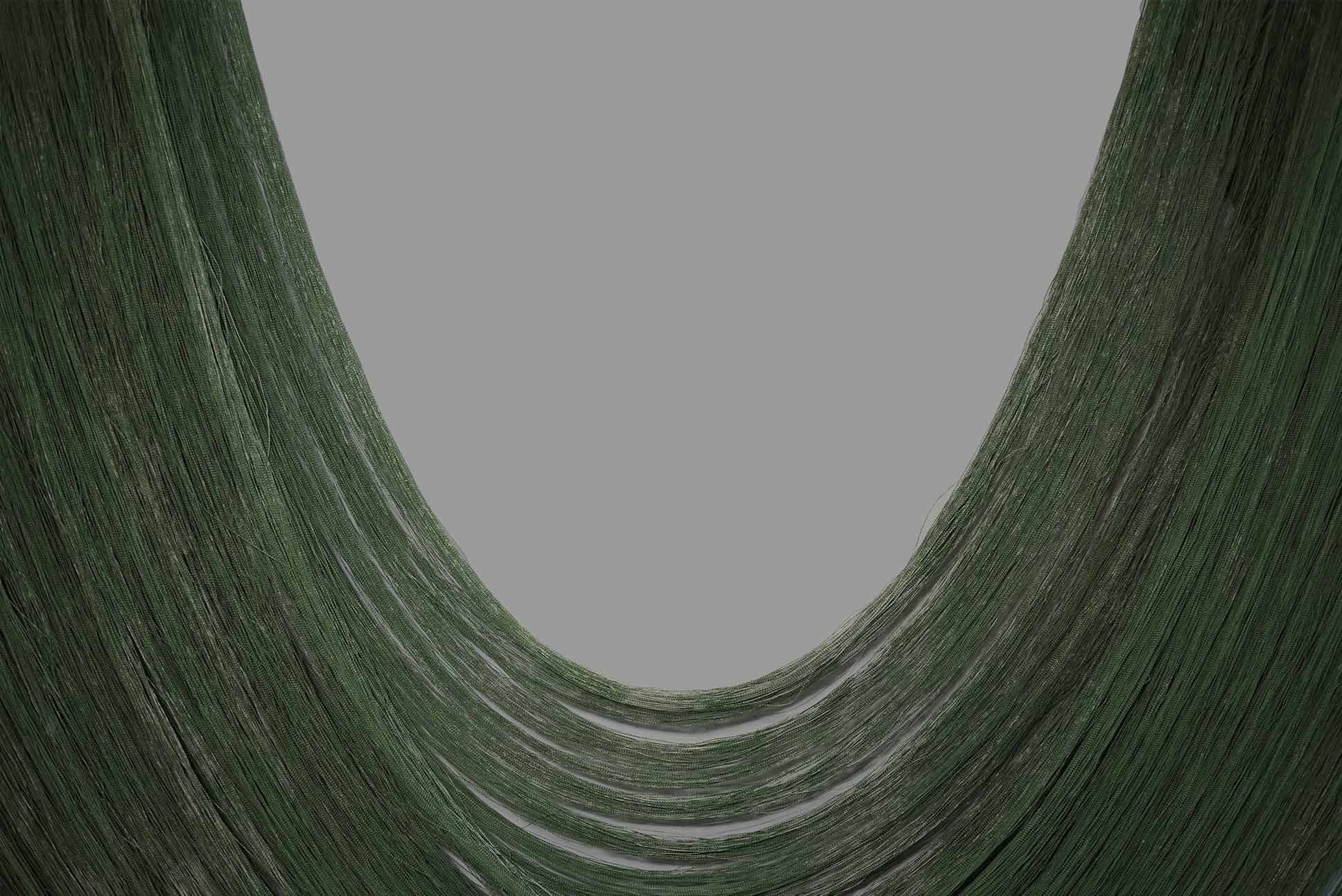
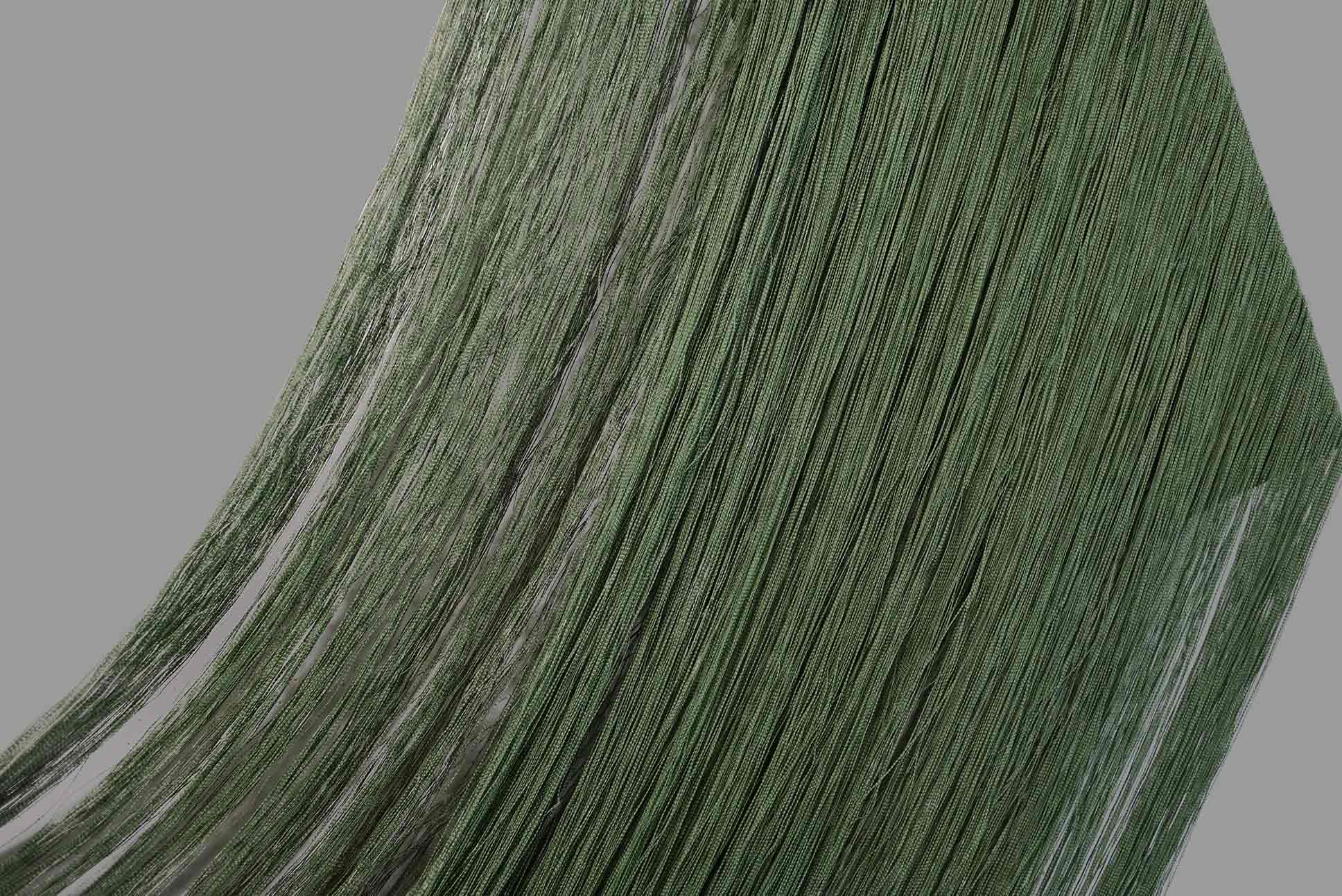
color of primeval forest, untitled
2025
acrylic, graphite, partially unwoven canvas, wood
H59 x W63 x D5 inches
This work is a wall-mounted, parallel diptych that explores the duality of front and back. Except for the leftmost frame, the canvas edges are folded inward three times and attached within the frame, intentionally exposing the folds on the reverse side. This technique positions the back as the front, making both surfaces one unified whole.
To further visualize this multilayered structure, intentional color variations are introduced in the hues applied to both sides of the canvas and the entire piece. This creates a visual texture in the bundles of weft threads at the center, where all individual warp threads were removed by hand. As these bundles overlap, their subtle misalignment blurs the boundaries of the multilayered surfaces, ultimately challenging established perceptions of surface integrity and boundaries.
2025
acrylic, graphite, partially unwoven canvas, wood
H59 x W63 x D5 inches
This work is a wall-mounted, parallel diptych that explores the duality of front and back. Except for the leftmost frame, the canvas edges are folded inward three times and attached within the frame, intentionally exposing the folds on the reverse side. This technique positions the back as the front, making both surfaces one unified whole.
To further visualize this multilayered structure, intentional color variations are introduced in the hues applied to both sides of the canvas and the entire piece. This creates a visual texture in the bundles of weft threads at the center, where all individual warp threads were removed by hand. As these bundles overlap, their subtle misalignment blurs the boundaries of the multilayered surfaces, ultimately challenging established perceptions of surface integrity and boundaries.
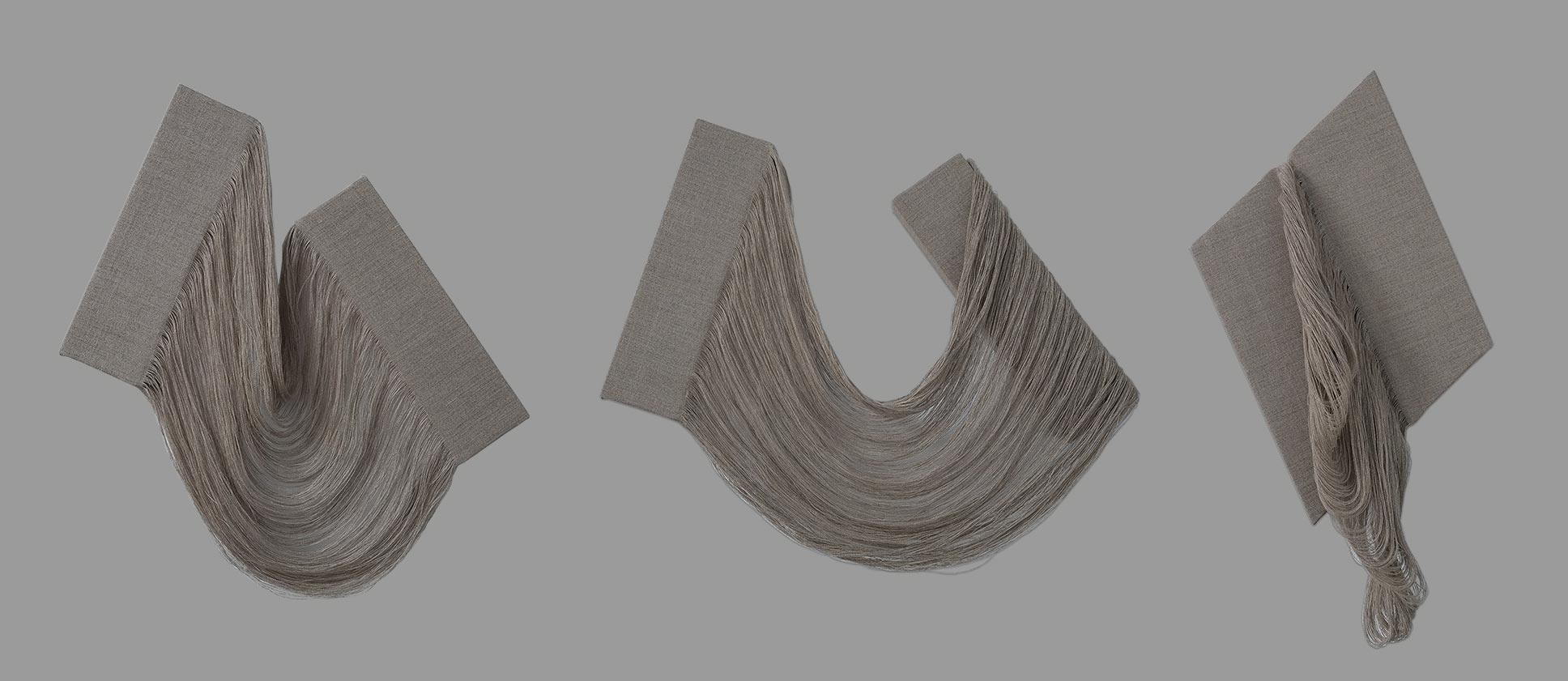
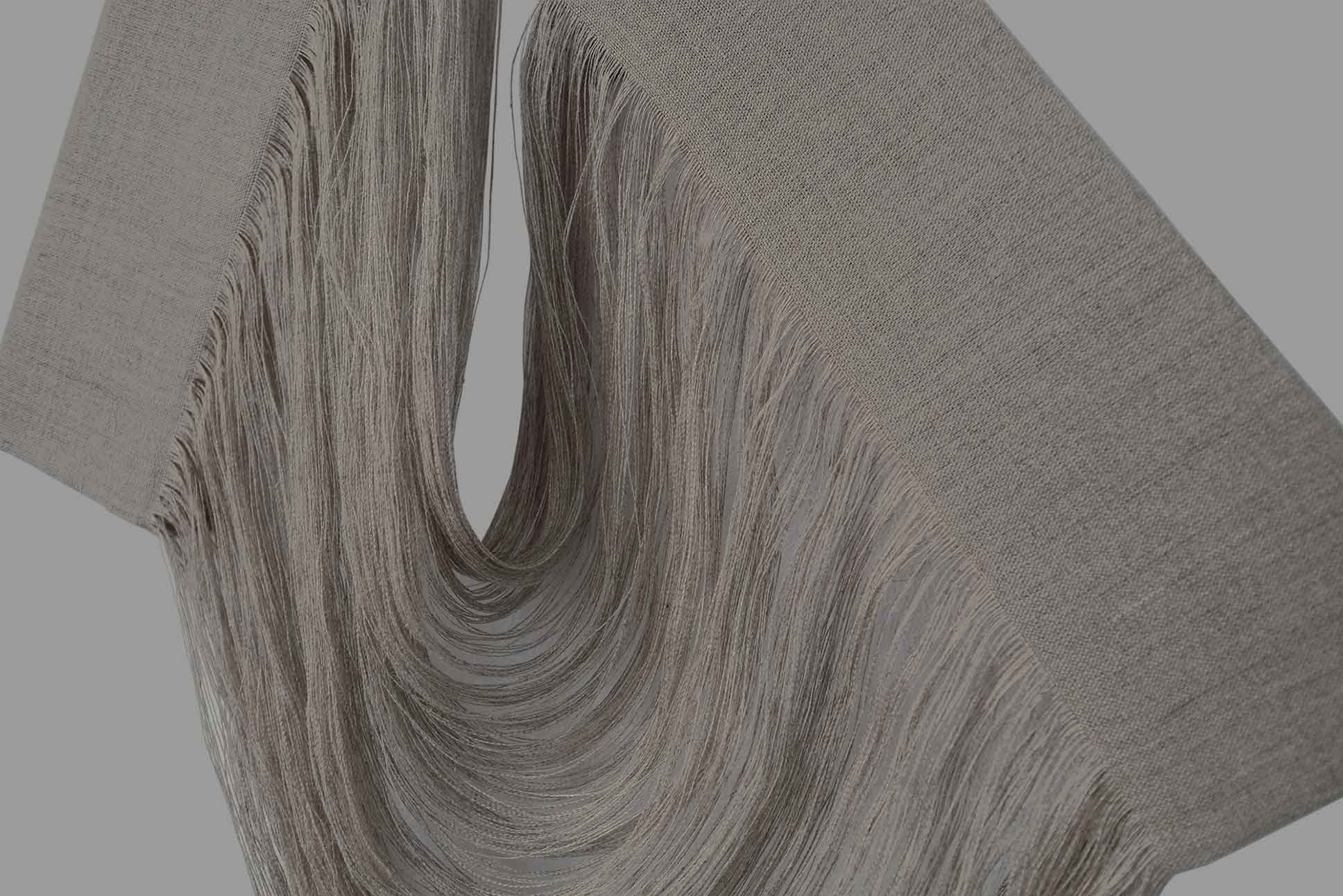


fourteen inch, untitled
2025
graphite, partially unwoven linen canvas, wood
H25 x W25 x D3 inches each
2025
graphite, partially unwoven linen canvas, wood
H25 x W25 x D3 inches each
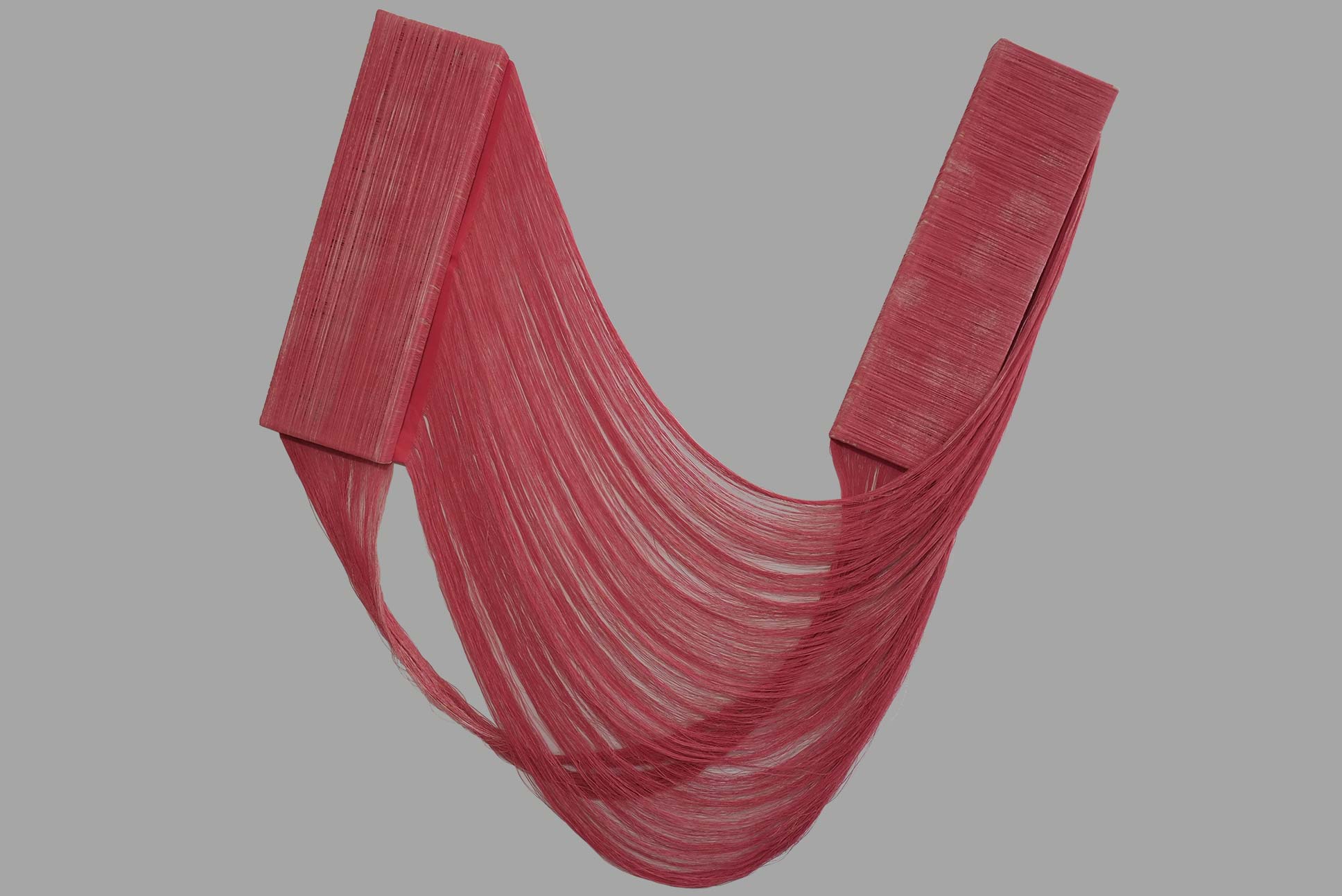
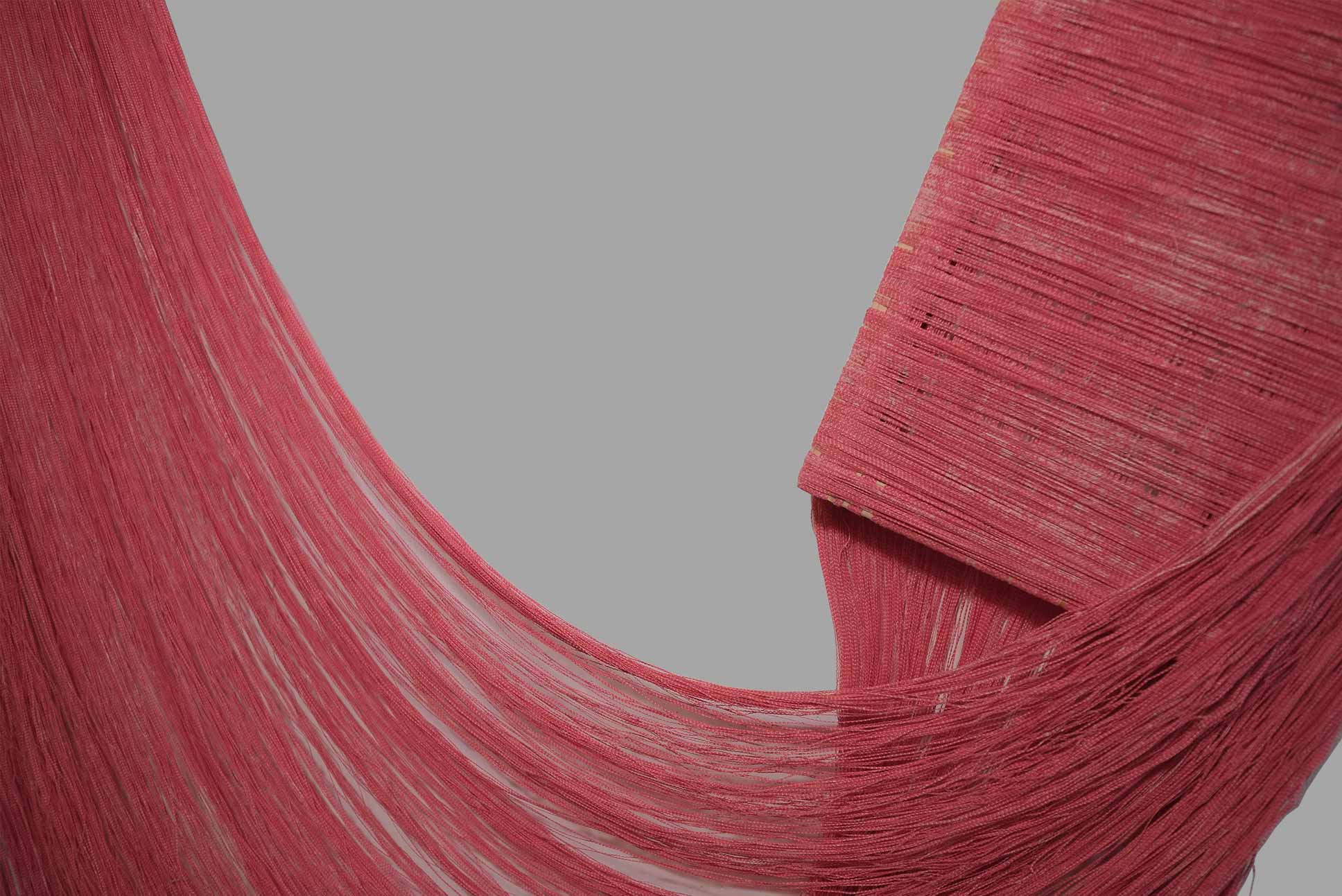
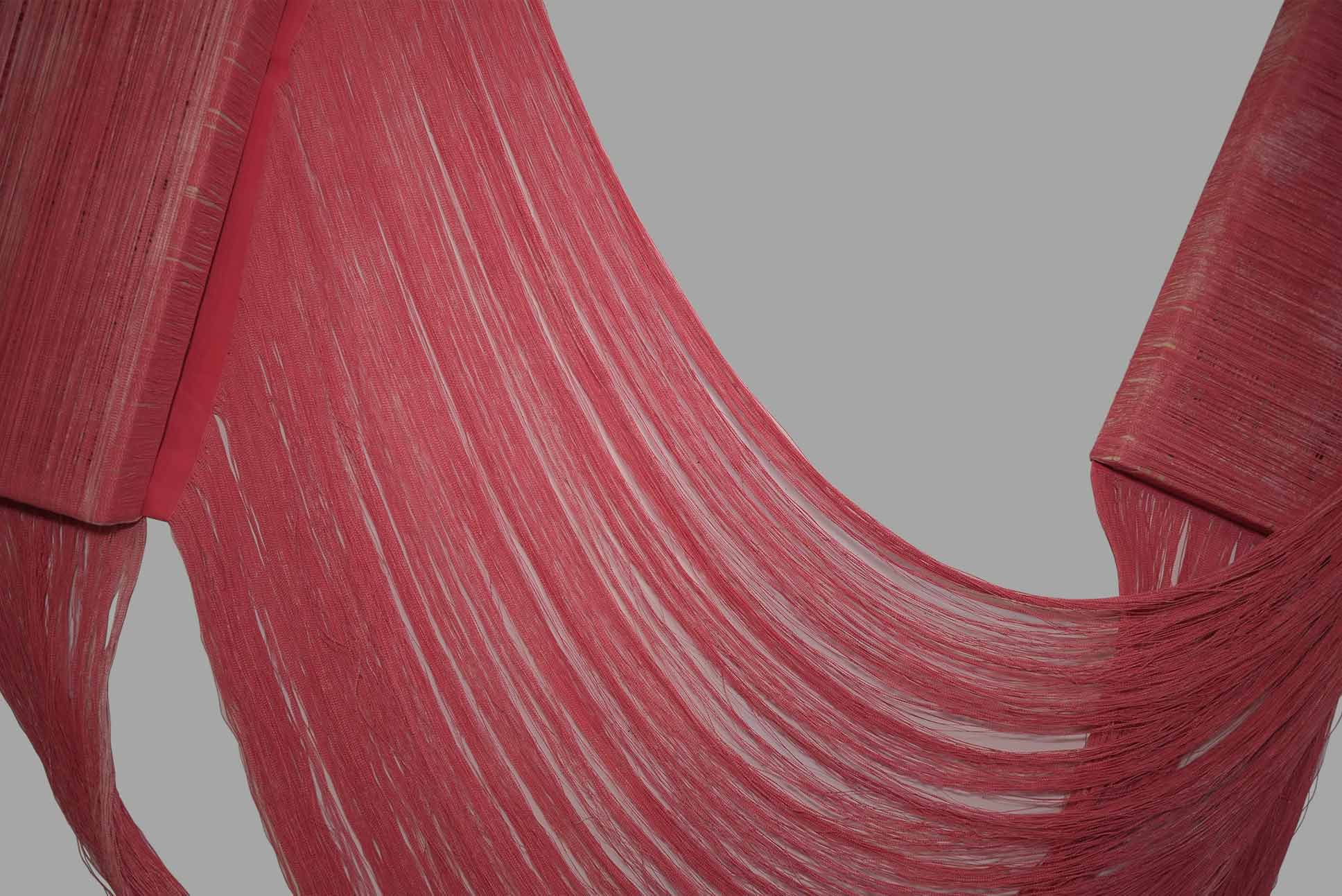
same color fluctuations, untitled
2025
acrylic, graphite, partially unwoven canvas, wood
H53 x W52 x D5 inches
This wall hanging describes a complex artistic process that explores the concepts of structure and time. The method begins with the meticulous removal of thousands of individual warp and weft threads from a set of canvases. These threads are then painstakingly reconfigured onto a new frame.
The process involves the precise arrangement of these threads. By alternating bundles of the same color on both left and right structures, the artist introduces subtle variations in the direction of each bundle's undulation. This technique creates visual interest and a sense of movement.
To enhance the dynamic contrast and depth, color tones are deliberately applied using brush strokes. This application produces an effect that gives the artwork a sense of three-dimensionality where the colors overlap. Through this multi-step process of deconstruction, reconfiguration, and application of color, the artwork blurs conventional understandings of structure and time.
2025
acrylic, graphite, partially unwoven canvas, wood
H53 x W52 x D5 inches
This wall hanging describes a complex artistic process that explores the concepts of structure and time. The method begins with the meticulous removal of thousands of individual warp and weft threads from a set of canvases. These threads are then painstakingly reconfigured onto a new frame.
The process involves the precise arrangement of these threads. By alternating bundles of the same color on both left and right structures, the artist introduces subtle variations in the direction of each bundle's undulation. This technique creates visual interest and a sense of movement.
To enhance the dynamic contrast and depth, color tones are deliberately applied using brush strokes. This application produces an effect that gives the artwork a sense of three-dimensionality where the colors overlap. Through this multi-step process of deconstruction, reconfiguration, and application of color, the artwork blurs conventional understandings of structure and time.
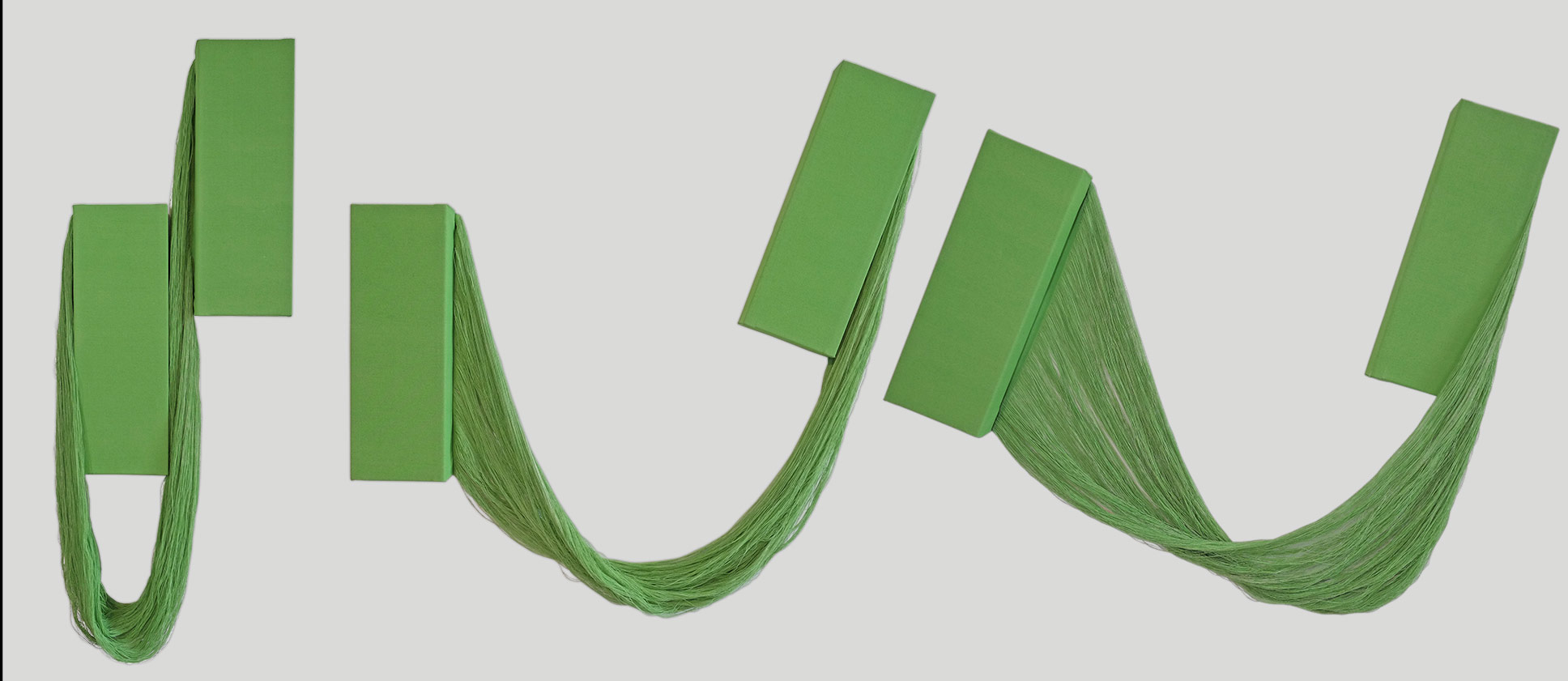

common denominator, untitled
2025
acrylic, graphite, partially unwoven canvas, wood
H40 x W40 x D3 inches each
This triptych is a work that pursues the transformation of materials and visual unity. To ensure a stable and consistent color tone throughout the work—even within the drape of the central weft threads after deconstruction—the canvas has been meticulously pre-coated with multiple layers of color on both sides.
A common language unifies the three pieces, extending beyond their shared palette. Each piece possesses identical dimensions, and during installation, the angles of the frames flanking the central work are precisely aligned with the adjacent frames. The work's cohesion is expressed through the precise interplay of color, scale, and angle; each element is carefully calibrated to resonate with the others, creating a consistent dialogue throughout the composition.
The triptych possesses a mirror-like compositional potential that challenges traditional perception. Inverting the central piece not only creates a new arrangement but also reveals a mirrored overall image, presenting a new visual navigation through the work. This inversion deliberately blurs the boundary between the visible and the implied, demonstrating how the space between the pieces, the viewer's perspective, and the inherent texture of the thread profoundly influence perception and form.
2025
acrylic, graphite, partially unwoven canvas, wood
H40 x W40 x D3 inches each
This triptych is a work that pursues the transformation of materials and visual unity. To ensure a stable and consistent color tone throughout the work—even within the drape of the central weft threads after deconstruction—the canvas has been meticulously pre-coated with multiple layers of color on both sides.
A common language unifies the three pieces, extending beyond their shared palette. Each piece possesses identical dimensions, and during installation, the angles of the frames flanking the central work are precisely aligned with the adjacent frames. The work's cohesion is expressed through the precise interplay of color, scale, and angle; each element is carefully calibrated to resonate with the others, creating a consistent dialogue throughout the composition.
The triptych possesses a mirror-like compositional potential that challenges traditional perception. Inverting the central piece not only creates a new arrangement but also reveals a mirrored overall image, presenting a new visual navigation through the work. This inversion deliberately blurs the boundary between the visible and the implied, demonstrating how the space between the pieces, the viewer's perspective, and the inherent texture of the thread profoundly influence perception and form.
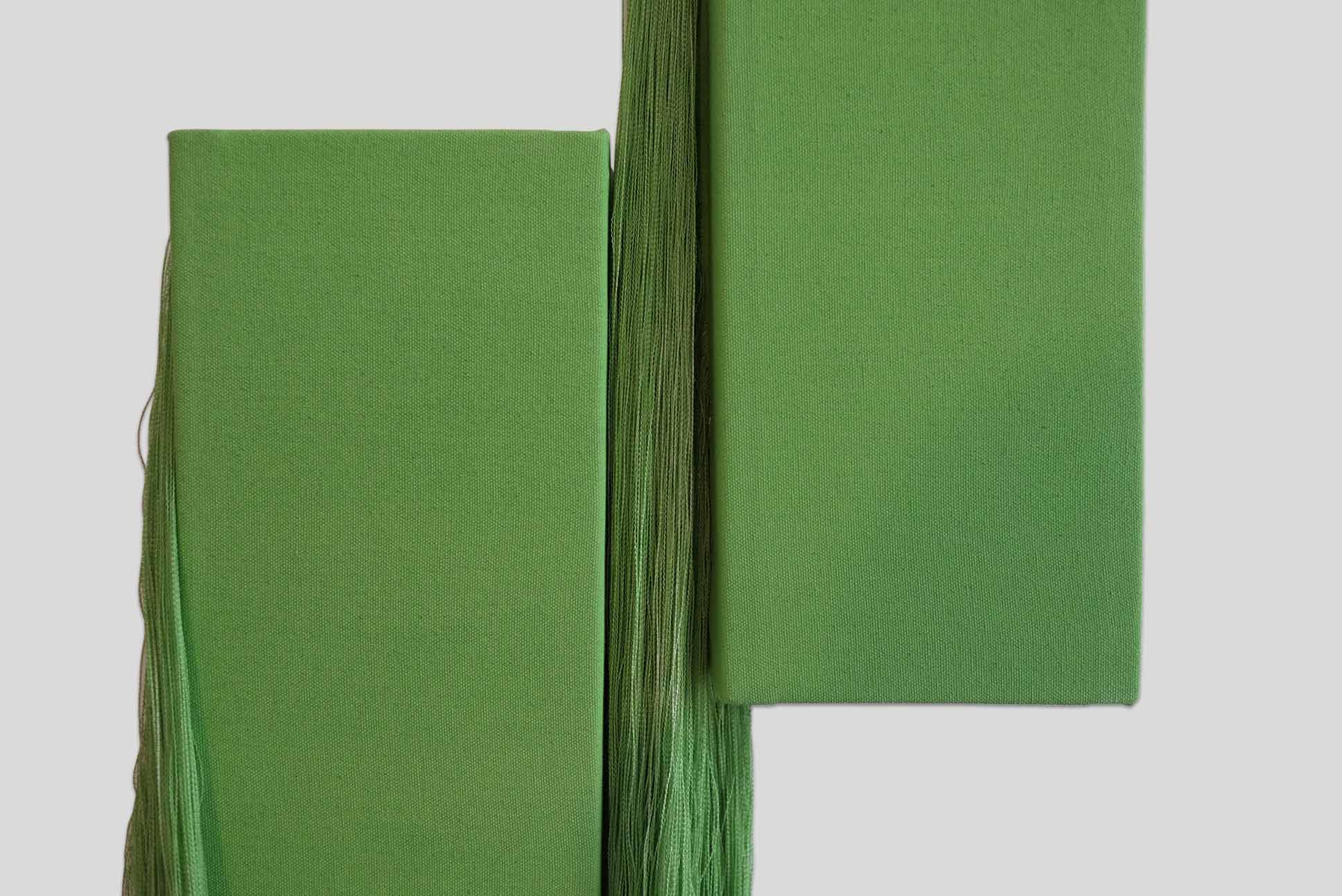


Untitled
2022
acrylic, graphite, partially unwoven canvas, wood
H30 x W44 x D3 inches
Vitamin P:NW
Recent Painting in the Pacific Northwest
In much the same way that the body requires a diverse variety of vitamins to remain healthy, function properly, and to grow, the visual arts rely on a regimen of media and practices that are integral to its well-being. Steadfast among those visual and material supplements is “Vitamin P”- Painting.
A central pillar of Western art, over the past century the practice of painting has undergone seismic transformations, been declared dead, revived, and been used as an ideological battleground for artistic and cultural discourse. Today the power and relevance of painting remains as strong as ever, as artists continue to turn to brush and canvas as the chosen tools to brave investigations of their natural and cultural environments, the self, and the material aspects of their chosen medium.
Vitamin P:NW offers a bird’s-eye-view of recent trends in painting in the Pacific Northwest. Surveying the thematic landscape of current painting in the region, the exhibition features artist’s fresh takes on the environment, themes of introspection and cultural critique, and pushing the physical boundaries of painting past two-dimensional space.
*text from the Museum of Northwest Art
October 11th, 2025 - January 11th, 2026
Vitamin P:NW
Recent Painting in the Pacific Northwest
Museum of Northwest Art
https://www.monamuseum.org/vitamin-p
2022
acrylic, graphite, partially unwoven canvas, wood
H30 x W44 x D3 inches
Vitamin P:NW
Recent Painting in the Pacific Northwest
In much the same way that the body requires a diverse variety of vitamins to remain healthy, function properly, and to grow, the visual arts rely on a regimen of media and practices that are integral to its well-being. Steadfast among those visual and material supplements is “Vitamin P”- Painting.
A central pillar of Western art, over the past century the practice of painting has undergone seismic transformations, been declared dead, revived, and been used as an ideological battleground for artistic and cultural discourse. Today the power and relevance of painting remains as strong as ever, as artists continue to turn to brush and canvas as the chosen tools to brave investigations of their natural and cultural environments, the self, and the material aspects of their chosen medium.
Vitamin P:NW offers a bird’s-eye-view of recent trends in painting in the Pacific Northwest. Surveying the thematic landscape of current painting in the region, the exhibition features artist’s fresh takes on the environment, themes of introspection and cultural critique, and pushing the physical boundaries of painting past two-dimensional space.
*text from the Museum of Northwest Art
October 11th, 2025 - January 11th, 2026
Vitamin P:NW
Recent Painting in the Pacific Northwest
Museum of Northwest Art
https://www.monamuseum.org/vitamin-p

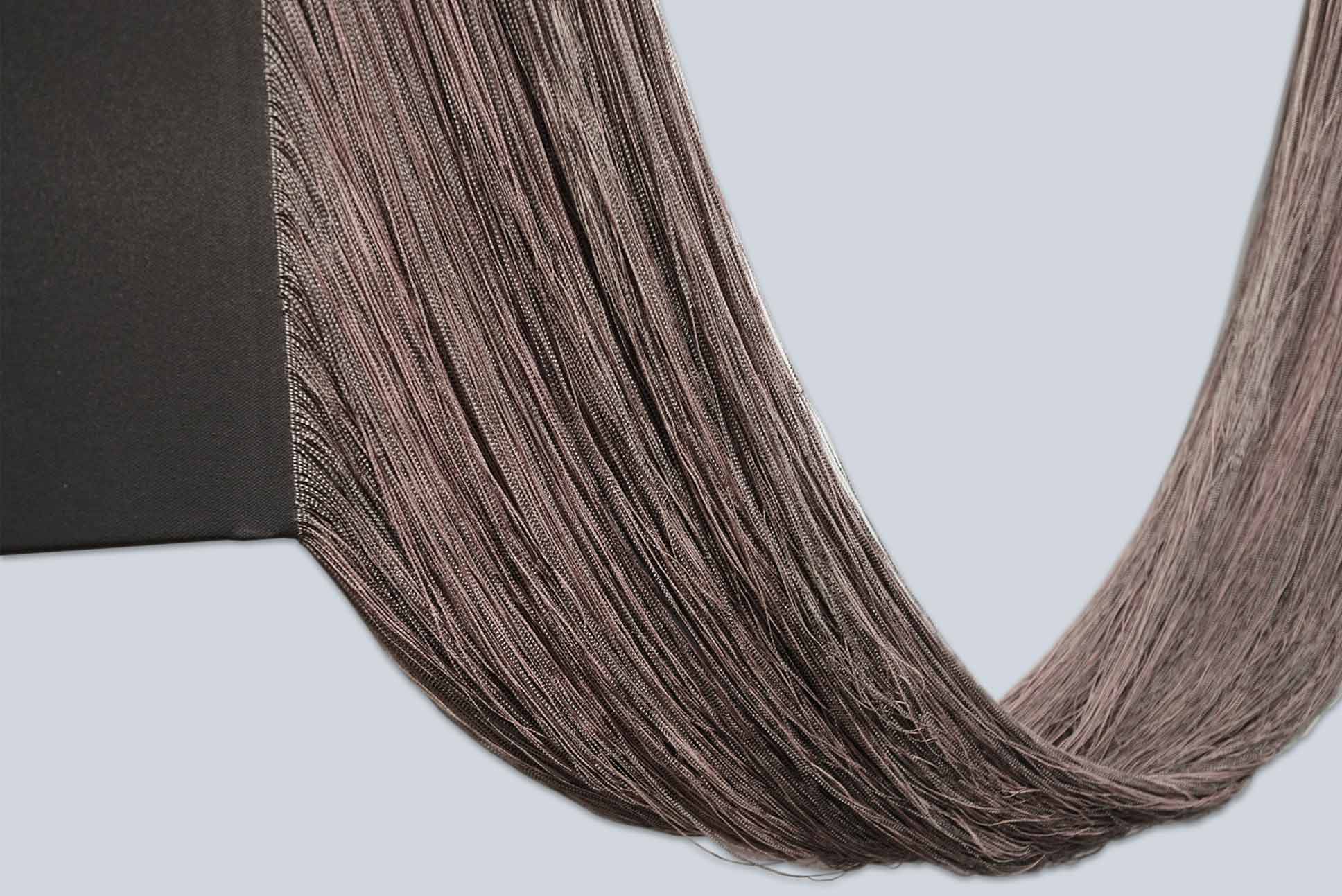
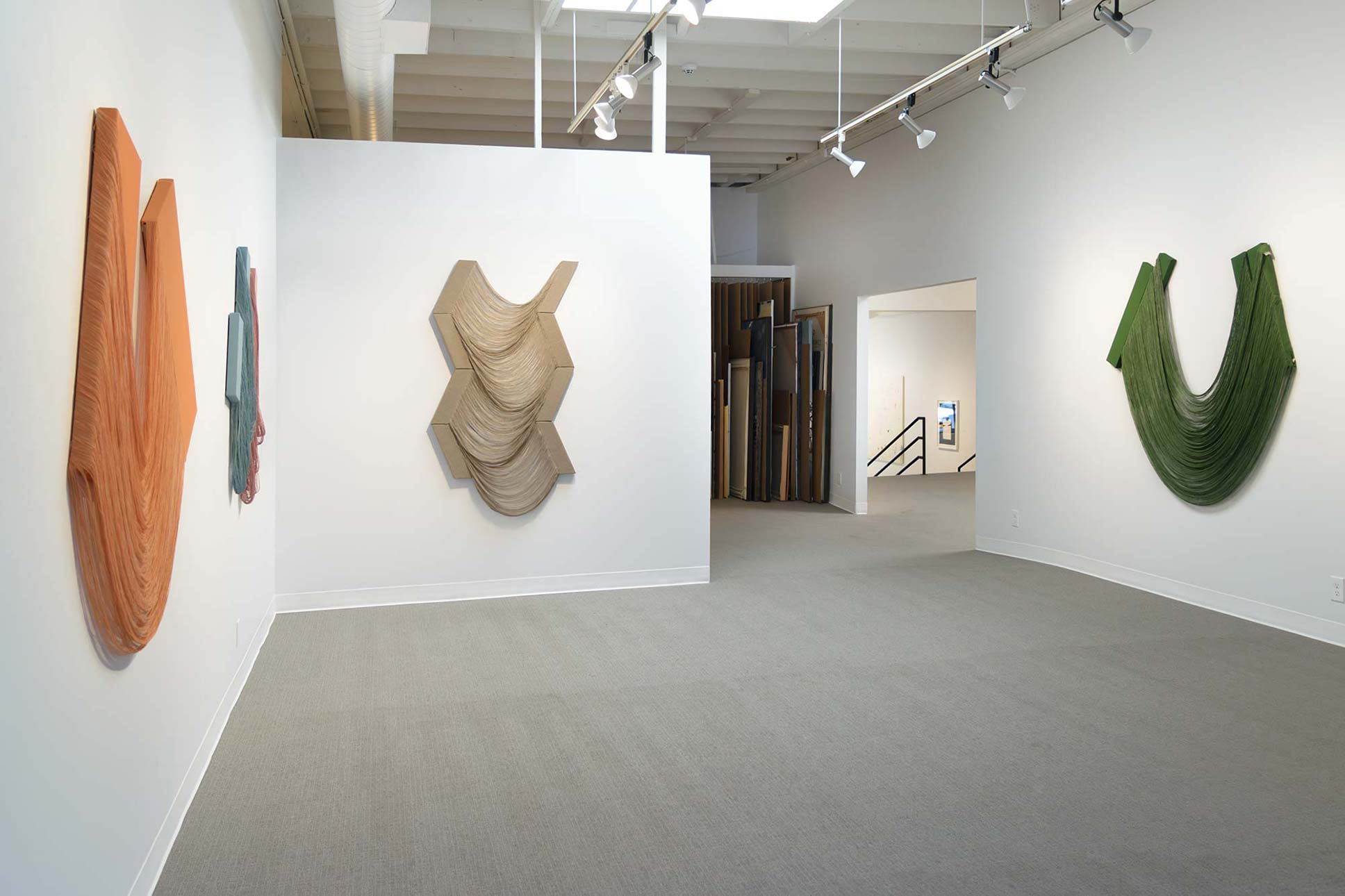
the moment of immersing themselves in the same space in front of the piece, untitled
The moment of immersing themselves in the same space in front of the piece is precious, a fleeting event, a vortex of the unwritten rules of subjectivity and comprehensive or aerial perspective, a relationship that is made up of moments, experiences, knowledge, and all sorts of factors, but it also changes unintentionally and unconsciously.
A process of rumination, of drawing out the threads of a woven canvas and simultaneously transforming them into new forms, a process of spinning time in a sense, and there is something inherent in this that blurs the concept of time, multifaceted ideas, layered structures, and boundaries form the surface, and as these are gradually added, the surface is eventually scraped away, the curves increase, and a spherical shape is formed, blurring the boundaries of the surfaces.
This mutual relationship may be due to external factors, but it can also be due to internal factors, and the viewer reflects on both of these at the same time through others and the piece.
Sepetember 4th - 27th, 2025
"the moment of immersing themselves in the same space in front of the piece, untitled" at Russo Lee Gallery, Portland OR
https://www.russoleegallery.com/exhibitions/ko-kirk-yamahira5
The moment of immersing themselves in the same space in front of the piece is precious, a fleeting event, a vortex of the unwritten rules of subjectivity and comprehensive or aerial perspective, a relationship that is made up of moments, experiences, knowledge, and all sorts of factors, but it also changes unintentionally and unconsciously.
A process of rumination, of drawing out the threads of a woven canvas and simultaneously transforming them into new forms, a process of spinning time in a sense, and there is something inherent in this that blurs the concept of time, multifaceted ideas, layered structures, and boundaries form the surface, and as these are gradually added, the surface is eventually scraped away, the curves increase, and a spherical shape is formed, blurring the boundaries of the surfaces.
This mutual relationship may be due to external factors, but it can also be due to internal factors, and the viewer reflects on both of these at the same time through others and the piece.
Sepetember 4th - 27th, 2025
"the moment of immersing themselves in the same space in front of the piece, untitled" at Russo Lee Gallery, Portland OR
https://www.russoleegallery.com/exhibitions/ko-kirk-yamahira5
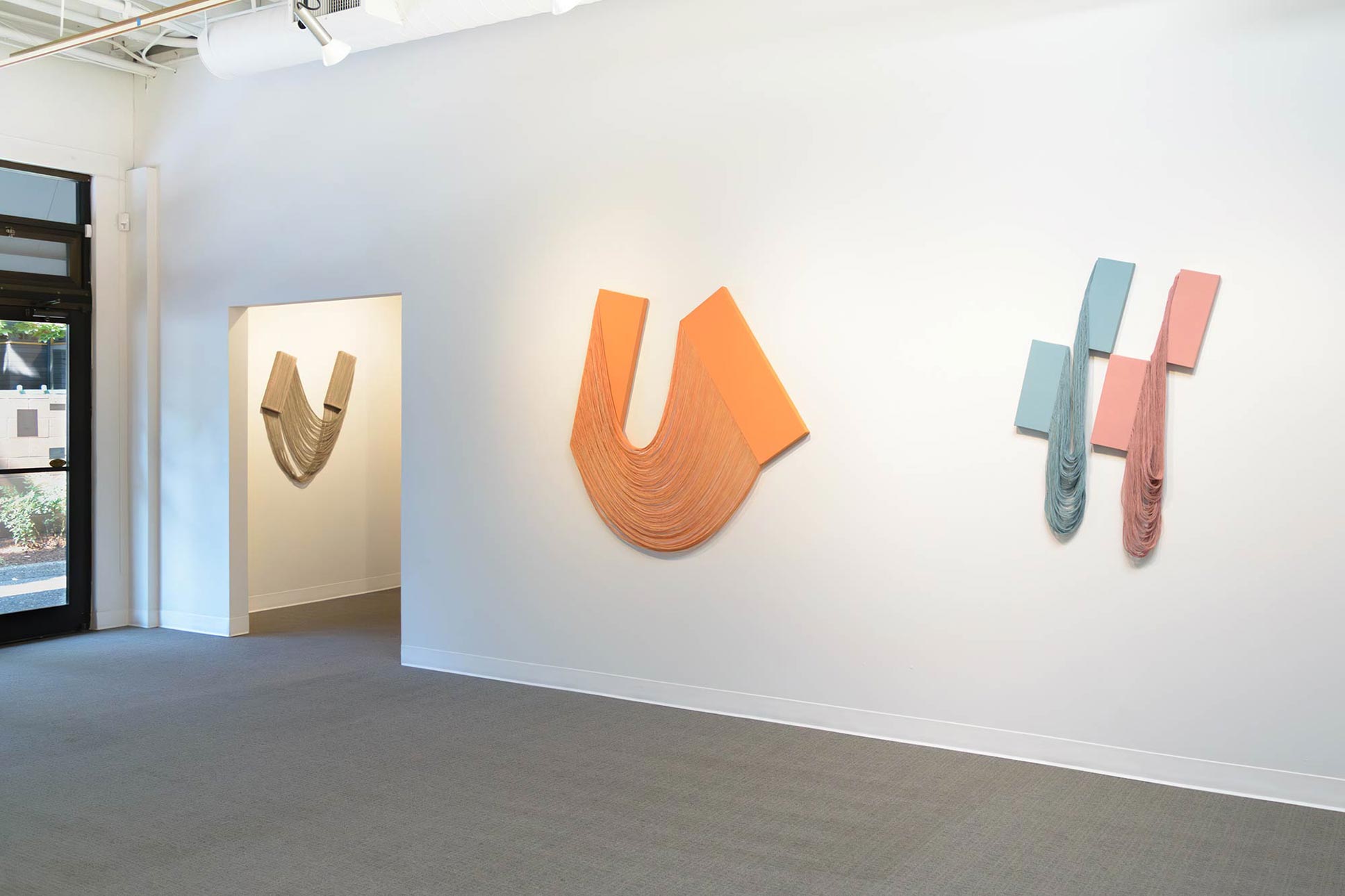
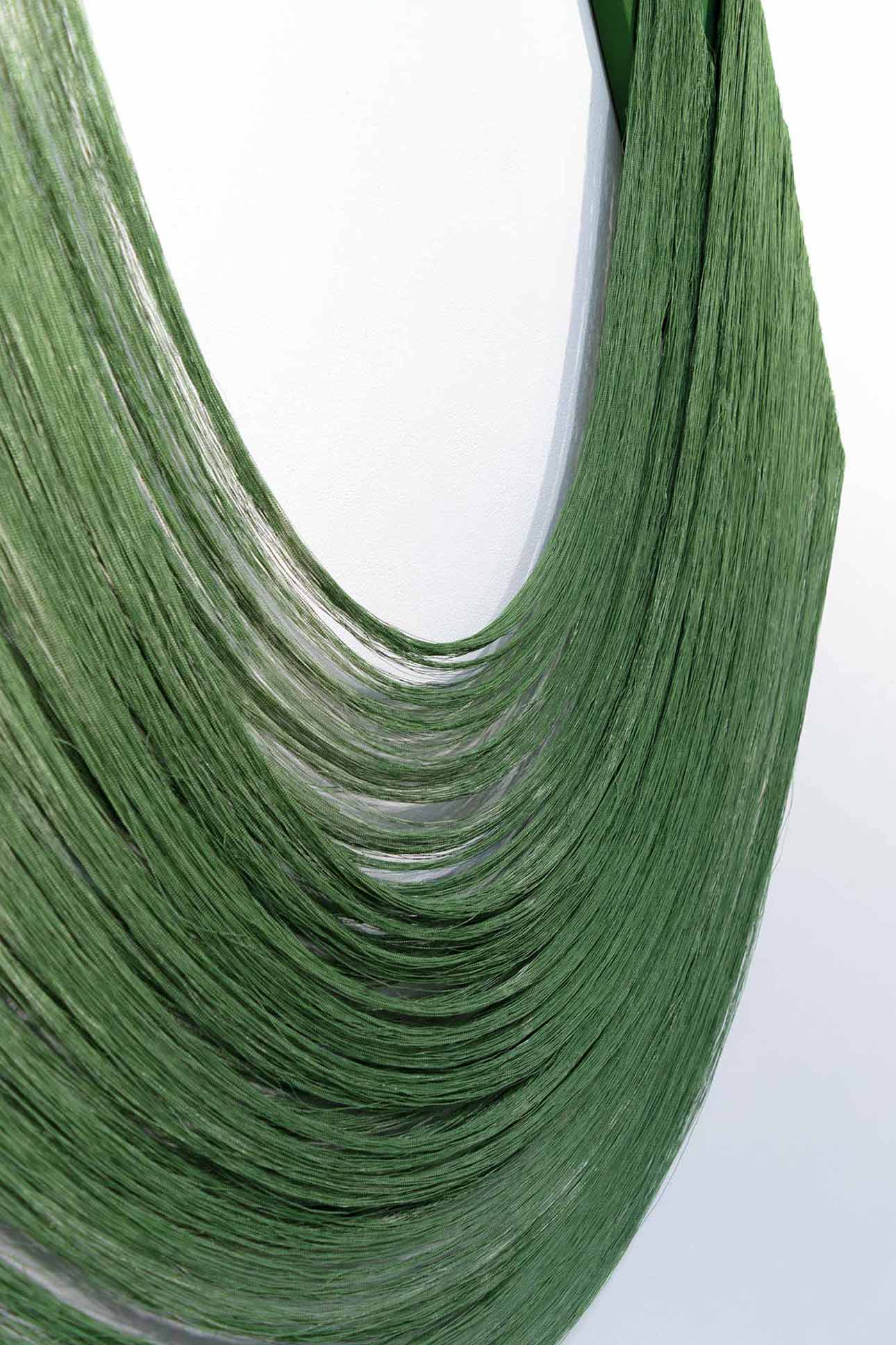
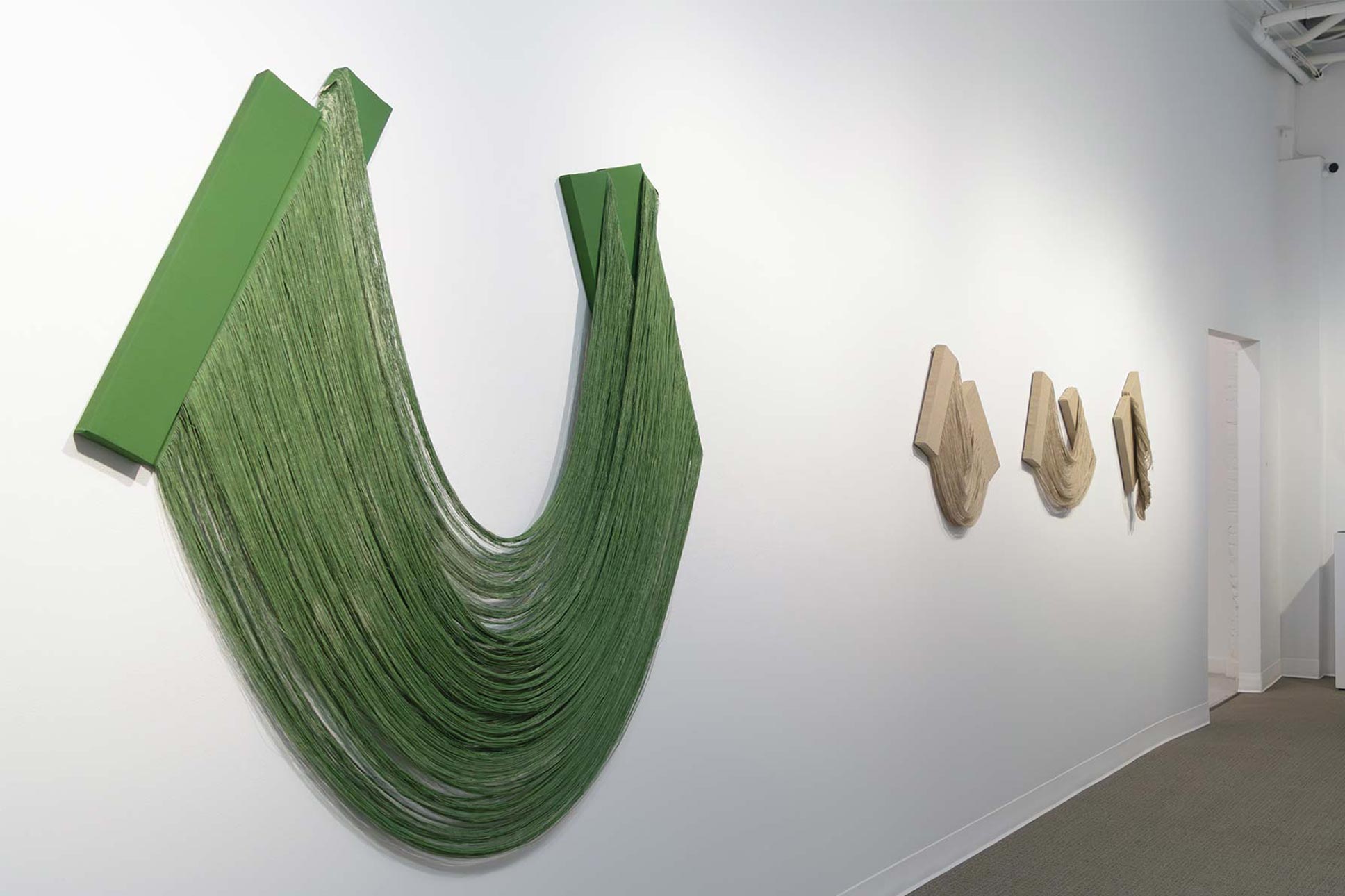
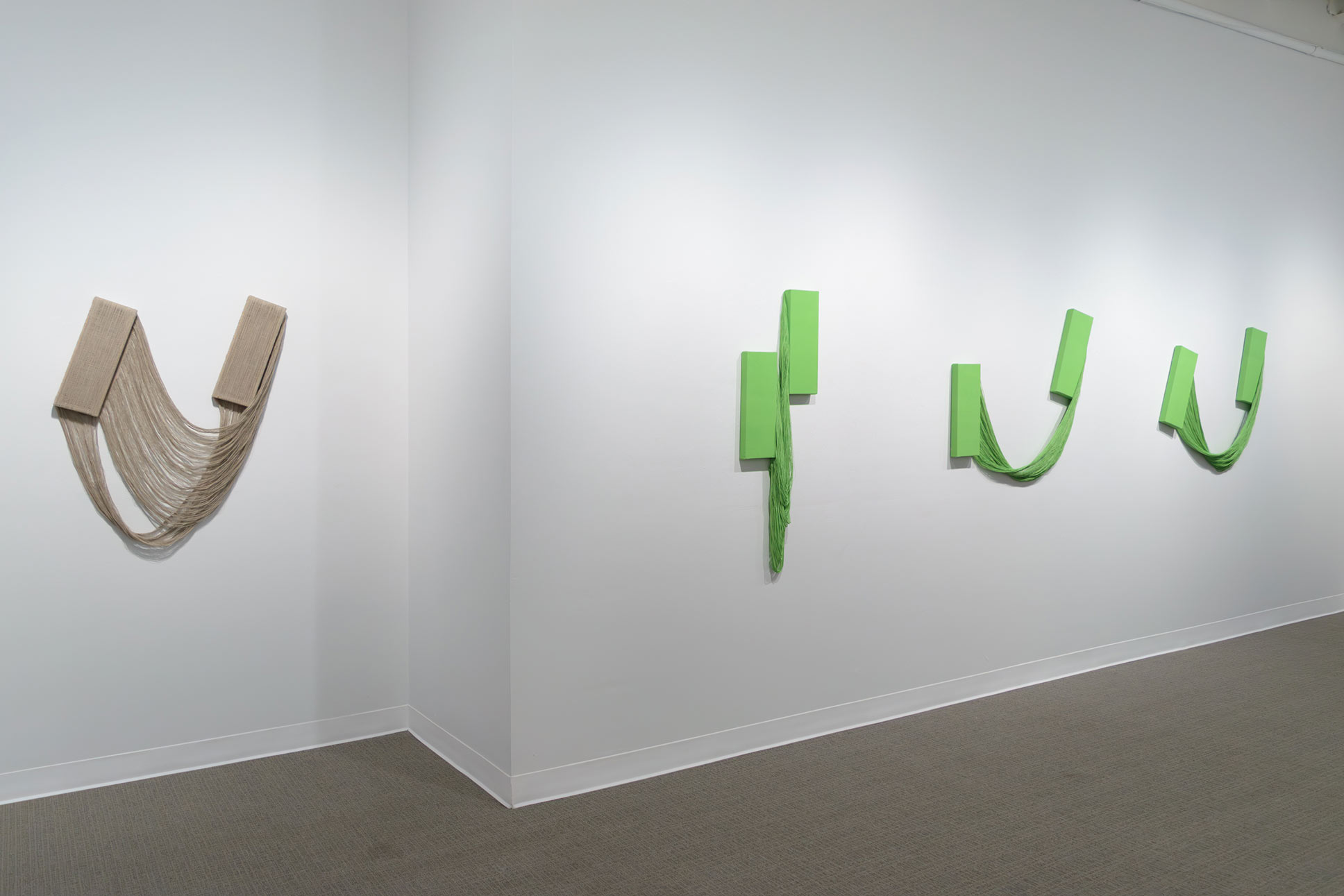
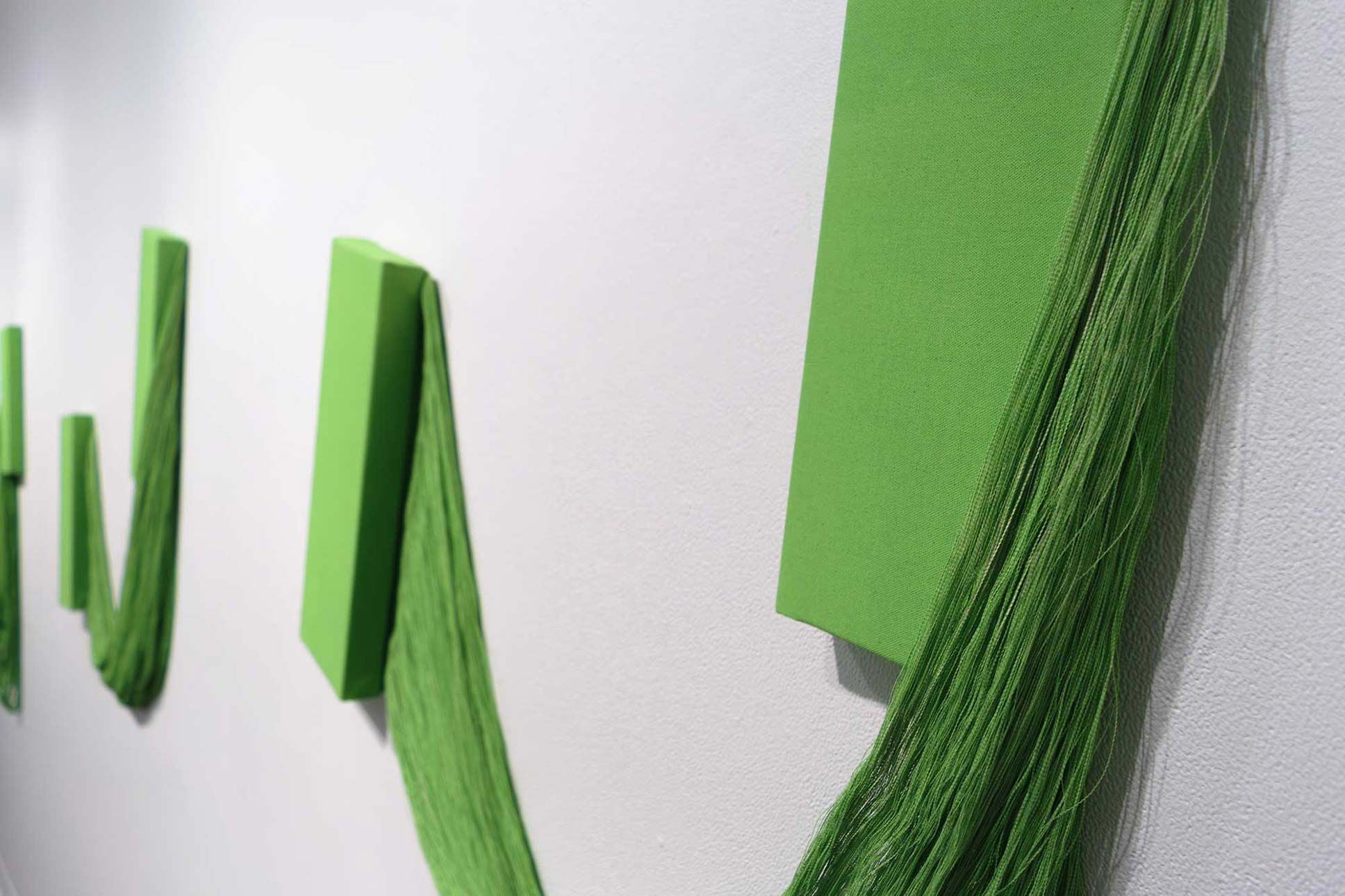
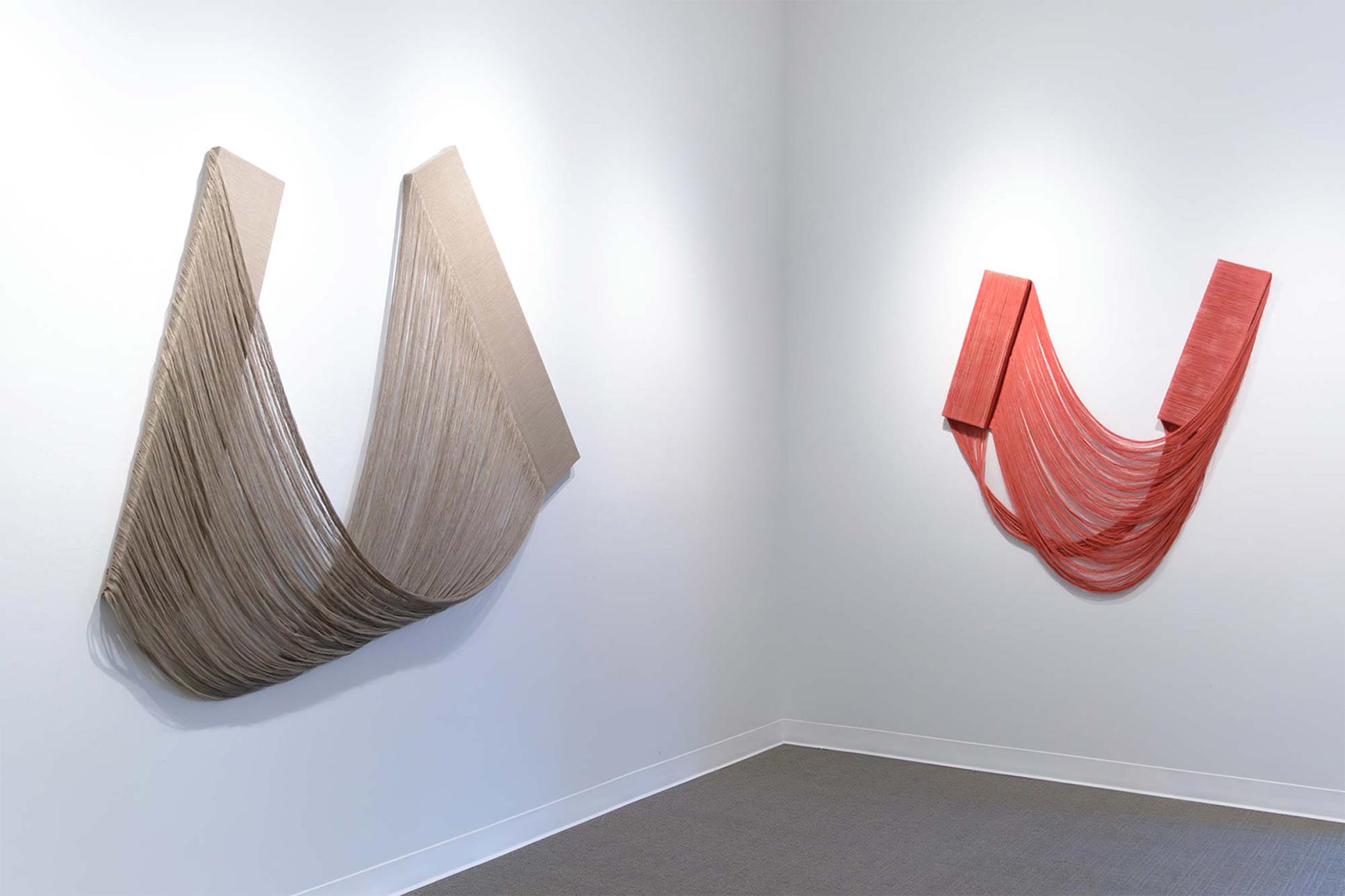
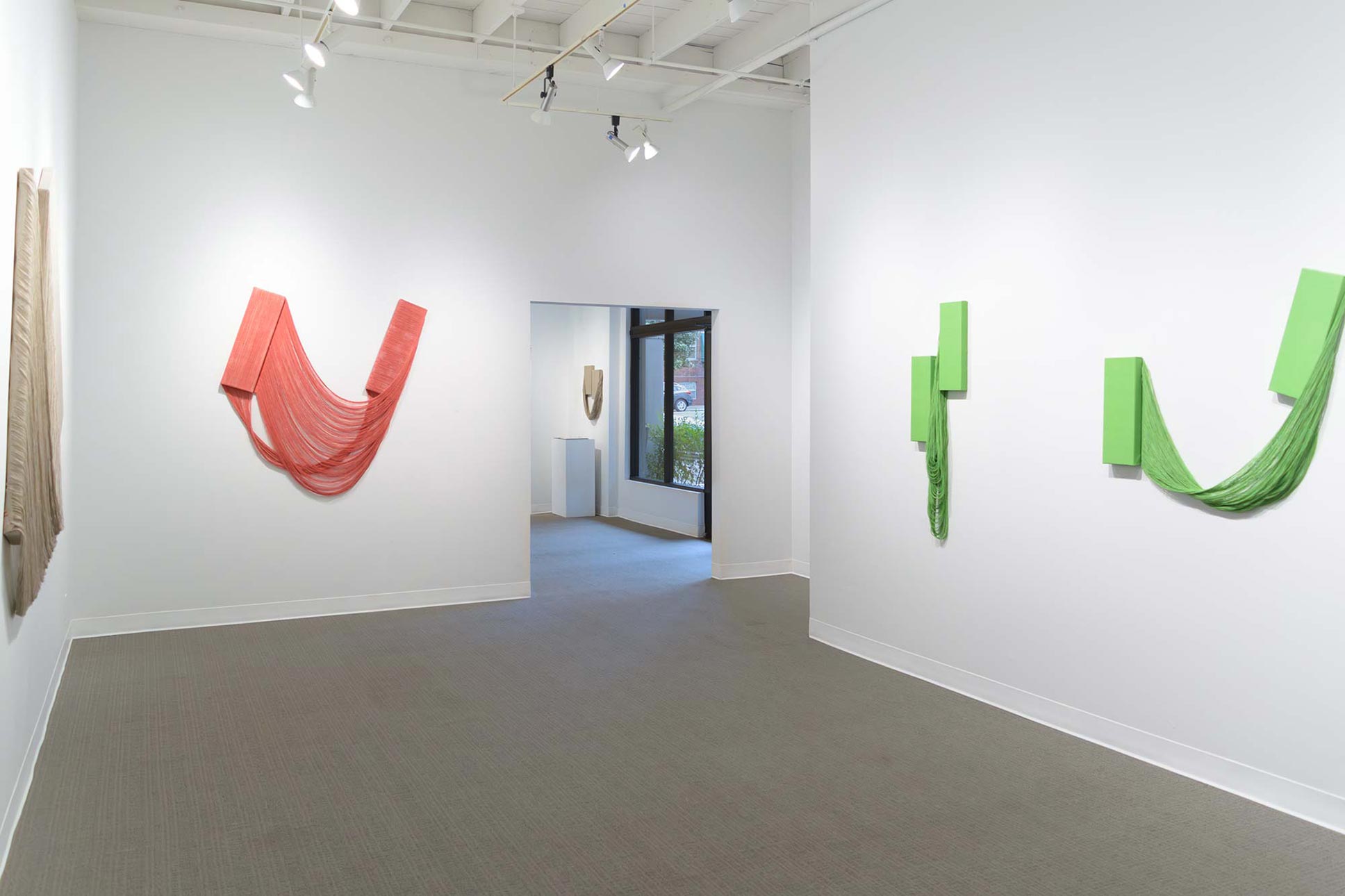
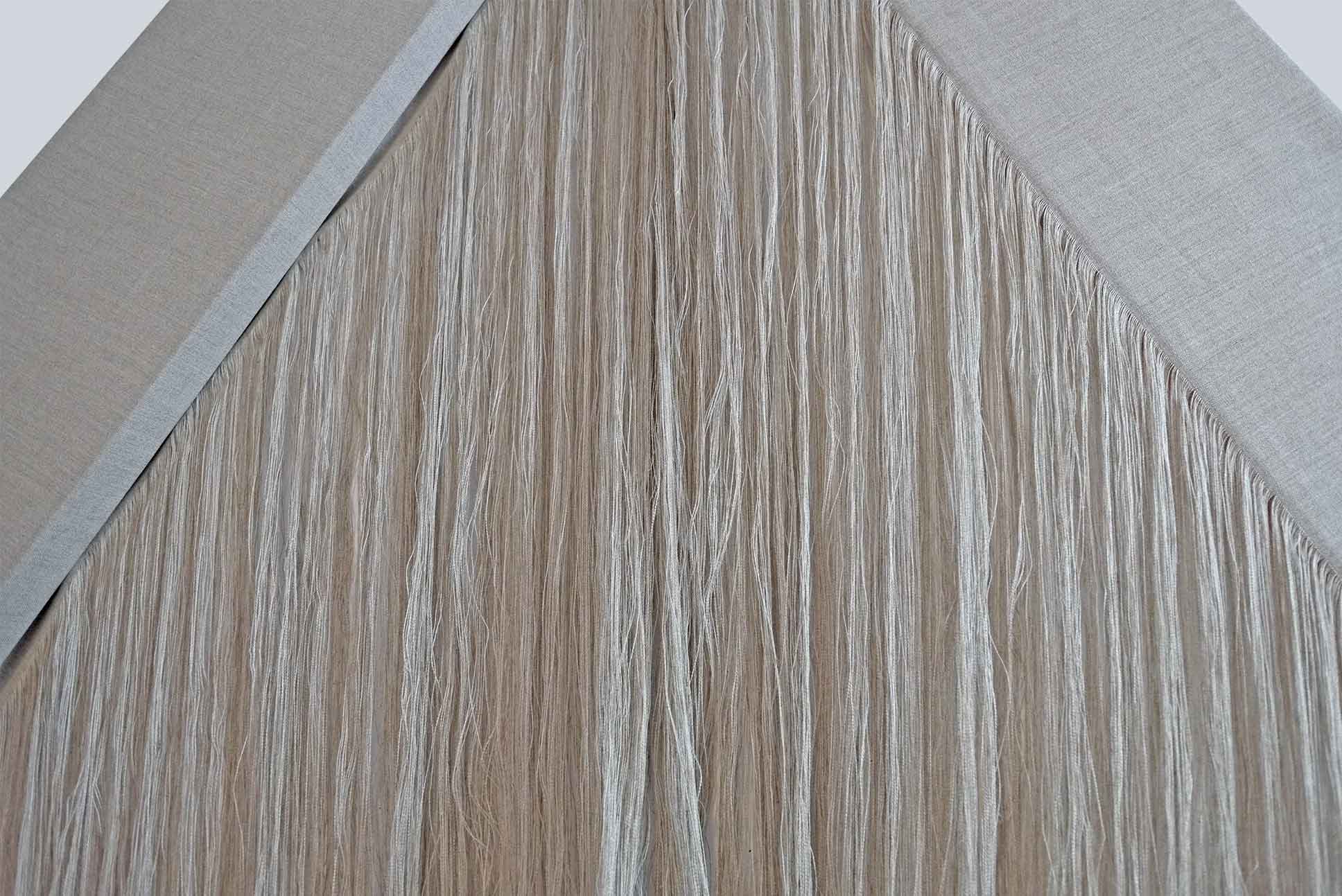
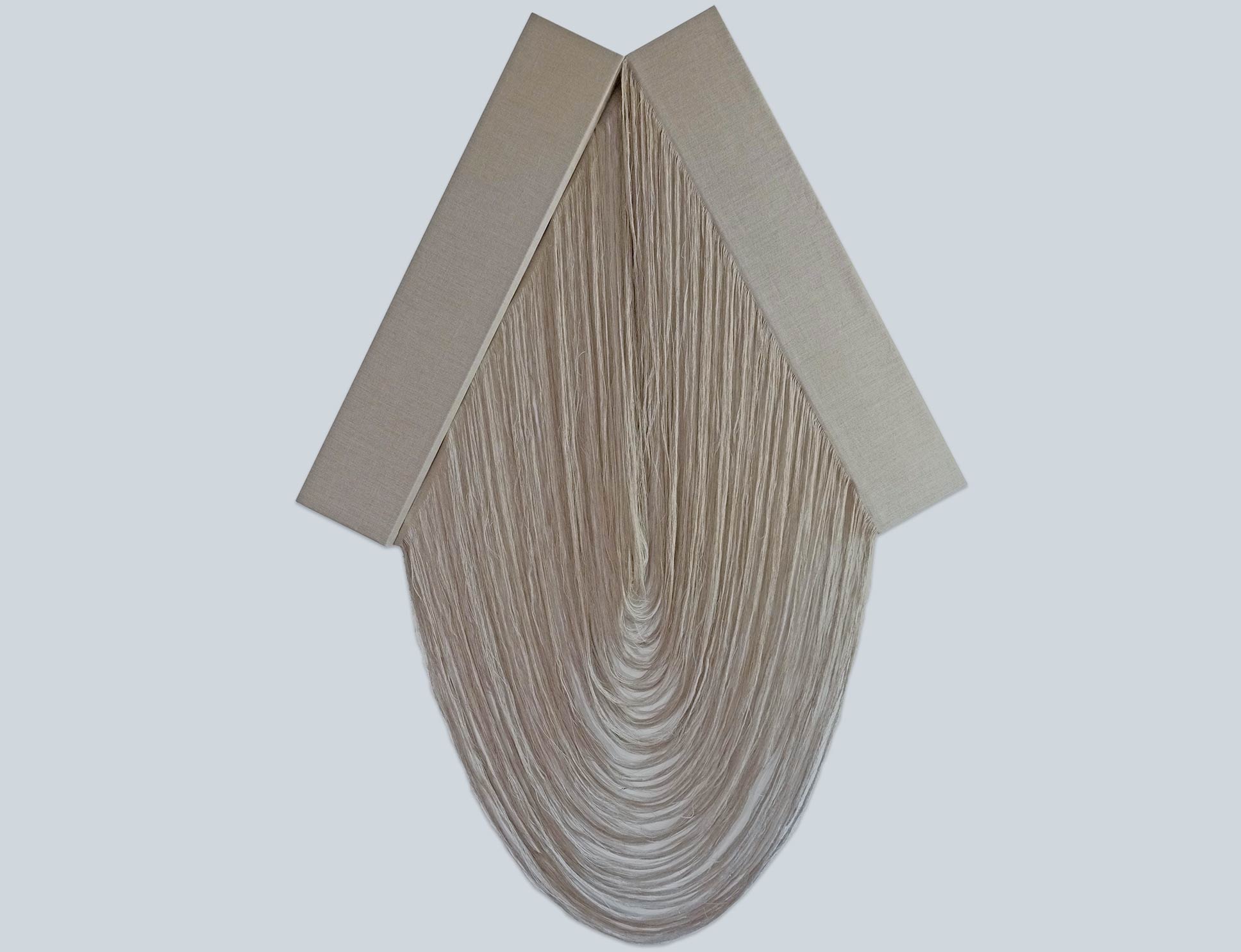

of merge, untitled
2025
graphite, partially unwoven linen canvas, wood
H84 x W60 x D3 inches
After removing 5,000 warp threads from unprimed Belgian linen canvas, this large-scale work emphasizes the natural suppleness and dynamic flow of the weft threads. A central half-turn creates a tension and release where gradually shifting density and color tones merge, expressing the work's inherent materiality and movement.
2025
graphite, partially unwoven linen canvas, wood
H84 x W60 x D3 inches
After removing 5,000 warp threads from unprimed Belgian linen canvas, this large-scale work emphasizes the natural suppleness and dynamic flow of the weft threads. A central half-turn creates a tension and release where gradually shifting density and color tones merge, expressing the work's inherent materiality and movement.
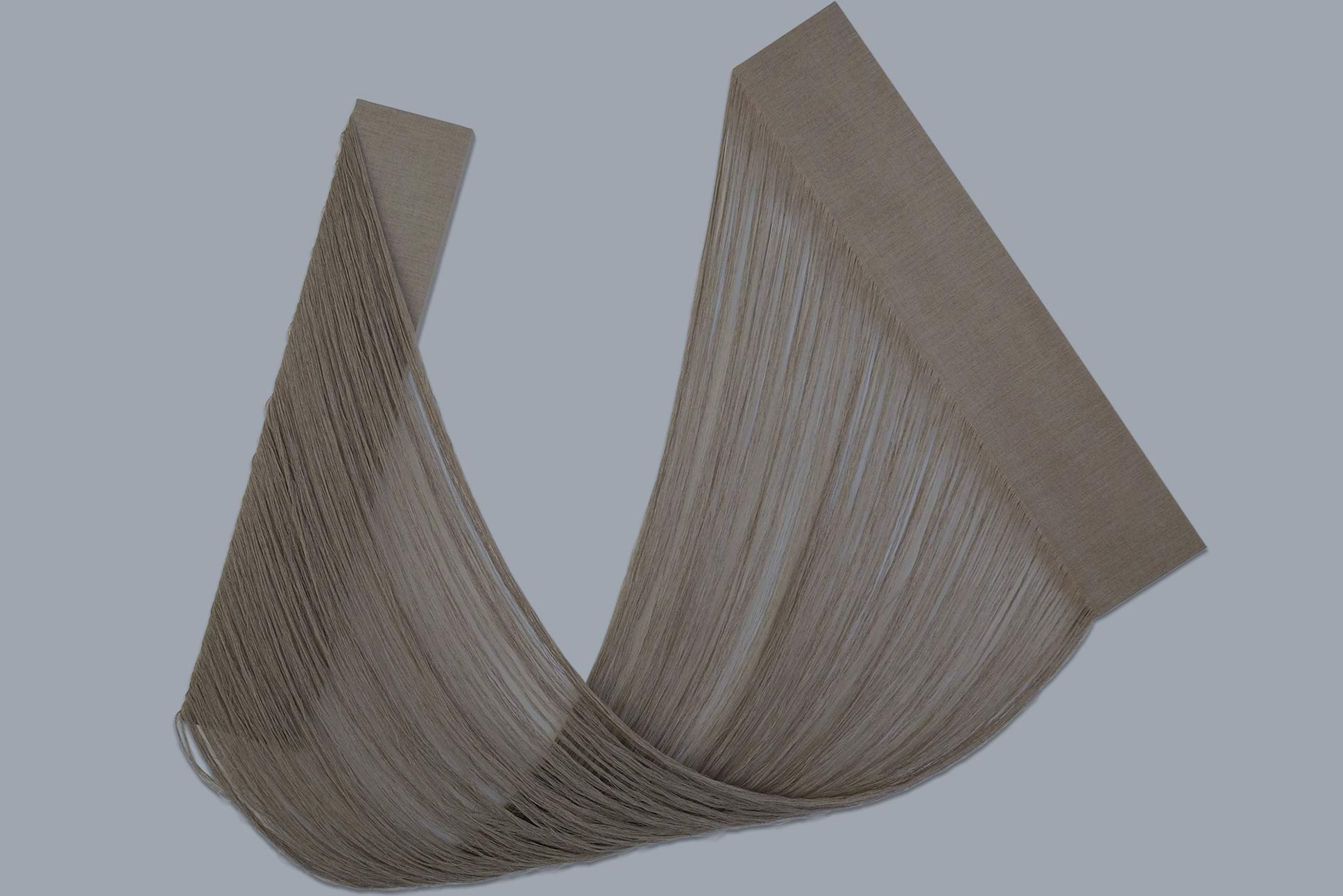
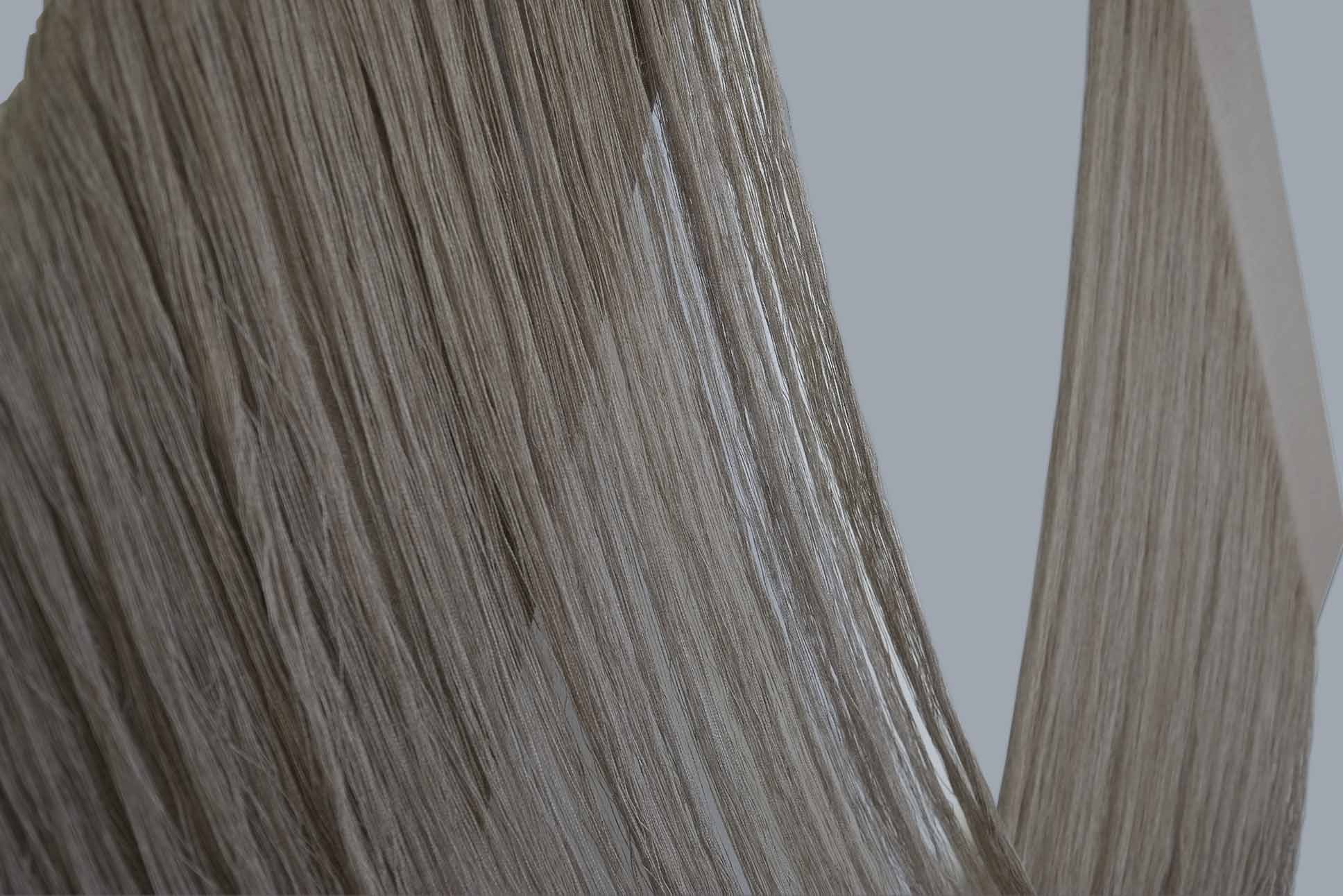
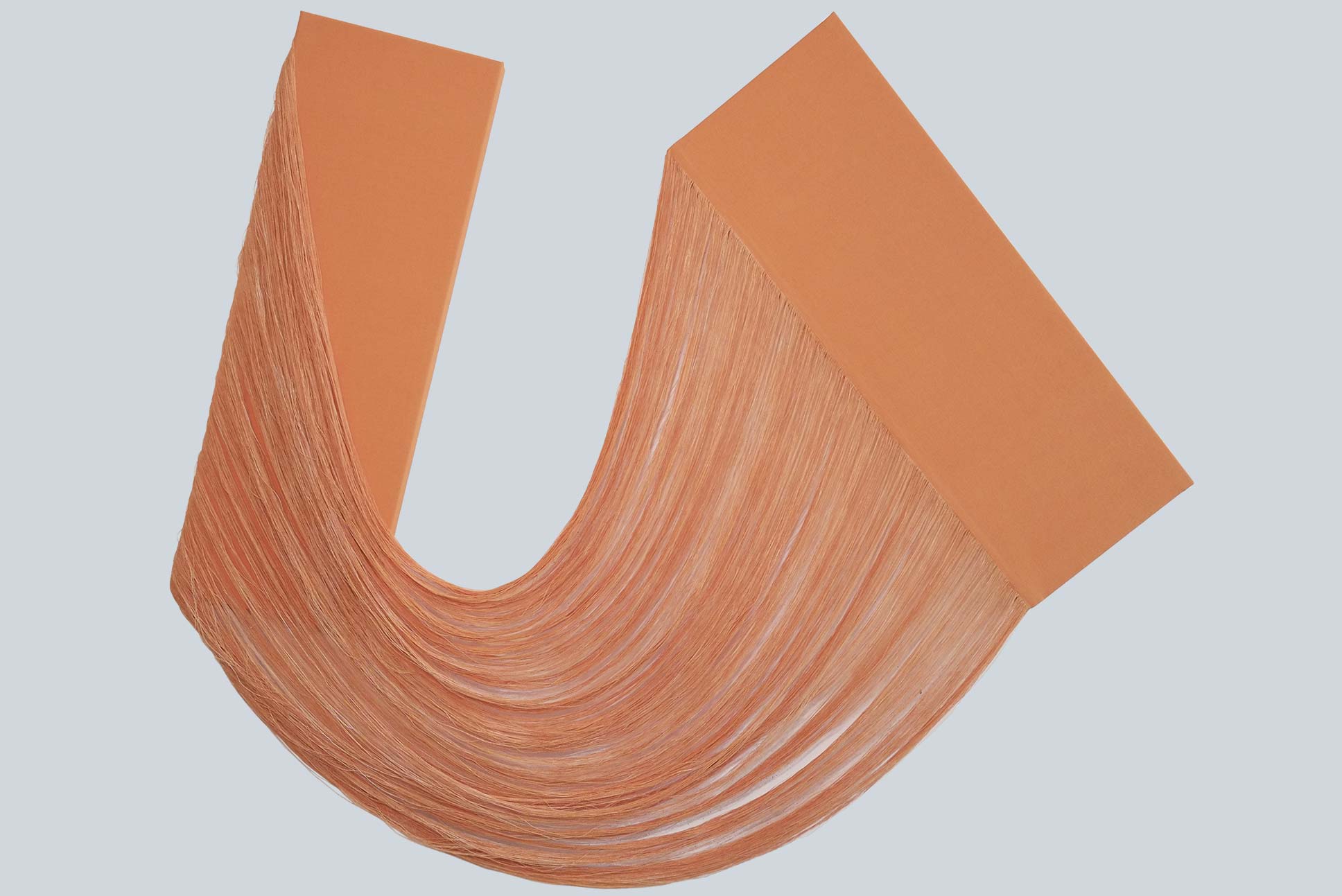
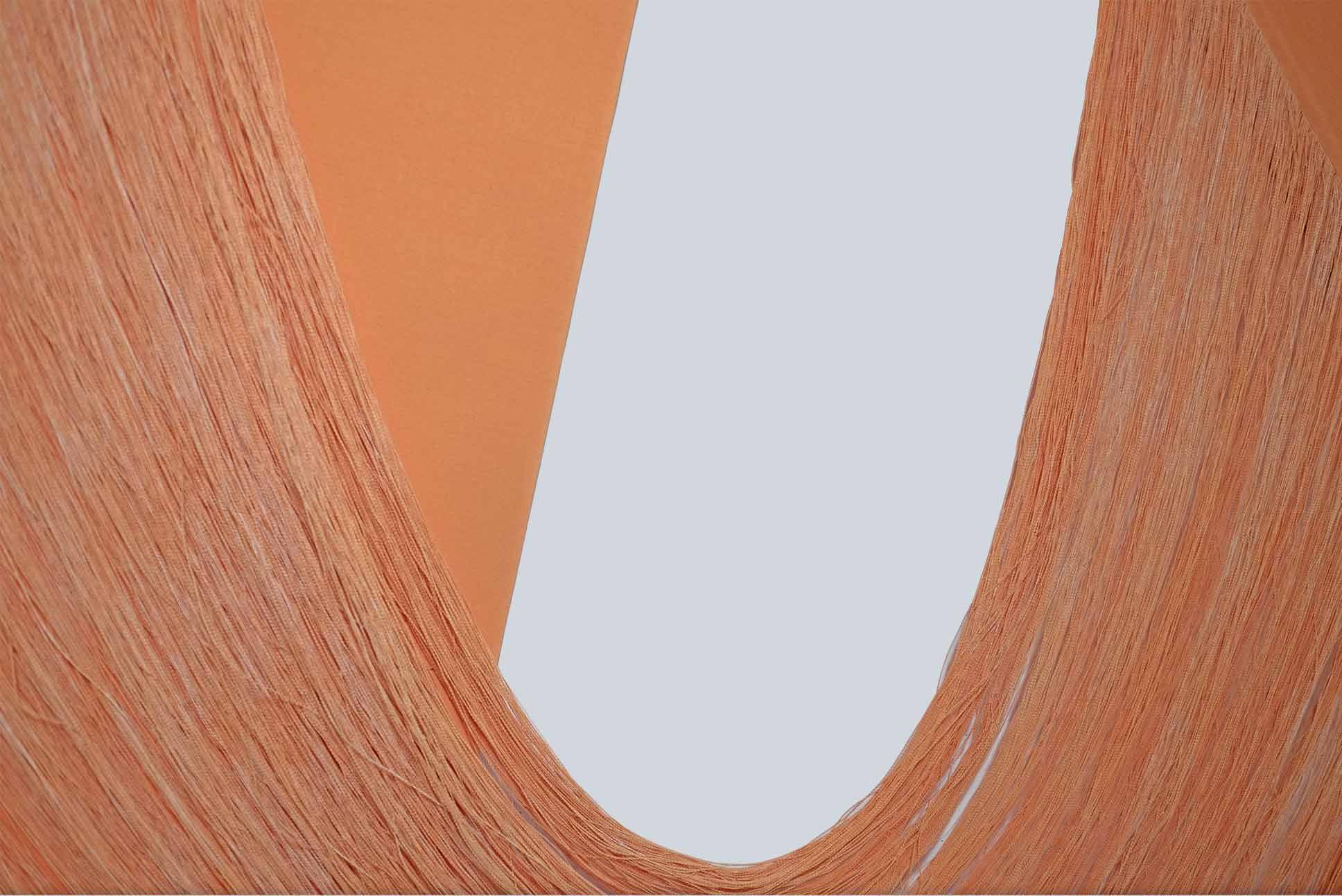
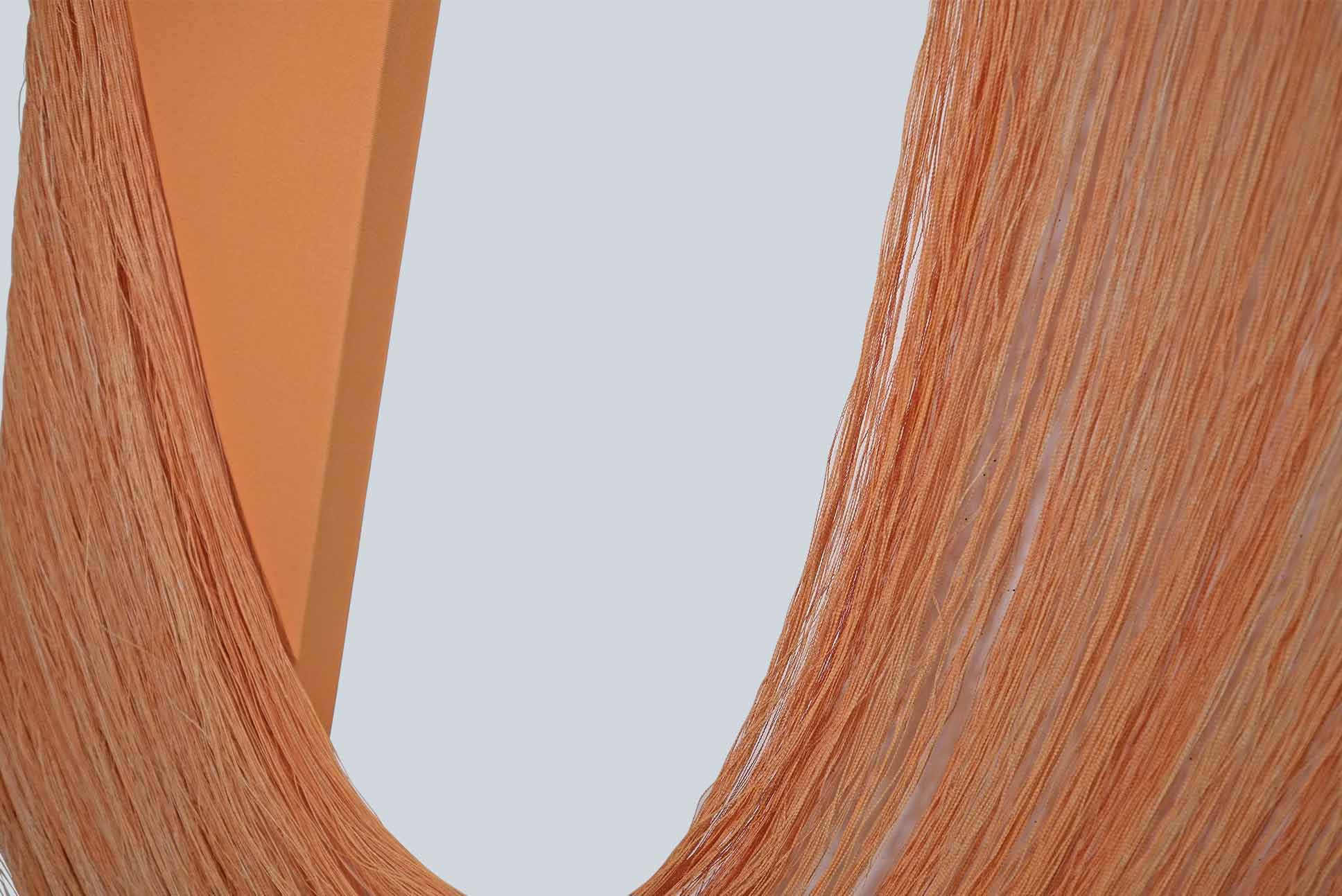
balance of a fraction, untitled
2025
acrylic, graphite, partially unwoven canvas, wood
H47 x W55 x D3 inches
This single wall hanging piece is engages viewers in a dialogue about the nature of painting and its physical boundaries. The process begins with the canvas, meticulously painted on both its front and reverse sides. This dual- sided application of color sets the stage for a deconstruction that challenges the canvas's traditional flat surface. Through the reflective and precise act of removing thousand of warp threads by hand, a portion of the canvas's tightly woven structure is undone.
This deconstruction is a transformative event, turning a static surface into a dynamic, three-dimensional form. A key aspect of the work involves flipping a section of this now-pliant canvas to reveal its reverse side, a once-hidden surface. Simultaneously, a folded section on the frame creates a fluid bulge, a moment of sculptural relief that defies conventional flatness.
This technique intentionally blurs the lines between the "front" and "back" of the work, prompting the viewer to re- examine perceptions of surface and space. The interplay of color, time, and composition becomes a central theme. The colors from both sides of the canvas and the intricate layering create a visual conversation.
2025
acrylic, graphite, partially unwoven canvas, wood
H47 x W55 x D3 inches
This single wall hanging piece is engages viewers in a dialogue about the nature of painting and its physical boundaries. The process begins with the canvas, meticulously painted on both its front and reverse sides. This dual- sided application of color sets the stage for a deconstruction that challenges the canvas's traditional flat surface. Through the reflective and precise act of removing thousand of warp threads by hand, a portion of the canvas's tightly woven structure is undone.
This deconstruction is a transformative event, turning a static surface into a dynamic, three-dimensional form. A key aspect of the work involves flipping a section of this now-pliant canvas to reveal its reverse side, a once-hidden surface. Simultaneously, a folded section on the frame creates a fluid bulge, a moment of sculptural relief that defies conventional flatness.
This technique intentionally blurs the lines between the "front" and "back" of the work, prompting the viewer to re- examine perceptions of surface and space. The interplay of color, time, and composition becomes a central theme. The colors from both sides of the canvas and the intricate layering create a visual conversation.

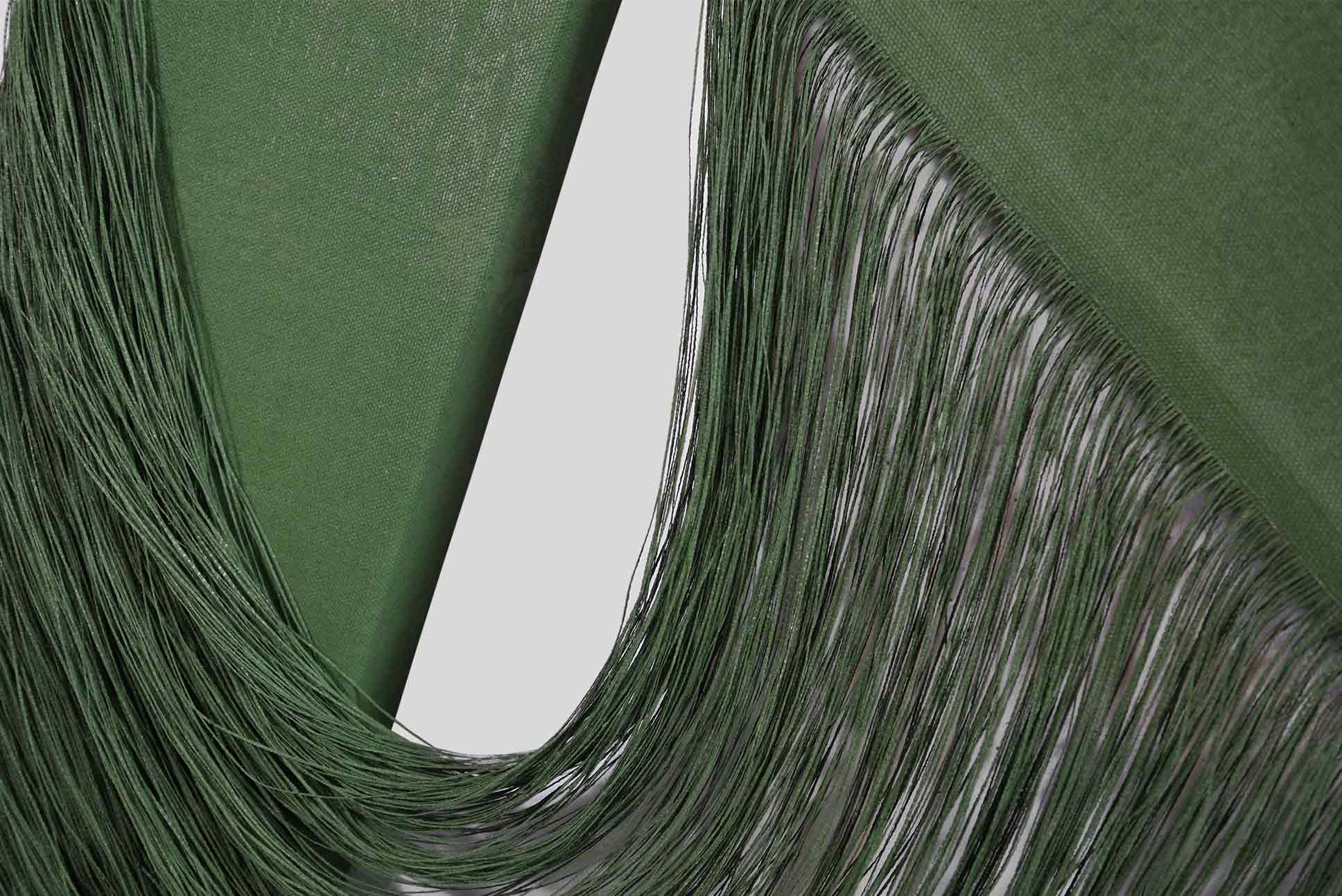
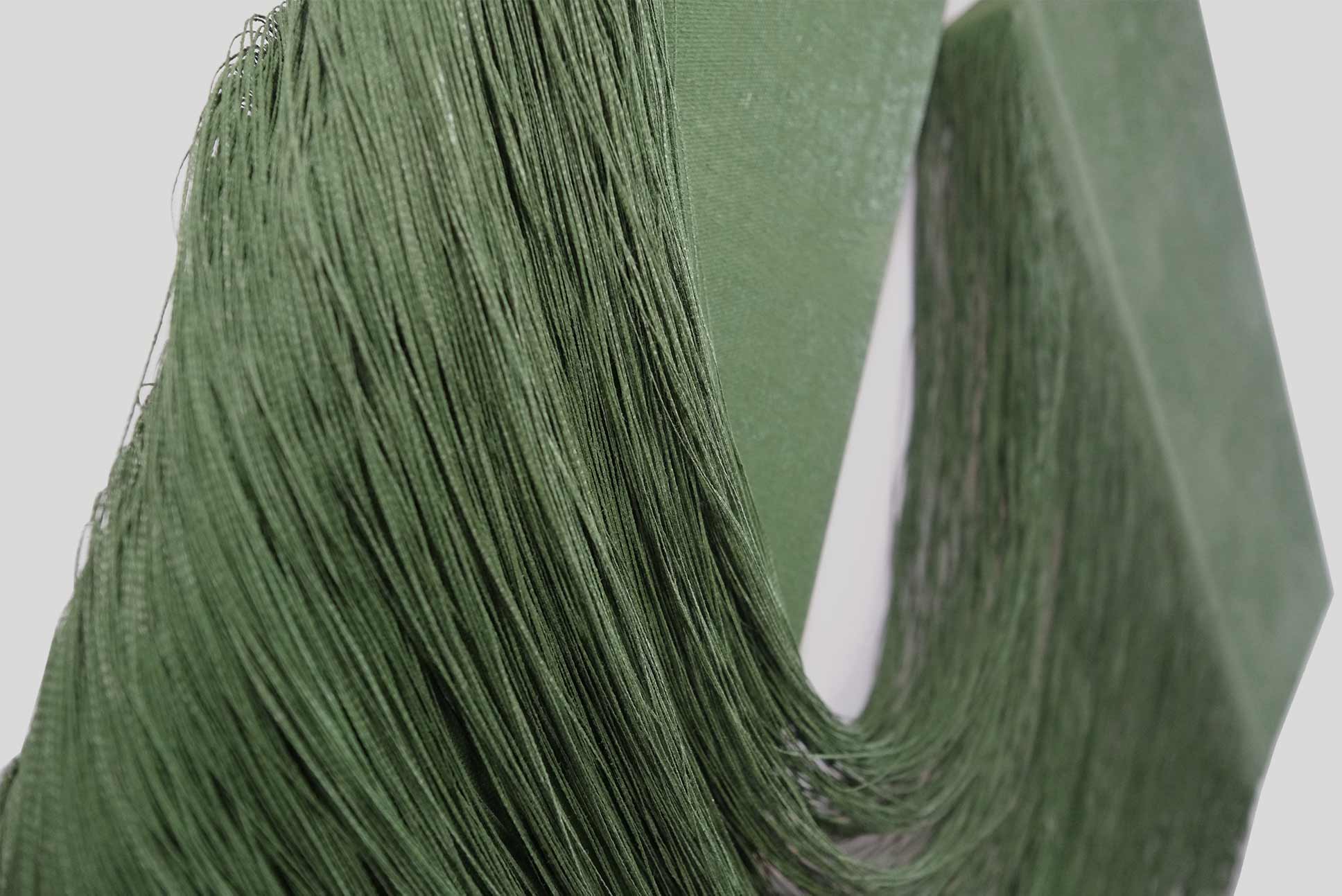
color of the primeval forest, untitled
2025
acrylic, graphite, partially unwoven canvas, wood
H25 x W28 x D4 inches
This parallel two-part series explores the duality of front and back. The canvas is wrapped around, exposing the reverse folds, with the exception of the leftmost frame. The intentional brushwork and overlapping central weft threads introduce a subtle misalignment, challenging perceptions of the surface's integrity and boundaries.
2025
acrylic, graphite, partially unwoven canvas, wood
H25 x W28 x D4 inches
This parallel two-part series explores the duality of front and back. The canvas is wrapped around, exposing the reverse folds, with the exception of the leftmost frame. The intentional brushwork and overlapping central weft threads introduce a subtle misalignment, challenging perceptions of the surface's integrity and boundaries.
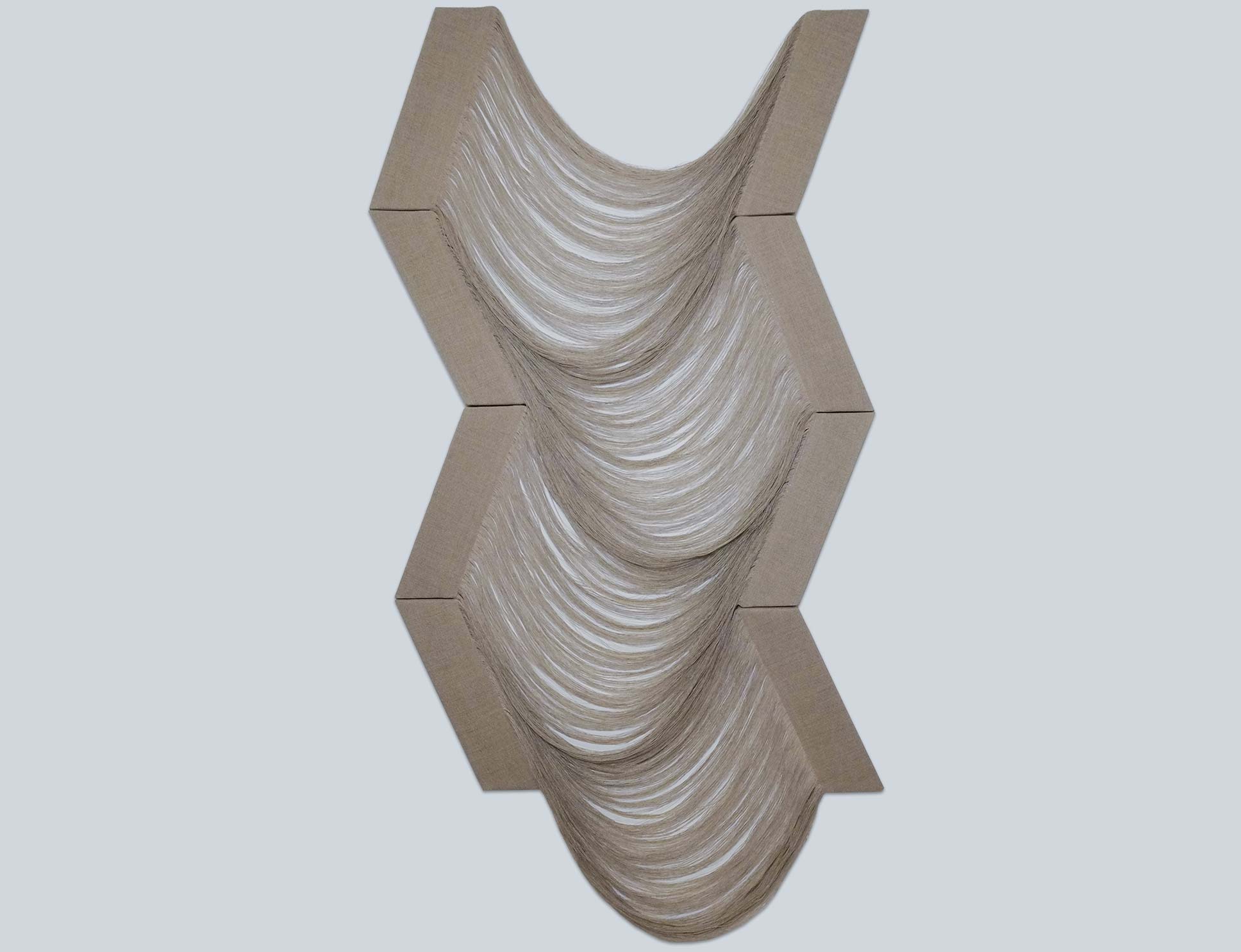
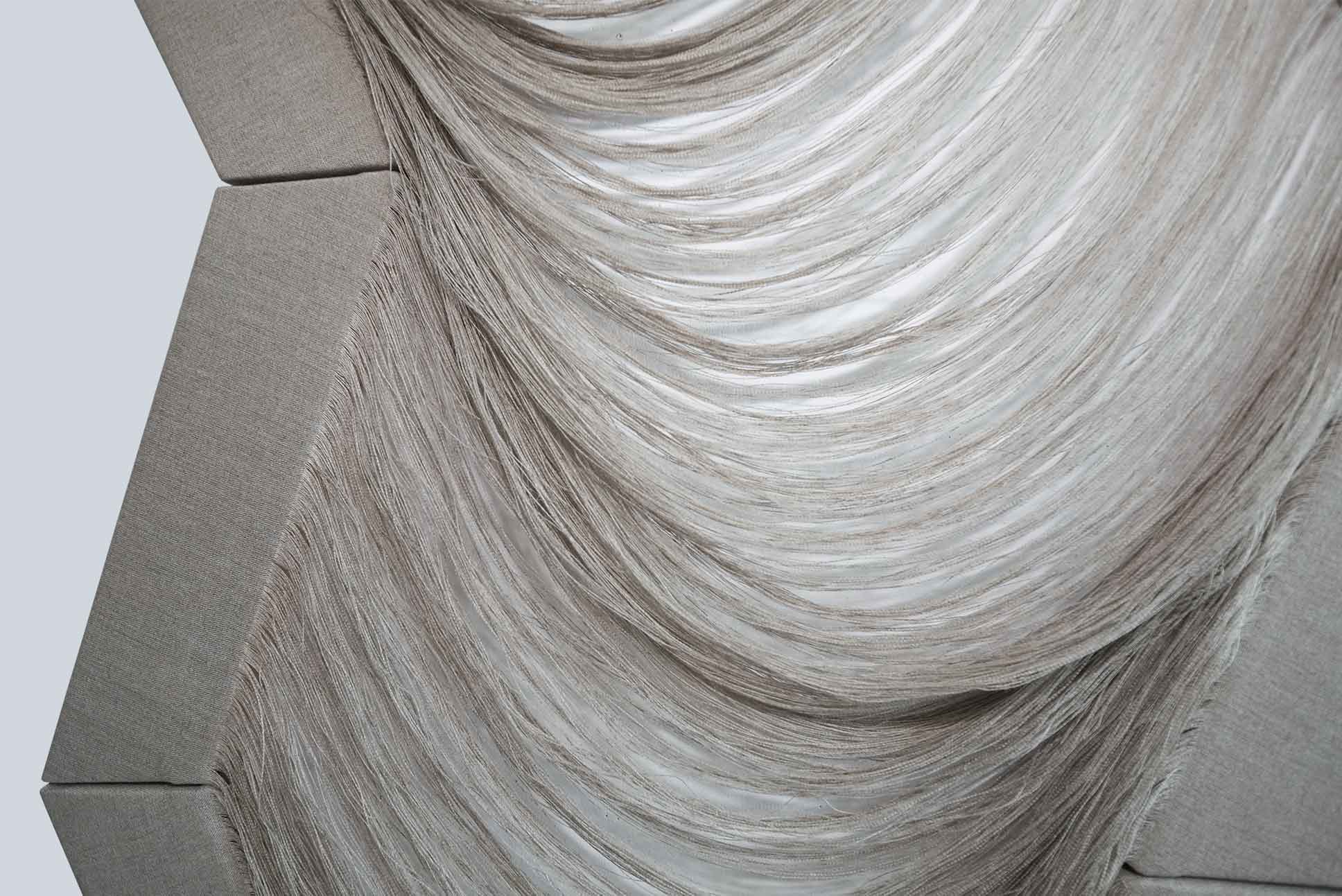
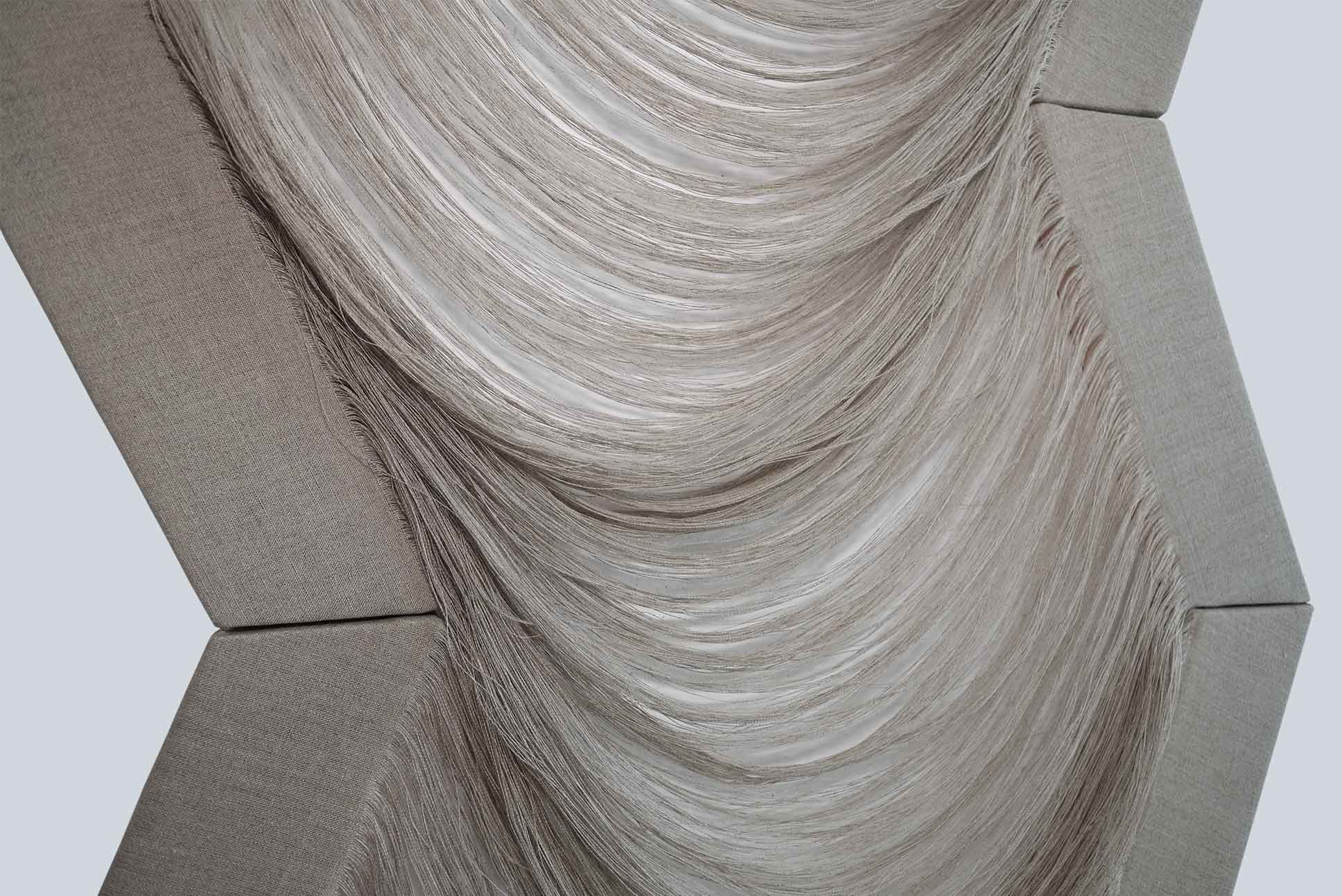
vortex, untitled
2025
graphite, partially unwoven linen canvas, wood
H67 x W36 x D3 inches
This artwork creates a dynamic dialogue between art and craft by meticulously unraveling thousands of threads from unprimed linen canvas. This introspective, deconstructive process transforms the material's two-dimensional plane into a sculptural three-dimensional form, redefining its potential. The final tactile object, which captures the immense creative time and effort, blurs the boundaries between painting and sculpture. For instance, in one four-part wall hanging, over 4,000 warp threads are painstakingly removed by hand. The resulting elegant weft bundles are layered horizontally to form a dynamic, vortex-like pattern, with main structures inclined at 22 degrees to subtly alter density. Alternating bundle positions create a flowing, textured finish and a uniquely ambiguous boundary, prompting a contemplation on continuous change and the transformative power of both creation and undoing.
2025
graphite, partially unwoven linen canvas, wood
H67 x W36 x D3 inches
This artwork creates a dynamic dialogue between art and craft by meticulously unraveling thousands of threads from unprimed linen canvas. This introspective, deconstructive process transforms the material's two-dimensional plane into a sculptural three-dimensional form, redefining its potential. The final tactile object, which captures the immense creative time and effort, blurs the boundaries between painting and sculpture. For instance, in one four-part wall hanging, over 4,000 warp threads are painstakingly removed by hand. The resulting elegant weft bundles are layered horizontally to form a dynamic, vortex-like pattern, with main structures inclined at 22 degrees to subtly alter density. Alternating bundle positions create a flowing, textured finish and a uniquely ambiguous boundary, prompting a contemplation on continuous change and the transformative power of both creation and undoing.
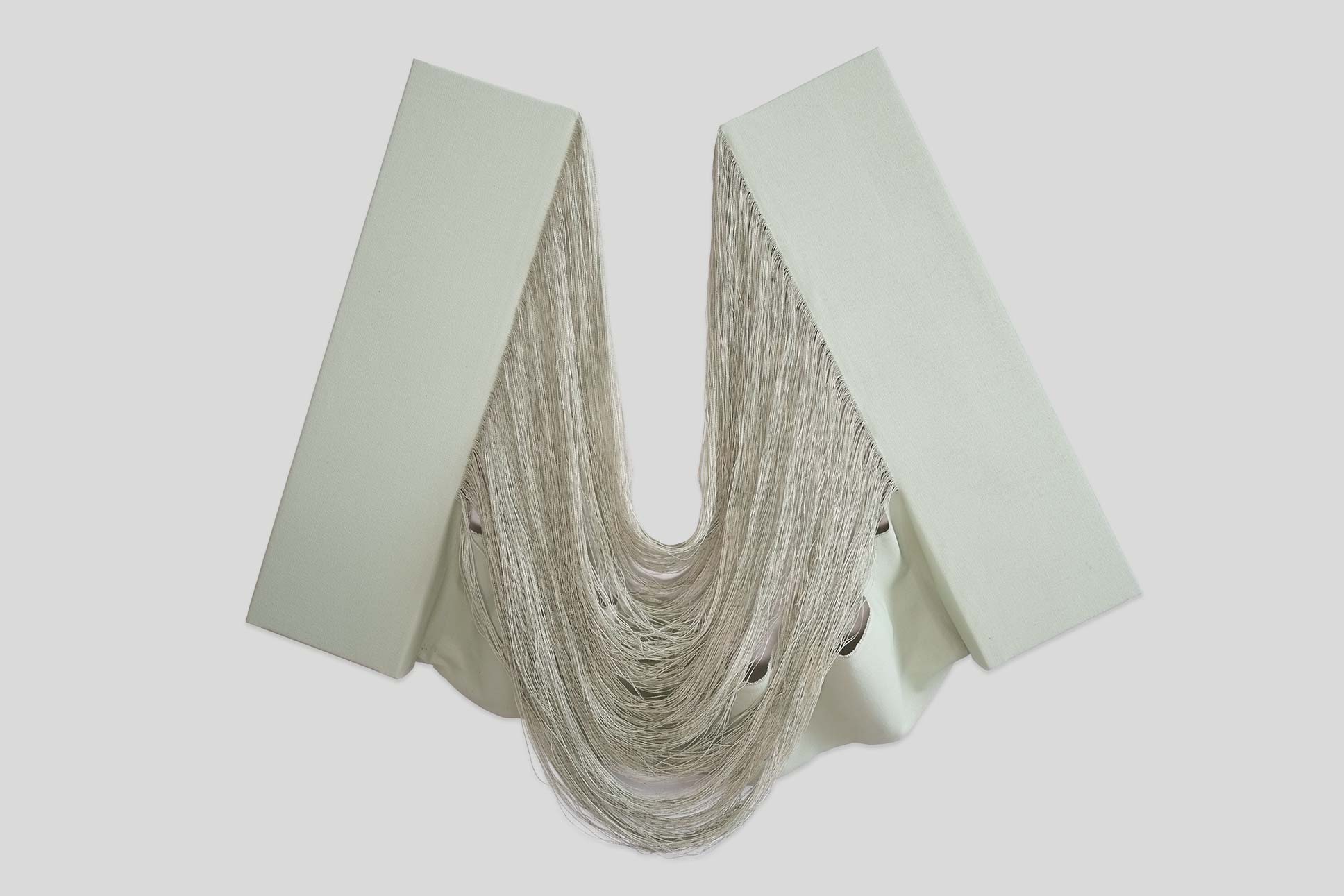
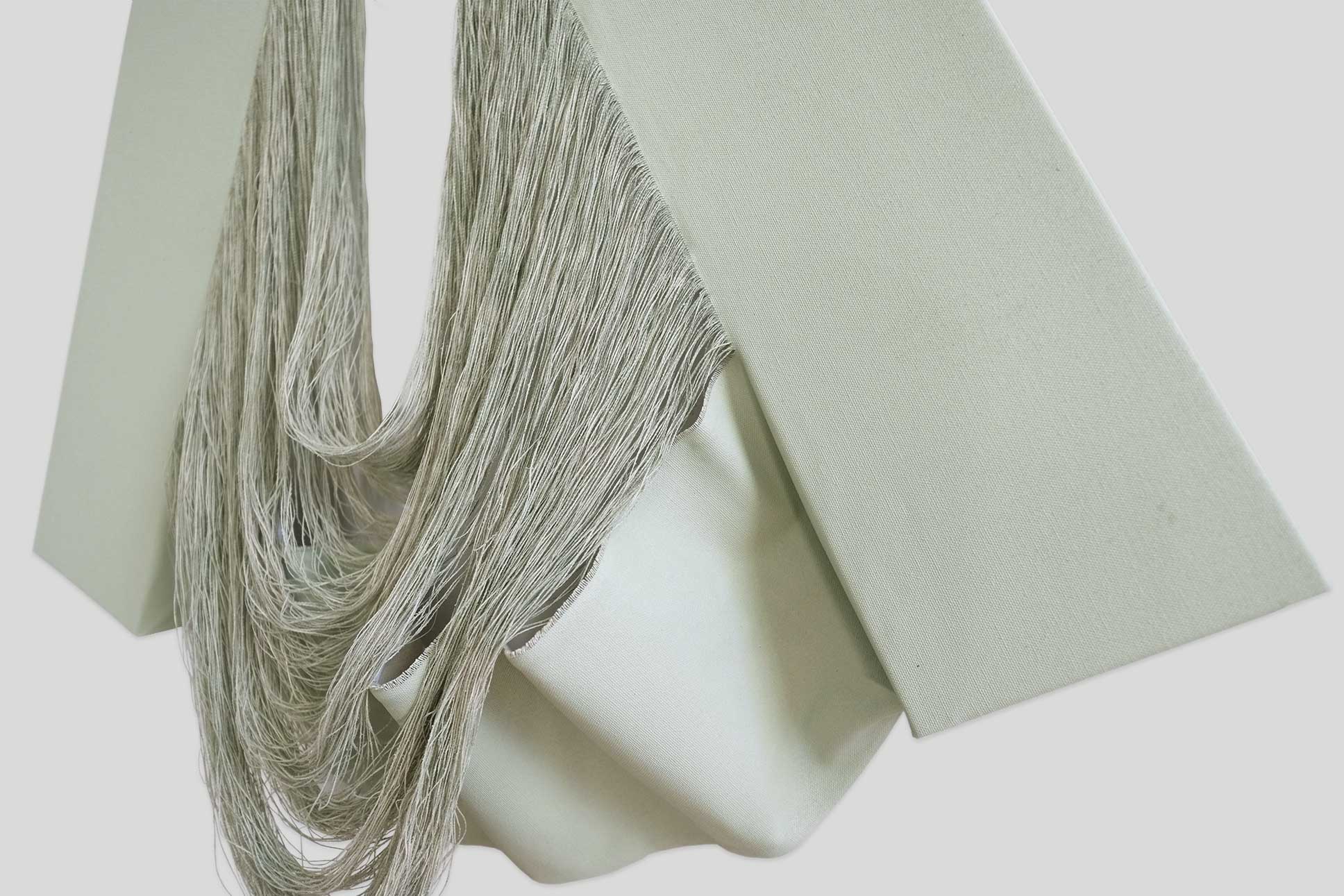
Untitled
2025
acrylic, graphite, partially unwoven canvas, wood
H28 x W32 x D6 inches
2025
acrylic, graphite, partially unwoven canvas, wood
H28 x W32 x D6 inches


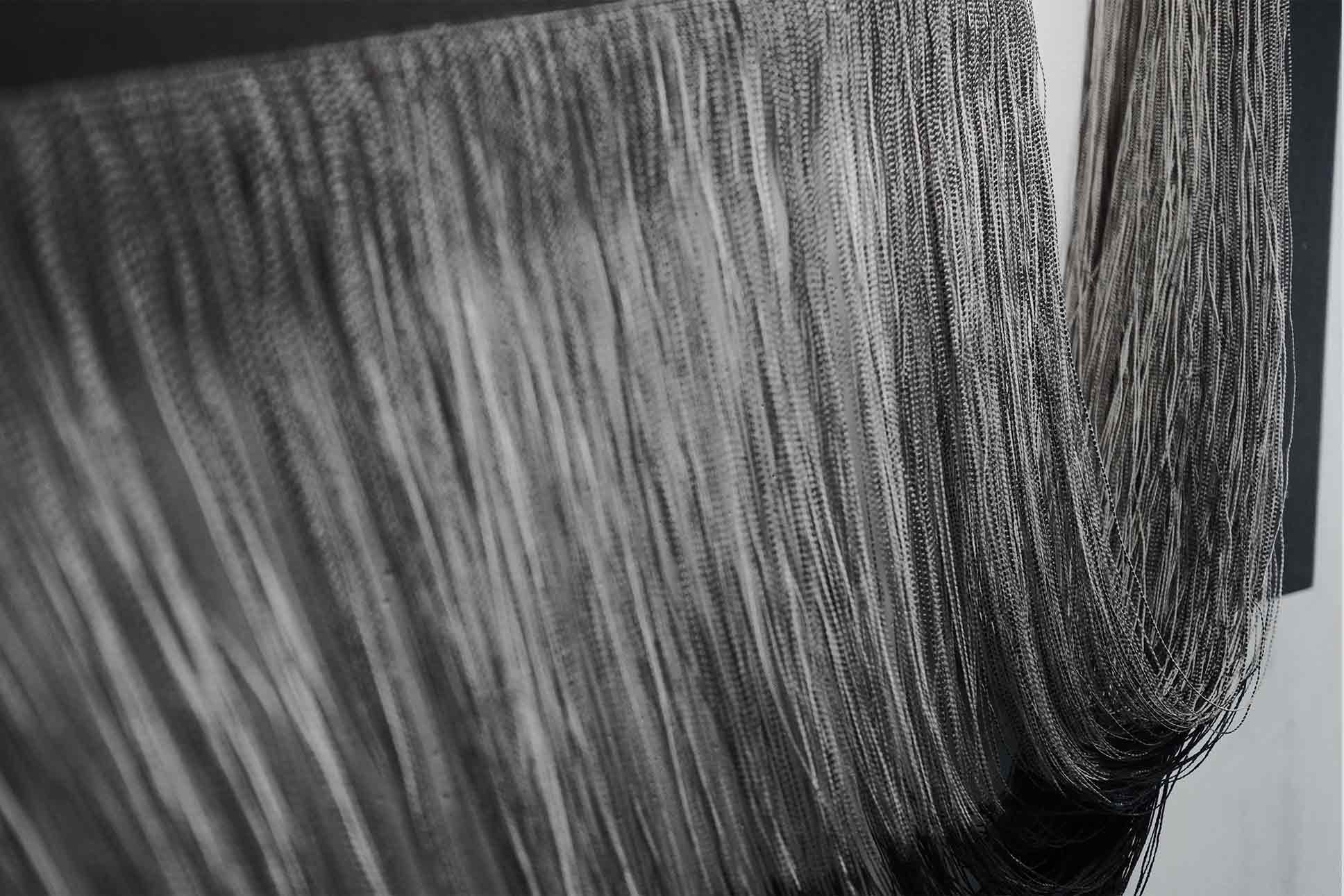
Untitled
2024
acrylic, graphite, partially unwoven canvas, wood
H48 x W48 x D4 inches
A CMY mixture color is applied to the entire canvas. A highly detailed, hands-on process follows: all warp threads are systematically removed from the central section, leaving a horizontal field of deconstructed weft threads. A new area within this bundle is defined for a second application of the same color, this time applied from the reverse side to solidify the threads. Once cured, the threads undergo a second manual separation and re-bundling, preparing them for the final display. The resulting object possesses a fluid form, generating countless potential surfaces. The weft bundle's drape length defines a kinetic boundary; adjusting the angle or distance of the end frames yields an infinite possibility of shapes. This inherent variability is contained by an underlying awareness of implicit rules and aesthetic balances - common patterns we subconsciously favor. The piece exploits this tension by restricting the potential irregularity through the imposition of a singular, drawn line. This line initially presents a comfortable alignment, but is deliberately subverted by a subsequent action that contradicts the intended order, creating a dynamic visual friction.
2024
acrylic, graphite, partially unwoven canvas, wood
H48 x W48 x D4 inches
A CMY mixture color is applied to the entire canvas. A highly detailed, hands-on process follows: all warp threads are systematically removed from the central section, leaving a horizontal field of deconstructed weft threads. A new area within this bundle is defined for a second application of the same color, this time applied from the reverse side to solidify the threads. Once cured, the threads undergo a second manual separation and re-bundling, preparing them for the final display. The resulting object possesses a fluid form, generating countless potential surfaces. The weft bundle's drape length defines a kinetic boundary; adjusting the angle or distance of the end frames yields an infinite possibility of shapes. This inherent variability is contained by an underlying awareness of implicit rules and aesthetic balances - common patterns we subconsciously favor. The piece exploits this tension by restricting the potential irregularity through the imposition of a singular, drawn line. This line initially presents a comfortable alignment, but is deliberately subverted by a subsequent action that contradicts the intended order, creating a dynamic visual friction.

Untitled
2025
acrylic, graphite, partially unwoven canvas, wood
H60 x W54 x D2 inches
This wall-mounted piece retains the standard fan shape, but is distinguished by a unique approach to both color application and framing. Multiple layers of fluorescent yellow were applied evenly to both sides of the canvas, ensuring a consistent, vibrant glow. After this saturation, all vertical (warp) threads in the central section were meticulously removed by hand, and the remaining horizontal (weft) threads were then re-colored to maintain a uniform hue throughout the piece. The method for attaching the wooden frame is also unique: the canvas's left edge was intentionally folded back twice before being secured to the right frame. This process creates subtle, distorted pleats and irregular bulges, causing the material thickness and drape to vary between the left and right sides. Because the fluorescent color absorbs light, the resulting diffuse reflection creates a sense of fluid movement that shifts both vertically and horizontally depending on the viewer's perspective.
2025
acrylic, graphite, partially unwoven canvas, wood
H60 x W54 x D2 inches
This wall-mounted piece retains the standard fan shape, but is distinguished by a unique approach to both color application and framing. Multiple layers of fluorescent yellow were applied evenly to both sides of the canvas, ensuring a consistent, vibrant glow. After this saturation, all vertical (warp) threads in the central section were meticulously removed by hand, and the remaining horizontal (weft) threads were then re-colored to maintain a uniform hue throughout the piece. The method for attaching the wooden frame is also unique: the canvas's left edge was intentionally folded back twice before being secured to the right frame. This process creates subtle, distorted pleats and irregular bulges, causing the material thickness and drape to vary between the left and right sides. Because the fluorescent color absorbs light, the resulting diffuse reflection creates a sense of fluid movement that shifts both vertically and horizontally depending on the viewer's perspective.



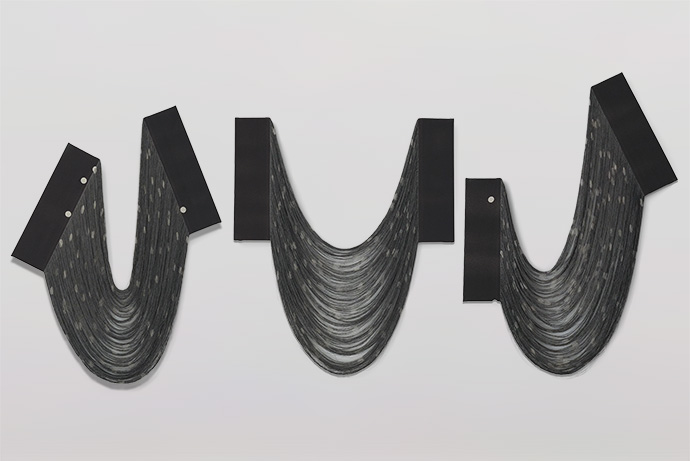
- Bottom
Untitled
2022
acrylic, graphite, partially unwoven canvas, wood
H44 x W36 x D2 inches each
*The piece on the right is displayed in the top installation view image.
MR. Salon Wall - studio e gallery
January 22nd, 2025 -
https://privateviews.artlogic.net/2/df1b1cd15d2b73e78b8cbd
To see the world through Dawna’s eyes is to look with passion, delight and a fair amount of wit. Through MR., we've had the pleasure of working together professionally for 20 years and I'm now lucky to call her my friend.
Being in the furniture business for so long now through all the different iterations of MR., I have always been mindful that we sell furnishings and functional objects (well, and rugs, lighting and accessories too) but I live with art at home and much of it comes from Dawna’s gallery.
studio e represents artists that, like her, are deeply curious and want to commune not only with their own experiences but with their viewers and environments as well. Their works amplify the objects we sit on, eat off of and use to light our rooms—they give us a depth of experience that so often feels mystical and deeply rich. So, I decided we needed to show works of art in our space for the first time and explore how this kind of interaction can enhance the experiences of living with all of these objects.
It’s been an exciting collaboration to bring these gorgeous pieces to pair with our selection of furnishings. Dawna's vision to design a collection of works that responded to and amplified our collections is truly magical. She channels the Pacific Northwest.
- Hillary Rielly MR. President
MR. | 1526 Bellevue Ave, Seattle WA 98122 | Capitol Hill
Tue – Fri 9:00 – 5:30
Sat 9:30 – 4:00
Untitled
2022
acrylic, graphite, partially unwoven canvas, wood
H44 x W36 x D2 inches each
*The piece on the right is displayed in the top installation view image.
MR. Salon Wall - studio e gallery
January 22nd, 2025 -
https://privateviews.artlogic.net/2/df1b1cd15d2b73e78b8cbd
To see the world through Dawna’s eyes is to look with passion, delight and a fair amount of wit. Through MR., we've had the pleasure of working together professionally for 20 years and I'm now lucky to call her my friend.
Being in the furniture business for so long now through all the different iterations of MR., I have always been mindful that we sell furnishings and functional objects (well, and rugs, lighting and accessories too) but I live with art at home and much of it comes from Dawna’s gallery.
studio e represents artists that, like her, are deeply curious and want to commune not only with their own experiences but with their viewers and environments as well. Their works amplify the objects we sit on, eat off of and use to light our rooms—they give us a depth of experience that so often feels mystical and deeply rich. So, I decided we needed to show works of art in our space for the first time and explore how this kind of interaction can enhance the experiences of living with all of these objects.
It’s been an exciting collaboration to bring these gorgeous pieces to pair with our selection of furnishings. Dawna's vision to design a collection of works that responded to and amplified our collections is truly magical. She channels the Pacific Northwest.
- Hillary Rielly MR. President
MR. | 1526 Bellevue Ave, Seattle WA 98122 | Capitol Hill
Tue – Fri 9:00 – 5:30
Sat 9:30 – 4:00

Untitled
acrylic, graphite, partially unwoven canvas, wood
H48 x W48 x D2 inches
2024
A CMY mixture color is applied to the entire canvas. A highly detailed, hands-on process follows: all warp threads are systematically removed from the central section, leaving a horizontal field of deconstructed weft threads. A new area within this bundle is defined for a second application of the same color, this time applied from the reverse side to solidify the threads. Once cured, the threads undergo a second manual separation and re-bundling, preparing them for the final display. The resulting object possesses a fluid form, generating countless potential surfaces. The weft bundle's drape length defines a kinetic boundary; adjusting the angle or distance of the end frames yields an infinite possibility of shapes. This inherent variability is contained by an underlying awareness of implicit rules and aesthetic balances - common patterns we subconsciously favor. The piece exploits this tension by restricting the potential irregularity through the imposition of a singular, drawn line. This line initially presents a comfortable alignment, but is deliberately subverted by a subsequent action that contradicts the intended order, creating a dynamic visual friction.
acrylic, graphite, partially unwoven canvas, wood
H48 x W48 x D2 inches
2024
A CMY mixture color is applied to the entire canvas. A highly detailed, hands-on process follows: all warp threads are systematically removed from the central section, leaving a horizontal field of deconstructed weft threads. A new area within this bundle is defined for a second application of the same color, this time applied from the reverse side to solidify the threads. Once cured, the threads undergo a second manual separation and re-bundling, preparing them for the final display. The resulting object possesses a fluid form, generating countless potential surfaces. The weft bundle's drape length defines a kinetic boundary; adjusting the angle or distance of the end frames yields an infinite possibility of shapes. This inherent variability is contained by an underlying awareness of implicit rules and aesthetic balances - common patterns we subconsciously favor. The piece exploits this tension by restricting the potential irregularity through the imposition of a singular, drawn line. This line initially presents a comfortable alignment, but is deliberately subverted by a subsequent action that contradicts the intended order, creating a dynamic visual friction.
"Northwest School Now" at Bainbridge Island Museum of Art, Bainbridge Island WA
A September 1953 Life magazine article titled “The Mystic Painters of the Northwest” sowed the legacy of an art movement called the “Northwest School.” But, did it ever really exist? Does the idea or spirit of it persist today? As time flows, and the world changes, what other ideas and issues captivate our regional artists?
Join Greg Robinson, BIMA's Cynthia Sears Endowed Chief Curator as he delves into these inquiries and his inspiration behind the exhibition "Northwest School Now."
https://www.biartmuseum.org/exhibitions/northwest-school-now/
A September 1953 Life magazine article titled “The Mystic Painters of the Northwest” sowed the legacy of an art movement called the “Northwest School.” But, did it ever really exist? Does the idea or spirit of it persist today? As time flows, and the world changes, what other ideas and issues captivate our regional artists?
Join Greg Robinson, BIMA's Cynthia Sears Endowed Chief Curator as he delves into these inquiries and his inspiration behind the exhibition "Northwest School Now."
https://www.biartmuseum.org/exhibitions/northwest-school-now/


- Top, center
Untitled
acrylic, graphite, partially unwoven canvas, wood
H64 x W62 x D2 inches
2024
A single wall hanging piece, the colors on the left and right are complementary colors that face each other on the color wheel. After coloring, the warp threads are removed and colored again from the reverse side, creating a sense of unity between the flat and draped aeras. Furthermore, the flow of the draped part of the central weft bundle creates the highest value of complementary color contrast that intersects in the middle, creating a three-dimensionality of color.
"Northwest School Now" Group Exhibition
Bainbridge Island Museum of Art, Bainbridge Island WA
Untitled
acrylic, graphite, partially unwoven canvas, wood
H64 x W62 x D2 inches
2024
A single wall hanging piece, the colors on the left and right are complementary colors that face each other on the color wheel. After coloring, the warp threads are removed and colored again from the reverse side, creating a sense of unity between the flat and draped aeras. Furthermore, the flow of the draped part of the central weft bundle creates the highest value of complementary color contrast that intersects in the middle, creating a three-dimensionality of color.
"Northwest School Now" Group Exhibition
Bainbridge Island Museum of Art, Bainbridge Island WA


Untitled
acrylic, graphite, partially unwoven canvas, wood
H65 x W71 x D2 inches
2024
This unique, wall-mounted work is a deliberate departure from my usual practice of creating untitled pieces that resonate only when viewed collectively. It was born from a singular, powerful purpose: to honor the profound recognition of receiving the inaugural Grand Prize at the Alden Mason Foundation Awards. The moment I received the news, a new vision sparked within me, and I began crafting this piece specifically for the ceremony.
Embracing the lyrical folding fan shape that defines my work, I selected a palette of three colors as a thoughtful homage to Mr. Alden Mason’s own art—striking complementary hues embrace a vibrant, central yellow. A meticulous process of manually removing thousands of warp threads by hand leaves only the weft which reconstructing the entire central draped section solely with the remaining thousands of bundles. This process intentionally shifts the lines of color and texture, coaxing depth and a rare three-dimensional quality from the flat surface, blurring boundaries to create a delicate, multi-layered effect.
The form itself is rich with meaning. The frames angle gently inward in a V-shape, forming a central yellow triangle that symbolizes the internal artistic wrestle—striving to manifest a captivating vision that is, for a time, unseen. Finally, the upper right edge is subtly incomplete, a visual invitation to the viewer. This final element expresses the belief that art is a shared journey, and the work achieves its completion through the eyes and perception of those who behold it.
*Awarded the inaugural Alden Mason Foundation Grand Prize, and created this piece specifically for the ceremony.
acrylic, graphite, partially unwoven canvas, wood
H65 x W71 x D2 inches
2024
This unique, wall-mounted work is a deliberate departure from my usual practice of creating untitled pieces that resonate only when viewed collectively. It was born from a singular, powerful purpose: to honor the profound recognition of receiving the inaugural Grand Prize at the Alden Mason Foundation Awards. The moment I received the news, a new vision sparked within me, and I began crafting this piece specifically for the ceremony.
Embracing the lyrical folding fan shape that defines my work, I selected a palette of three colors as a thoughtful homage to Mr. Alden Mason’s own art—striking complementary hues embrace a vibrant, central yellow. A meticulous process of manually removing thousands of warp threads by hand leaves only the weft which reconstructing the entire central draped section solely with the remaining thousands of bundles. This process intentionally shifts the lines of color and texture, coaxing depth and a rare three-dimensional quality from the flat surface, blurring boundaries to create a delicate, multi-layered effect.
The form itself is rich with meaning. The frames angle gently inward in a V-shape, forming a central yellow triangle that symbolizes the internal artistic wrestle—striving to manifest a captivating vision that is, for a time, unseen. Finally, the upper right edge is subtly incomplete, a visual invitation to the viewer. This final element expresses the belief that art is a shared journey, and the work achieves its completion through the eyes and perception of those who behold it.
*Awarded the inaugural Alden Mason Foundation Grand Prize, and created this piece specifically for the ceremony.
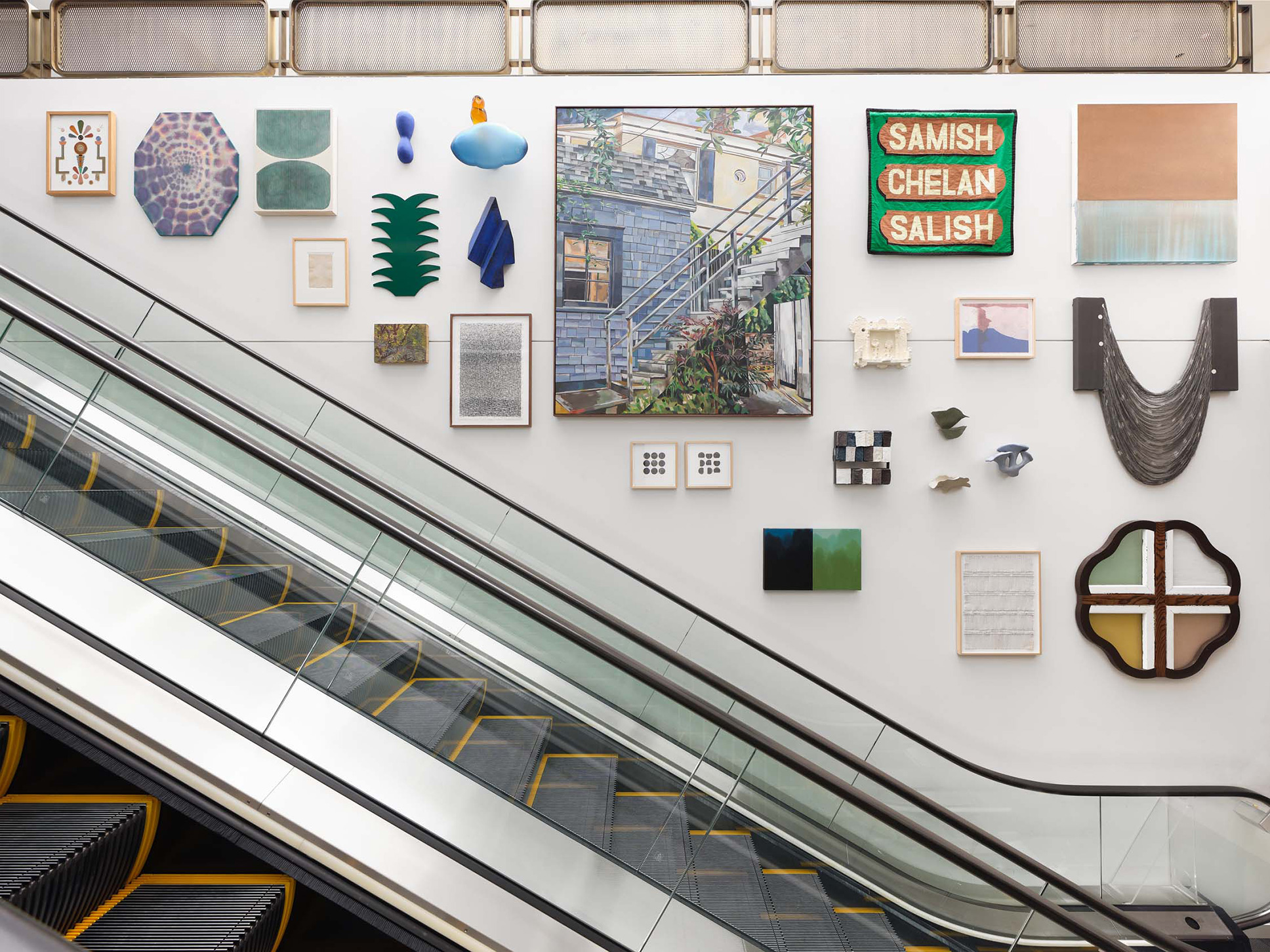
All Along
Like any family, the artists making up our Pacific Northwest creative community are as different as we are similar. This collection weaves a diverse assemblage of the many voices that define our art scene, together creating a patchwork of rich color and texture. Each work reflects the kaleidoscopic ways our artists interpret the same natural surroundings of mountains, forests, and water and the array of cultural and individual meanings this landscape holds. Together, a vibrant family portrait emerges, one where differences are not only welcomed, but celebrated.
Curation: fruitsuper
Design: SkB Architects
Furniture: Objekts
https://fruitsuper.com/inspiration/all-along/
The Pike Overlook - Cedar Hall Collection
USBC Cedar Hall, Seattle WA
Like any family, the artists making up our Pacific Northwest creative community are as different as we are similar. This collection weaves a diverse assemblage of the many voices that define our art scene, together creating a patchwork of rich color and texture. Each work reflects the kaleidoscopic ways our artists interpret the same natural surroundings of mountains, forests, and water and the array of cultural and individual meanings this landscape holds. Together, a vibrant family portrait emerges, one where differences are not only welcomed, but celebrated.
Curation: fruitsuper
Design: SkB Architects
Furniture: Objekts
https://fruitsuper.com/inspiration/all-along/
The Pike Overlook - Cedar Hall Collection
USBC Cedar Hall, Seattle WA
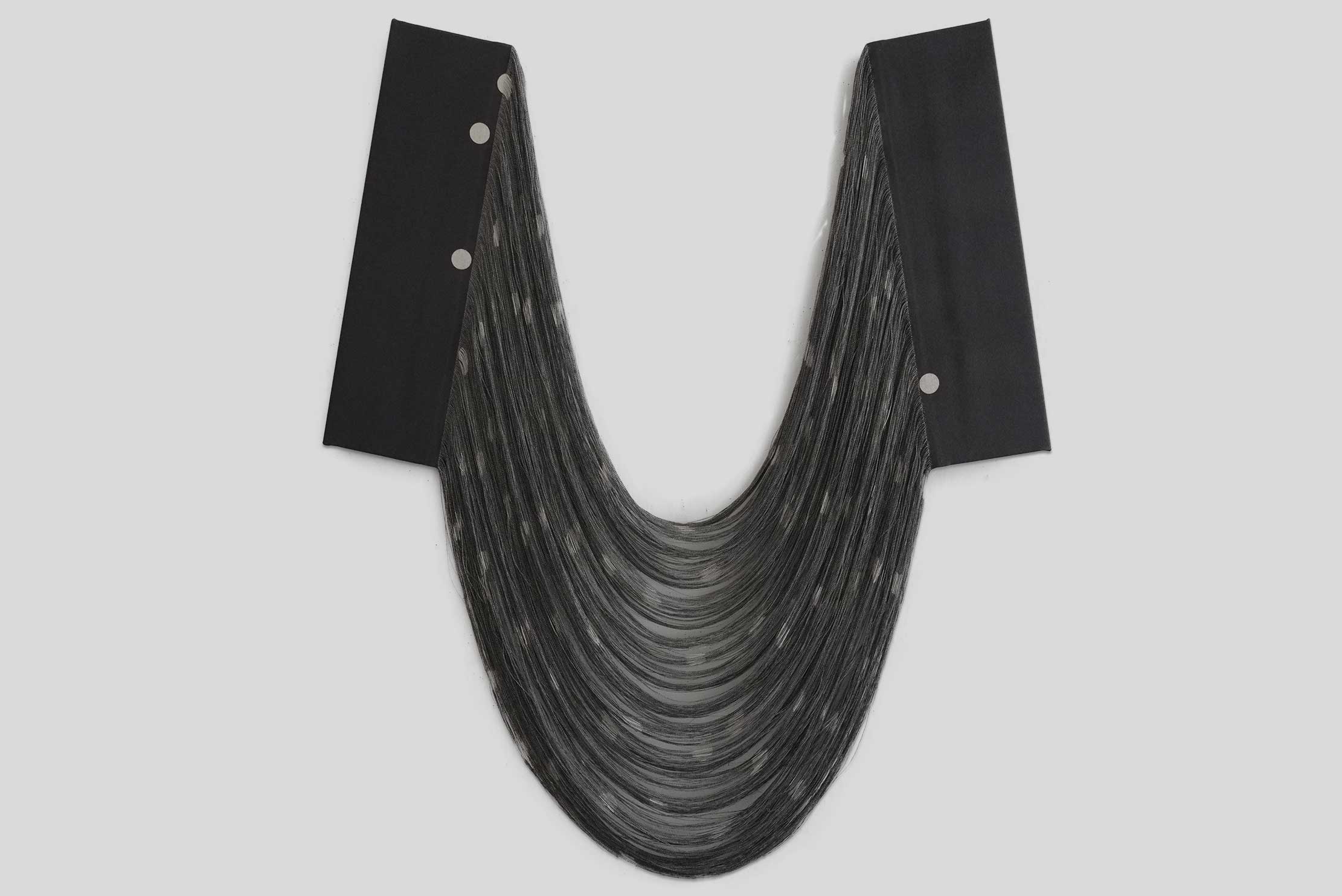
*Second from top right
*The piece was selected for USBC Public Art Collection
Untitled
2022
acrylic, graphite, partially unwoven canvas, wood
H44 x W36 x D2 inches
*The piece was selected for USBC Public Art Collection
Untitled
2022
acrylic, graphite, partially unwoven canvas, wood
H44 x W36 x D2 inches



Untitled
2024
Acrylic, graphite, partially unwoven linen, wood
H38 x W26 x D6 inches
A wall-hanging piece, after coloring, the warp threads are removed from certain areas, and the left and right sides are attached to a wooden frame. The central weft threads are twisted three times in opposite directions around the center, and the left and right sides are joined together with a few inches between them. The left is the front side, the right is the back side, and the draped area is twisted and pressured, creating a unique curve due to the inherent stiffness of linen fibers. In the colored areas, the color soaks into the fibers, creating slightly soft lines, and two types of twists, expressing the front and back, and what lies in between.
March 2nd - April 6th
Group Exhibition "TOKICO" at studio e gallery, Seattle WA
https://studioegallery.net/Tokico
2024
Acrylic, graphite, partially unwoven linen, wood
H38 x W26 x D6 inches
A wall-hanging piece, after coloring, the warp threads are removed from certain areas, and the left and right sides are attached to a wooden frame. The central weft threads are twisted three times in opposite directions around the center, and the left and right sides are joined together with a few inches between them. The left is the front side, the right is the back side, and the draped area is twisted and pressured, creating a unique curve due to the inherent stiffness of linen fibers. In the colored areas, the color soaks into the fibers, creating slightly soft lines, and two types of twists, expressing the front and back, and what lies in between.
March 2nd - April 6th
Group Exhibition "TOKICO" at studio e gallery, Seattle WA
https://studioegallery.net/Tokico



Untitled
2023
acrylic, graphite, partially unwoven linen, wood
H30 x W18 x D6 inches
December 7th - 23rd
"Holiday Group Exhibition" at Russo Lee Gallery, Portland OR
2023
acrylic, graphite, partially unwoven linen, wood
H30 x W18 x D6 inches
December 7th - 23rd
"Holiday Group Exhibition" at Russo Lee Gallery, Portland OR
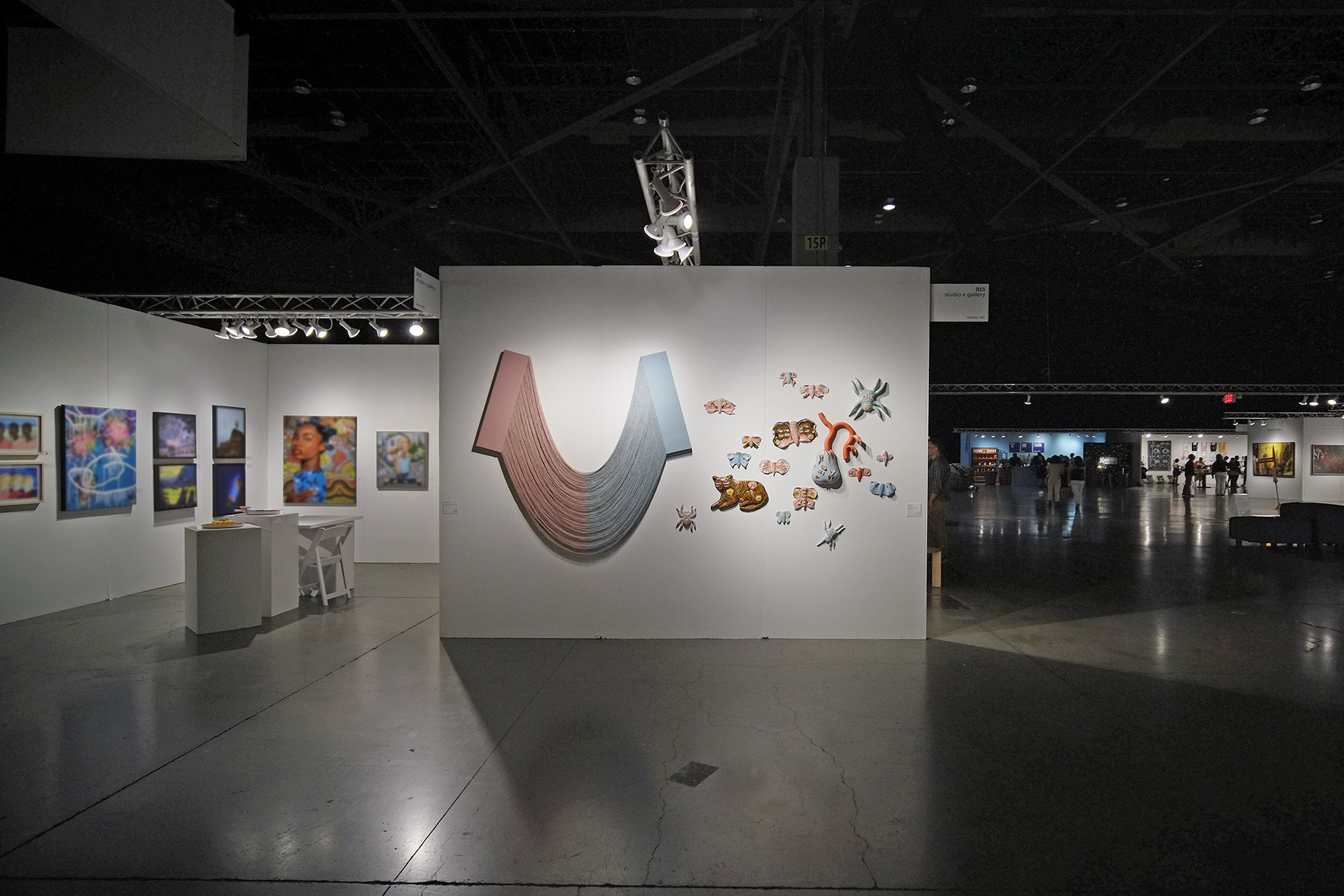
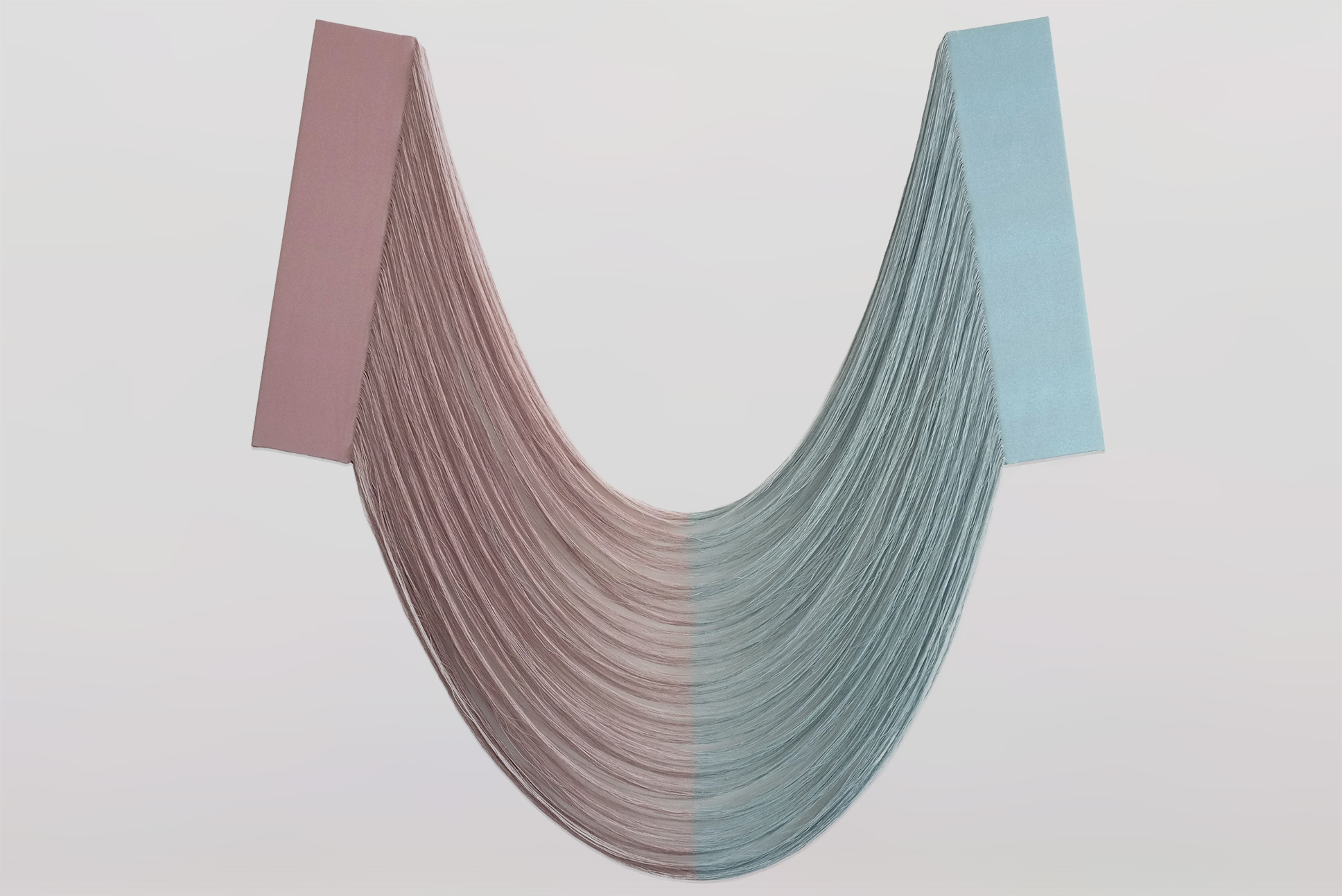
Untitled
2023
acrylic, graphite, partially unwoven canvas, wood
H64 x W63 x D2 inches
A single wall hanging piece, the colors on the left and right are complementary colors that face each other on the color wheel. After coloring, the warp threads are removed and colored again from the reverse side, creating a sense of unity between the flat and draped aeras. Furthermore, the flow of the draped part of the central weft bundle creates the highest value of complementary color contrast that intersects in the middle, creating a three-dimensionality of color.
July 27th - 30th, 2023
Seattle Art Fair - studio e Gallery - Booth B15
2023
acrylic, graphite, partially unwoven canvas, wood
H64 x W63 x D2 inches
A single wall hanging piece, the colors on the left and right are complementary colors that face each other on the color wheel. After coloring, the warp threads are removed and colored again from the reverse side, creating a sense of unity between the flat and draped aeras. Furthermore, the flow of the draped part of the central weft bundle creates the highest value of complementary color contrast that intersects in the middle, creating a three-dimensionality of color.
July 27th - 30th, 2023
Seattle Art Fair - studio e Gallery - Booth B15
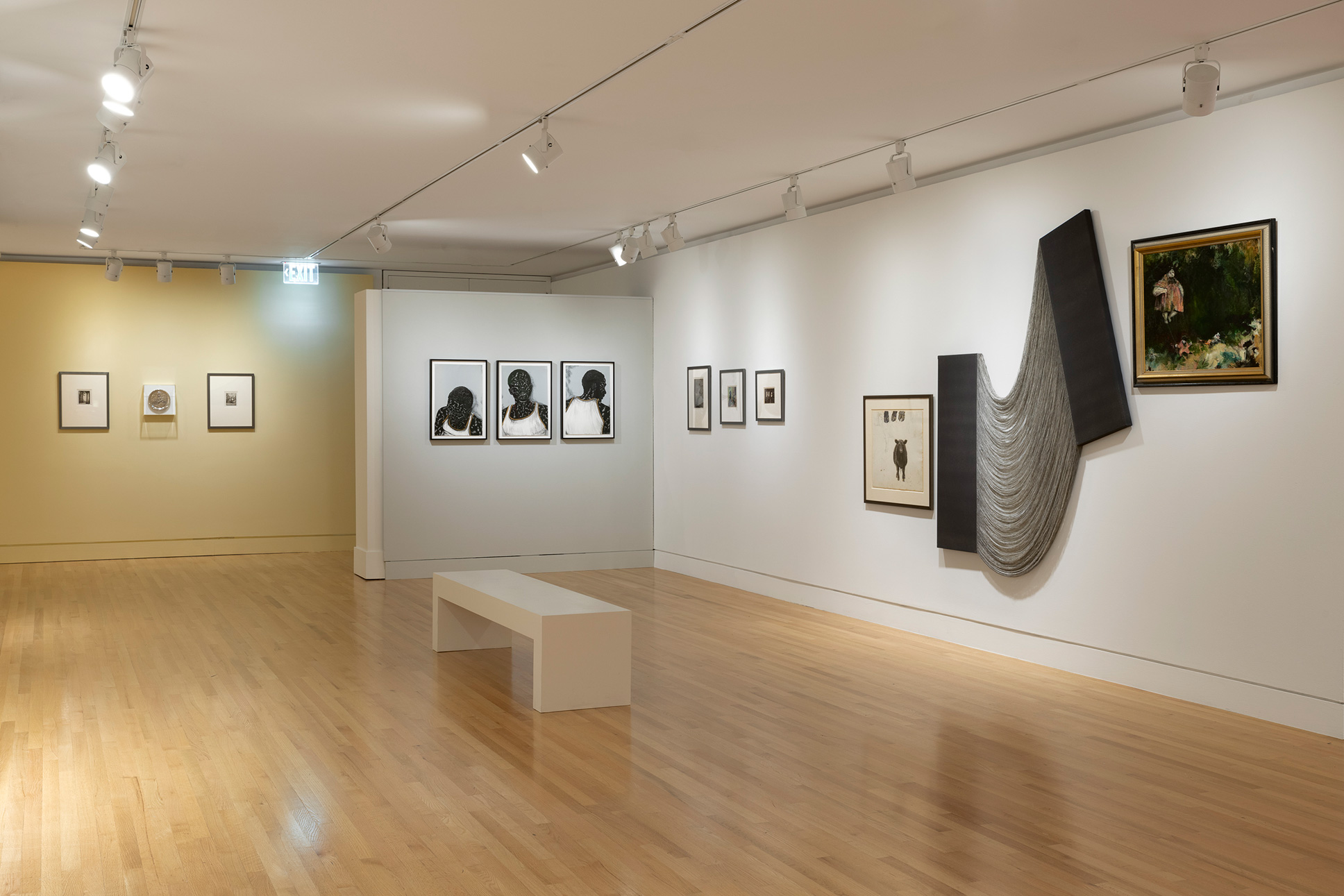
The Third, Meaning: ESTAR (SER) Installs Frye Collection
October 15th 2022 - October 15th, 2023
For this artist-curated installation of the Frye Art Museum’s collection, the research collective ESTAR(SER) reaches into an archive of dreams to assemble an exhibition that asks fundamental questions about museums and the works of art they hold: What do artworks want from us? And what do we want from them?
An ancient tale tells of an artist who once painted a child carrying a bunch of grapes. So lifelike was the image that birds came and pecked at the tasty-looking fruit. But the painter wasn’t satisfied. If the child had been more realistic, he reasoned, the birds would have been too frightened to approach. Determined, he reworked the painting, and, setting it outside, watched as three birds approached: the first glimpsed the child and fled, just as he had hoped; the second went ahead as before, and tried to eat the illusory fruit. But the third bird just landed in front of the painting and looked at it, in perfect stillness, for a very long time.
Embarking from this story of appetite, fear, and fascination, THE THIRD, MEANING stages much-loved works from the Frye Art Museum’s collection—along with some rarely seen treasures—in a series of triads, groupings of three that invite viewers to ponder the “Birdish” problem: Should we draw near? Turn away? Keep looking? Each triad aims to set up a small conversation (about form, about content, about history). Visitors are invited to eavesdrop on these quiet exchanges, occasionally with the aid of playful tools for focusing, diffracting, or remaking their perceptions. What is it like to look with avian eyes? And if the paintings were themselves birds, which is hungriest? Which would fly away? Which, gazing back, would stay?
No mere allegory, the “third bird” can be thought of as an avatar of attention. Through the attentive senses, every museumgoer participates in the making of a work of art. THE THIRD, MEANING circles the power and complexity of this remarkable human faculty: our ability to give attention, and to receive what it gives; the power to land in front of anything, and wait upon everything. In conjunction with the exhibition, a series of gallery interventions and activations configured by ESTAR(SER) will offer opportunities to test the creative possibilities of every act of sustained attention.
https://fryemuseum.org/exhibitions/third-meaning-estarser-installs-frye-collection
Frye Art Museum, Seattle WA
Image courtesy of Jueqian Fang
*The second wall hanging from the left
Untitled
2019
acrylic, graphite, partially unwoven canvas, wood
H60 x W60 x D2 inches - dimensions variable
October 15th 2022 - October 15th, 2023
For this artist-curated installation of the Frye Art Museum’s collection, the research collective ESTAR(SER) reaches into an archive of dreams to assemble an exhibition that asks fundamental questions about museums and the works of art they hold: What do artworks want from us? And what do we want from them?
An ancient tale tells of an artist who once painted a child carrying a bunch of grapes. So lifelike was the image that birds came and pecked at the tasty-looking fruit. But the painter wasn’t satisfied. If the child had been more realistic, he reasoned, the birds would have been too frightened to approach. Determined, he reworked the painting, and, setting it outside, watched as three birds approached: the first glimpsed the child and fled, just as he had hoped; the second went ahead as before, and tried to eat the illusory fruit. But the third bird just landed in front of the painting and looked at it, in perfect stillness, for a very long time.
Embarking from this story of appetite, fear, and fascination, THE THIRD, MEANING stages much-loved works from the Frye Art Museum’s collection—along with some rarely seen treasures—in a series of triads, groupings of three that invite viewers to ponder the “Birdish” problem: Should we draw near? Turn away? Keep looking? Each triad aims to set up a small conversation (about form, about content, about history). Visitors are invited to eavesdrop on these quiet exchanges, occasionally with the aid of playful tools for focusing, diffracting, or remaking their perceptions. What is it like to look with avian eyes? And if the paintings were themselves birds, which is hungriest? Which would fly away? Which, gazing back, would stay?
No mere allegory, the “third bird” can be thought of as an avatar of attention. Through the attentive senses, every museumgoer participates in the making of a work of art. THE THIRD, MEANING circles the power and complexity of this remarkable human faculty: our ability to give attention, and to receive what it gives; the power to land in front of anything, and wait upon everything. In conjunction with the exhibition, a series of gallery interventions and activations configured by ESTAR(SER) will offer opportunities to test the creative possibilities of every act of sustained attention.
https://fryemuseum.org/exhibitions/third-meaning-estarser-installs-frye-collection
Frye Art Museum, Seattle WA
Image courtesy of Jueqian Fang
*The second wall hanging from the left
Untitled
2019
acrylic, graphite, partially unwoven canvas, wood
H60 x W60 x D2 inches - dimensions variable

the front to the reverse to what is in between
To take the front as a surface, determination as to whether the reverse is to be regarded as either a further part of it or as what is other than it can prove difficult in the lack of physical perceptibility of the whole, while personal discretion does also pertain. The subject and what is other than it: at times existent as nothing; at times non-existent even as nothing, simply silence. Stabs at verbalization may offer compensation in part for this gap, yet can have aspects of relativity in a sense as well, bringing further complexity and distance.
Surfaces perceivable from all angles may exhibit aspects of immutability, yet at the same time in fact mutability in relation to who they might be perceived by, as well as the sort of angle, proximity, timing and level of experience applied in their viewing. While it may in fact then be a possibility to make such explicit, the composition of this matter is yet informed verily by a form of unwritten rule.
Visualization of the unwritten rule is ephemeral by nature: though the answer may exist in a given fleeting moment, there may then simply, merely exist a surface the next. Visualization of the unwritten rule is of an exceedingly individually-rooted nature: from the front to the reverse to what is in between, existent surfaces are innumerable. The subject and what is other than it, interwoven, are given embodied form.
July 6th - 28th, 2023
"the front to the reverse to what is in between" at Russo Lee Gallery, Portland OR
To take the front as a surface, determination as to whether the reverse is to be regarded as either a further part of it or as what is other than it can prove difficult in the lack of physical perceptibility of the whole, while personal discretion does also pertain. The subject and what is other than it: at times existent as nothing; at times non-existent even as nothing, simply silence. Stabs at verbalization may offer compensation in part for this gap, yet can have aspects of relativity in a sense as well, bringing further complexity and distance.
Surfaces perceivable from all angles may exhibit aspects of immutability, yet at the same time in fact mutability in relation to who they might be perceived by, as well as the sort of angle, proximity, timing and level of experience applied in their viewing. While it may in fact then be a possibility to make such explicit, the composition of this matter is yet informed verily by a form of unwritten rule.
Visualization of the unwritten rule is ephemeral by nature: though the answer may exist in a given fleeting moment, there may then simply, merely exist a surface the next. Visualization of the unwritten rule is of an exceedingly individually-rooted nature: from the front to the reverse to what is in between, existent surfaces are innumerable. The subject and what is other than it, interwoven, are given embodied form.
July 6th - 28th, 2023
"the front to the reverse to what is in between" at Russo Lee Gallery, Portland OR

Untitled
2023
acrylic, graphite, partially unwoven canvas, wood
H76 x W87 x D3 inches
A wall-hanging piece, one half colored black, flip the canvas over, the other half colored black and overlapping for a few inches, creating a half-tone dark center line. Certain warp threads are removed and the remaining weft threads are twisted a half turn in the center. The possibilities of the surface are expressed by physically twisting the piece itself. The center line is twisted to form a ring-like shape, and the thread bundles similarly create a dynamic three-dimensionality.
July 6th - 28th, 2023
"the front to the reverse to what is in between" at Russo Lee Gallery, Portland OR
2023
acrylic, graphite, partially unwoven canvas, wood
H76 x W87 x D3 inches
A wall-hanging piece, one half colored black, flip the canvas over, the other half colored black and overlapping for a few inches, creating a half-tone dark center line. Certain warp threads are removed and the remaining weft threads are twisted a half turn in the center. The possibilities of the surface are expressed by physically twisting the piece itself. The center line is twisted to form a ring-like shape, and the thread bundles similarly create a dynamic three-dimensionality.
July 6th - 28th, 2023
"the front to the reverse to what is in between" at Russo Lee Gallery, Portland OR
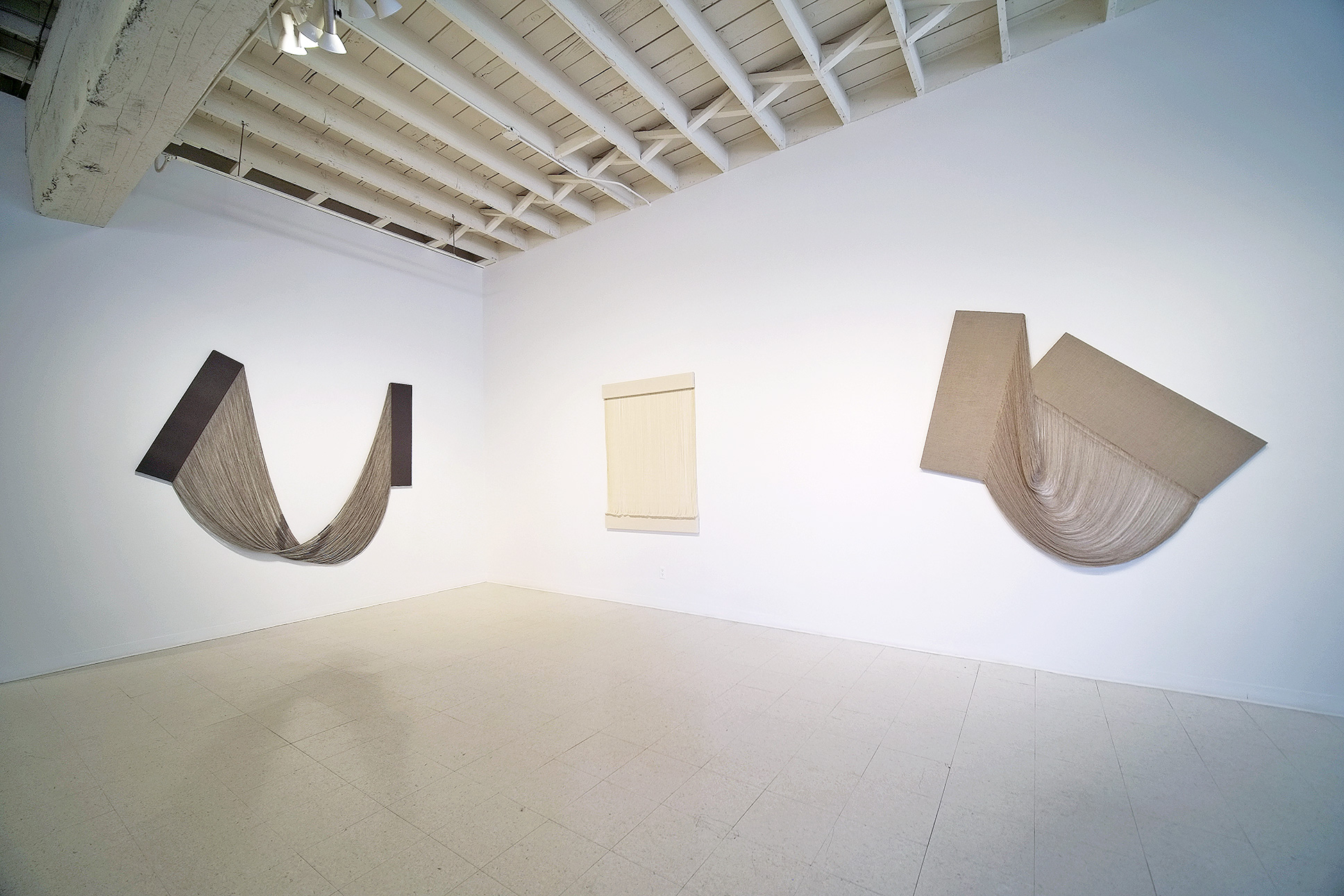
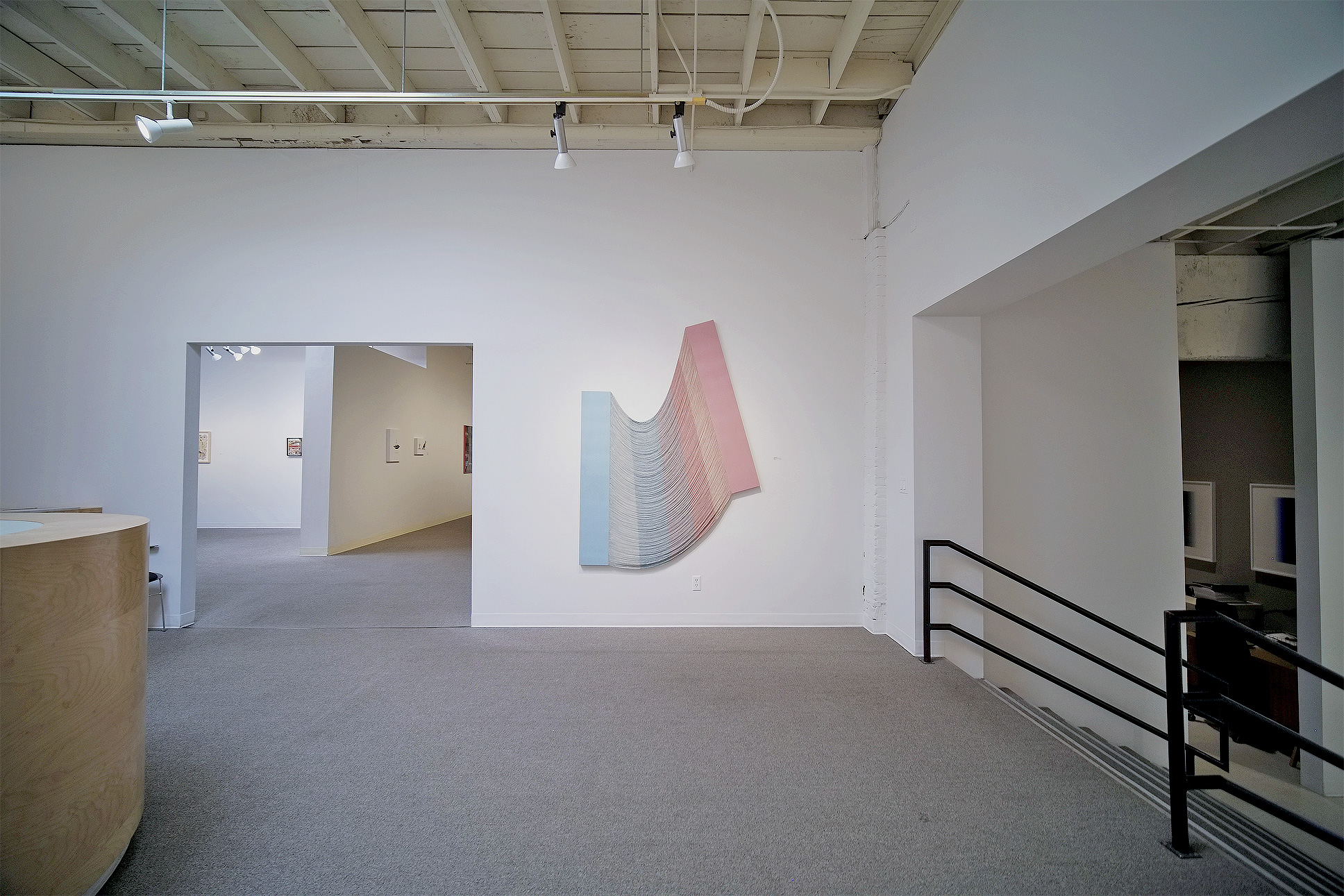
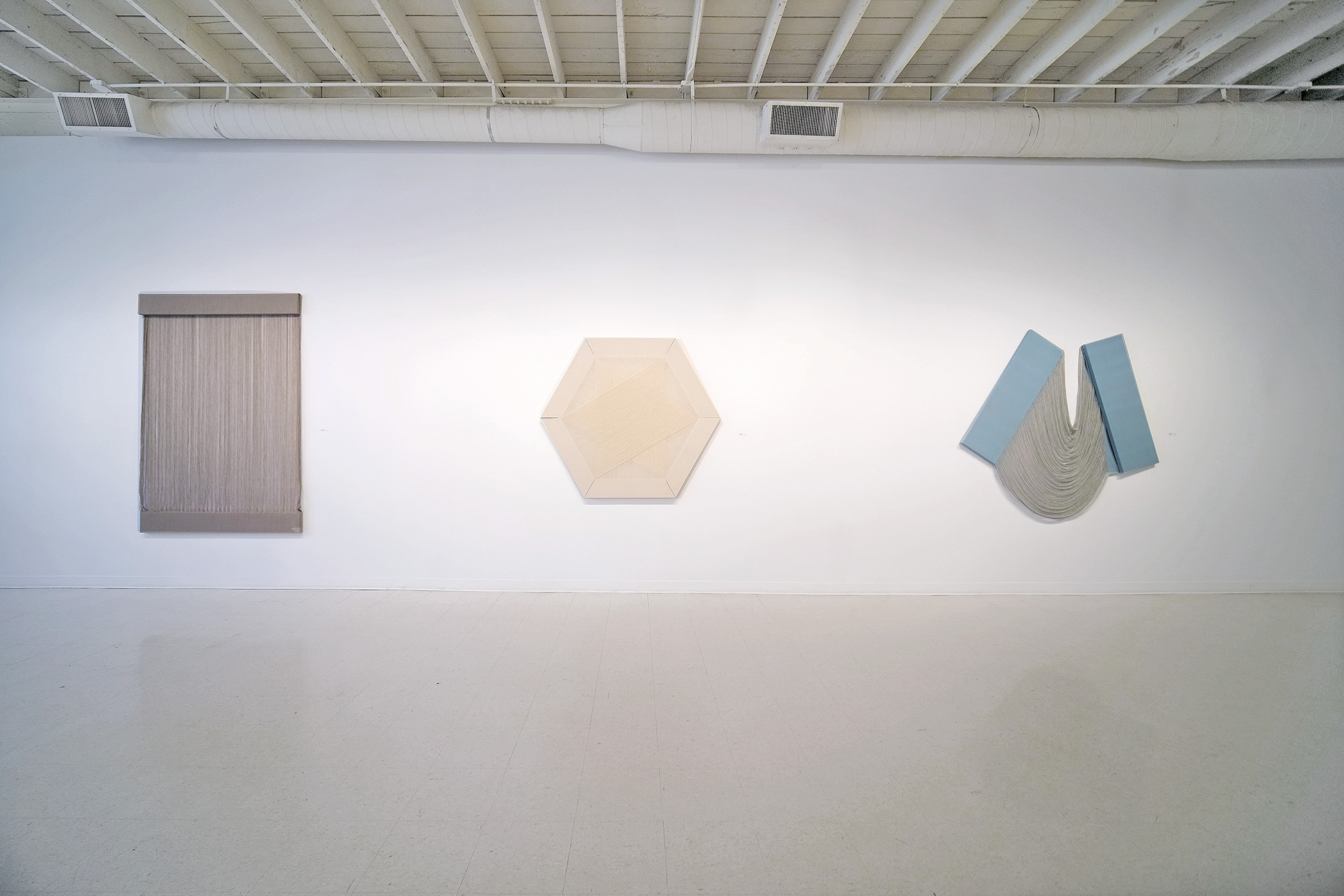

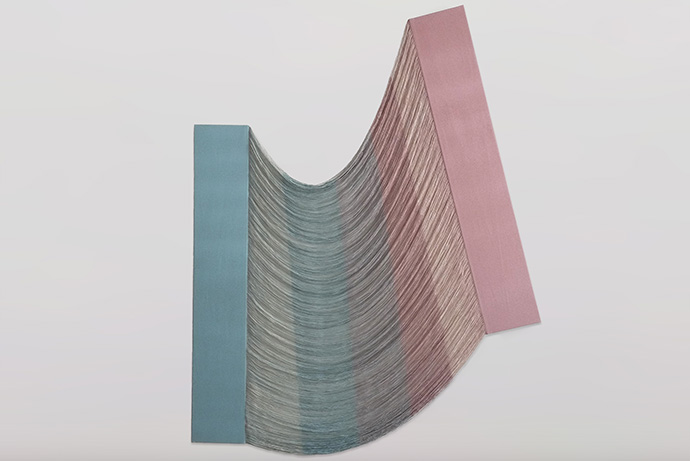
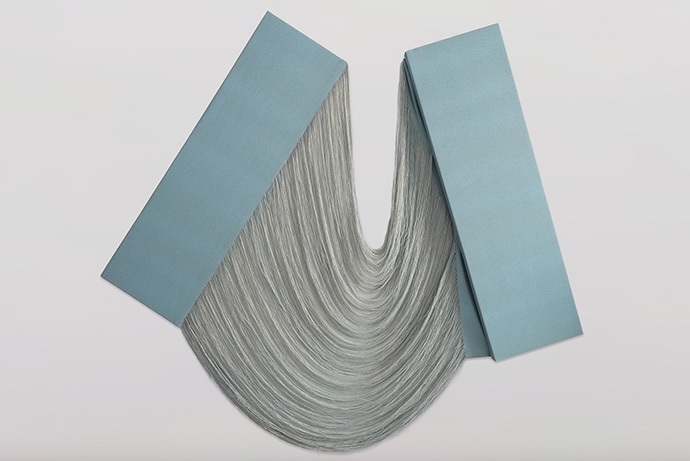

- Top
Untitled
2023
acrylic, graphite, partially unwoven canvas, wood
H79 x W61 x D2 inches
- Middle
Untitled
2023
acrylic, graphite, partially unwoven canvas, wood
H63 x W67 x D2 inches
- Bottom
Untitled
2023
graphite, partially unwoven linen canvas, wood
H54 x W60 x D2 inches
July 6th - 28th, 2023
"the front to the reverse to what is in between" at Russo Lee Gallery, Portland OR
Untitled
2023
acrylic, graphite, partially unwoven canvas, wood
H79 x W61 x D2 inches
- Middle
Untitled
2023
acrylic, graphite, partially unwoven canvas, wood
H63 x W67 x D2 inches
- Bottom
Untitled
2023
graphite, partially unwoven linen canvas, wood
H54 x W60 x D2 inches
July 6th - 28th, 2023
"the front to the reverse to what is in between" at Russo Lee Gallery, Portland OR
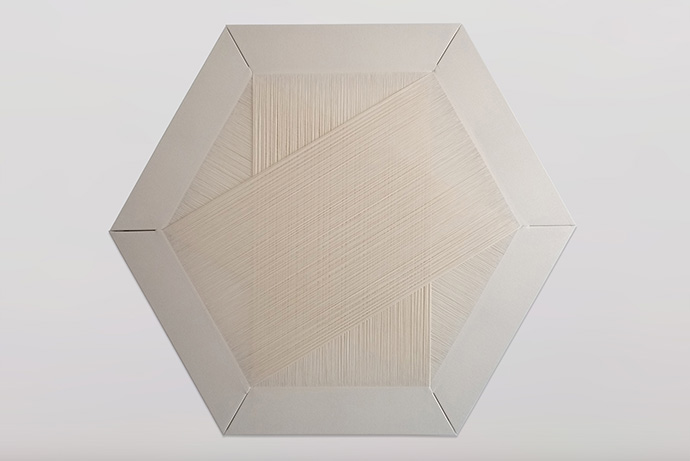
Untitled
2023
graphite, partially unwoven canvas, wood
H53 x W53 x D2 inches
A wall hanging piece, three pairs of surfaces overlap to form a hexagon. All the weft threads were removed from each canvas, leaving only a few inches on each end. Both ends of the removed warp threads are stretched to their maximum extent, and the tension of the threads bundle supports each other, including the wooden frame, to form the piece. This work makes use of the beauty and strength of the canvas itself.
July 6th - 28th, 2023
"the front to the reverse to what is in between" at Russo Lee Gallery, Portland OR
2023
graphite, partially unwoven canvas, wood
H53 x W53 x D2 inches
A wall hanging piece, three pairs of surfaces overlap to form a hexagon. All the weft threads were removed from each canvas, leaving only a few inches on each end. Both ends of the removed warp threads are stretched to their maximum extent, and the tension of the threads bundle supports each other, including the wooden frame, to form the piece. This work makes use of the beauty and strength of the canvas itself.
July 6th - 28th, 2023
"the front to the reverse to what is in between" at Russo Lee Gallery, Portland OR
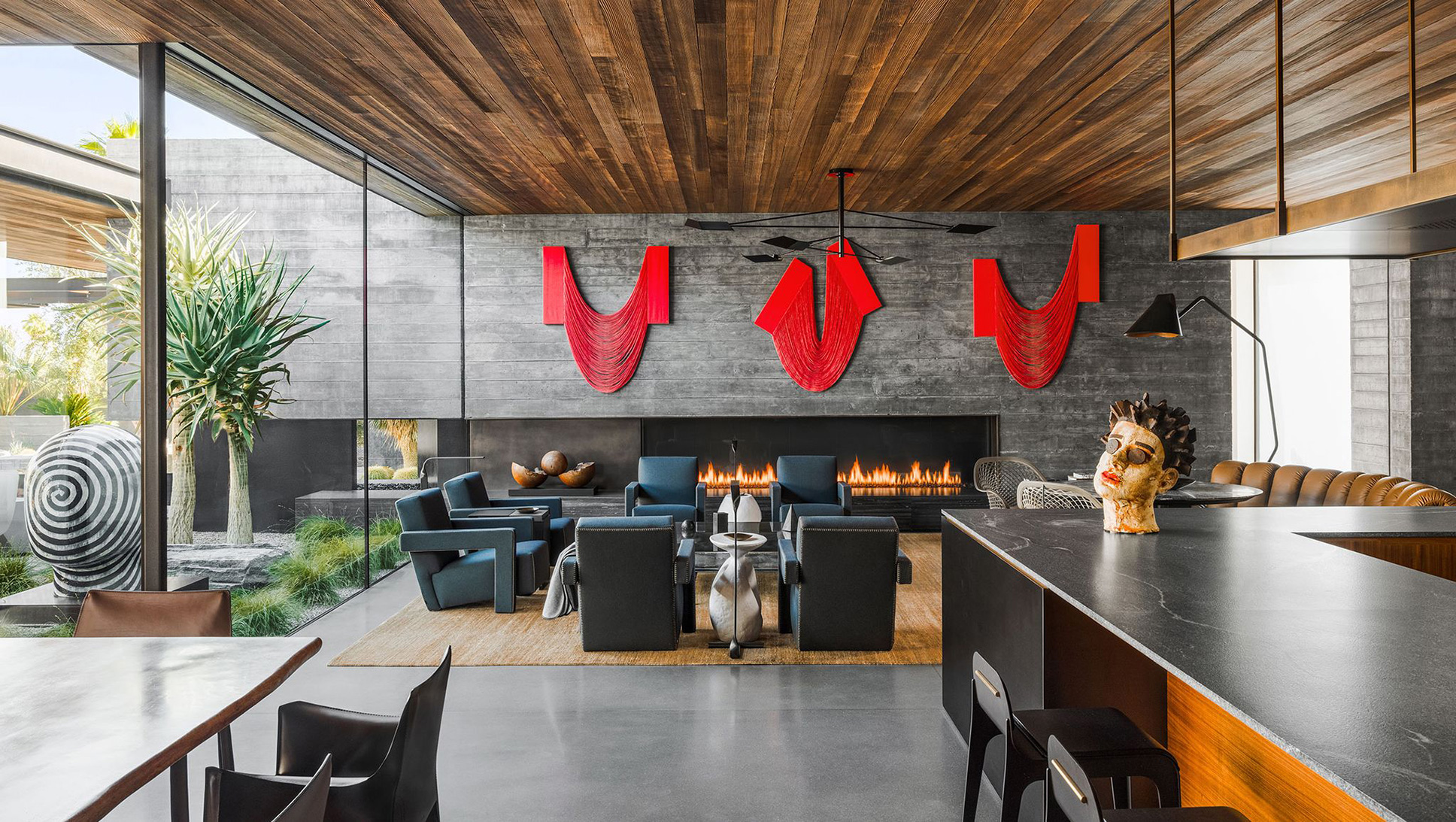
Untitled
2020
acrylic, graphite, partially unwoven canvas, wood
H57 x W48 x D2 inches each
This triptych offers an experience of subtle depth and dynamic possibility. Positioned above a mantelpiece, the work encourages an engagement that moves beyond the static presentation of traditional wall-hung art. The displayed arrangement is just one possible configuration; the main structures on either side can be freely adjusted within the thousands of options presented by the draped weft bundles. From multiple potential configurations, several key compositions are possible, each changing the relationship between the panels and the surrounding space. The genuine impact of the work, however, is found in my considered and meticulous process. I challenge simple ideas of surface through an elaborate application of color and texture. The process involves layering hues multiple times, followed by the careful removal of stitching. This deconstruction is an essential step, permitting further color saturation within the newly draped, re-formed sections of the canvas.
A subtle visual dynamic is established where the draped areas, created by removing all warp threads, share the same color as the panel’s flat surface. This deliberate chromatic choice allows for an expression of continuity that shifts depending on one’s perspective. The seemingly flat surface reveals a gentle, sculptural relief, where gravity and color combine to suggest movement. I capably transform the structure of the canvas into a more fluid form, blurring the line between painting and sculpture, and providing an insightful, layered view into perception and form.
*Featured in Elle Decor's "Think you know Palm Springs modern? just wait until you see this house." by Lydia Lee - Image courtesy of Elle Decor / elledecor.com
Featured in Elle Decor's "Think you know Palm Springs modern? just wait until you see this house."
by Lydia Lee - Image courtesy of Elle Decor, elledecor.com
2020
acrylic, graphite, partially unwoven canvas, wood
H57 x W48 x D2 inches each
This triptych offers an experience of subtle depth and dynamic possibility. Positioned above a mantelpiece, the work encourages an engagement that moves beyond the static presentation of traditional wall-hung art. The displayed arrangement is just one possible configuration; the main structures on either side can be freely adjusted within the thousands of options presented by the draped weft bundles. From multiple potential configurations, several key compositions are possible, each changing the relationship between the panels and the surrounding space. The genuine impact of the work, however, is found in my considered and meticulous process. I challenge simple ideas of surface through an elaborate application of color and texture. The process involves layering hues multiple times, followed by the careful removal of stitching. This deconstruction is an essential step, permitting further color saturation within the newly draped, re-formed sections of the canvas.
A subtle visual dynamic is established where the draped areas, created by removing all warp threads, share the same color as the panel’s flat surface. This deliberate chromatic choice allows for an expression of continuity that shifts depending on one’s perspective. The seemingly flat surface reveals a gentle, sculptural relief, where gravity and color combine to suggest movement. I capably transform the structure of the canvas into a more fluid form, blurring the line between painting and sculpture, and providing an insightful, layered view into perception and form.
*Featured in Elle Decor's "Think you know Palm Springs modern? just wait until you see this house." by Lydia Lee - Image courtesy of Elle Decor / elledecor.com
Featured in Elle Decor's "Think you know Palm Springs modern? just wait until you see this house."
by Lydia Lee - Image courtesy of Elle Decor, elledecor.com
Inside Demi Lovato's Modern California Farmhouse | Open Door | Architectural Digest
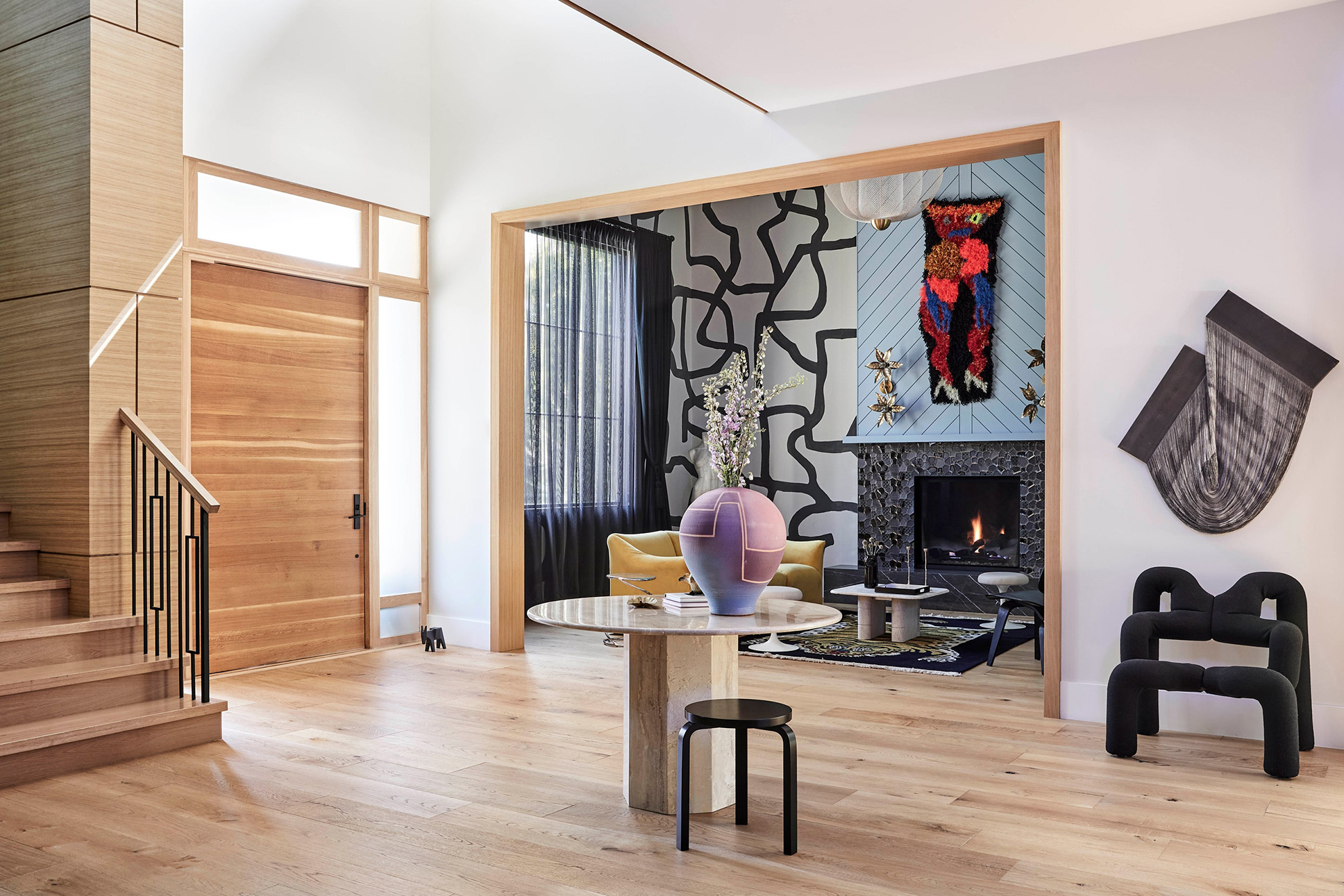

*The piece on the right is displayed in the top installation view image on the right wall
Untitled
2019
acrylic, graphite, partially unwoven canvas, wood
H45 x W45 x D2 inches
WEB-EXCLUSIVE HOME TOUR
Welcome to Demi Lovato’s Trippy Modern Farmhouse
From the glam room to a pup play area, the star’s indoor-outdoor space is all about good vibes
By Sydney Gore
Photography by Jenna Peffley
Styled by Kat Bell
https://www.architecturaldigest.com/gallery/demi-lovato-home-tour-los-angeles-modern-farmhouse
Demi Lovato's Trippy Modern Farmhouse - Image courtesy of Architectural Digest / architecturaldigest.com
Untitled
2019
acrylic, graphite, partially unwoven canvas, wood
H45 x W45 x D2 inches
WEB-EXCLUSIVE HOME TOUR
Welcome to Demi Lovato’s Trippy Modern Farmhouse
From the glam room to a pup play area, the star’s indoor-outdoor space is all about good vibes
By Sydney Gore
Photography by Jenna Peffley
Styled by Kat Bell
https://www.architecturaldigest.com/gallery/demi-lovato-home-tour-los-angeles-modern-farmhouse
Demi Lovato's Trippy Modern Farmhouse - Image courtesy of Architectural Digest / architecturaldigest.com


Untitled
2022
acrylic, graphite, partially unwoven canvas, wood
H30 x W44 x D3 inches
Color the front side with magenta and the back side with a mixed color of CMY, the warp threads are removed from a certain area in the center and the left side is twisted half a turn around the center so that the back side on the left side becomes the front. When a certain amount of paint is absorbed into the bundle of threads, each weft thread naturally rotates half a clockwise direction, gradually changing color as it moves toward the center. A surface has a front and a back, but when half of the surface is twisted, the concept of two sides becomes somehow subjective. It concretely expresses the gradual change between the front to the back, and what lies in between.
"Holiday Group Exhibition" at Russo Lee Gallery, Portland OR
2022
acrylic, graphite, partially unwoven canvas, wood
H30 x W44 x D3 inches
Color the front side with magenta and the back side with a mixed color of CMY, the warp threads are removed from a certain area in the center and the left side is twisted half a turn around the center so that the back side on the left side becomes the front. When a certain amount of paint is absorbed into the bundle of threads, each weft thread naturally rotates half a clockwise direction, gradually changing color as it moves toward the center. A surface has a front and a back, but when half of the surface is twisted, the concept of two sides becomes somehow subjective. It concretely expresses the gradual change between the front to the back, and what lies in between.
"Holiday Group Exhibition" at Russo Lee Gallery, Portland OR
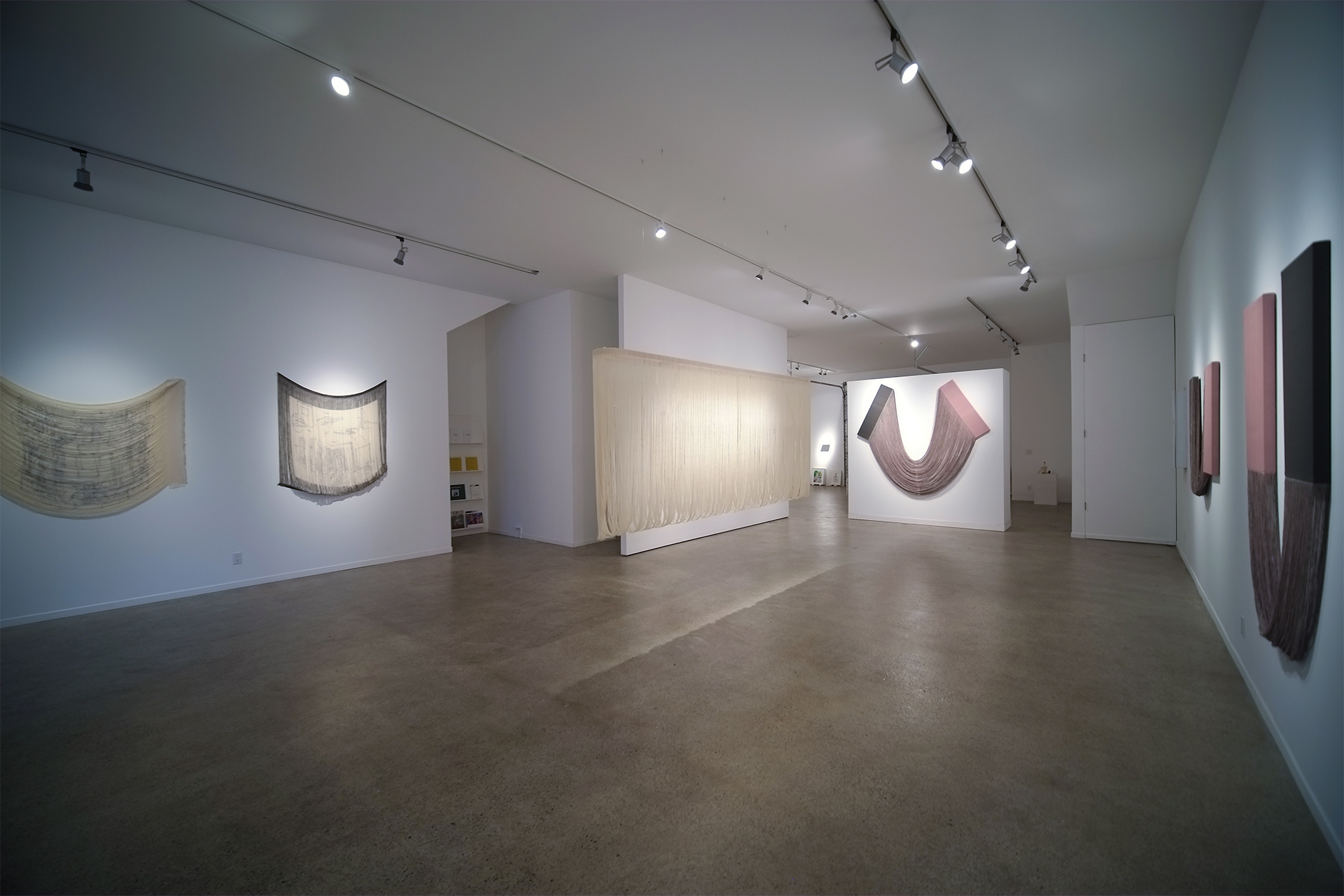
On the Conception of Multifaceted Qualities and Attendant Opposing (Relative) Relationships
The existence of a front is concurrent with the appearance of a back, the existence of a back concurrent with the appearance of a front. Regardless of what might be referenced here, there will be multiple facets to be perceived. Assuming an object, if three- dimensional, a number of surfaces (facets) will exist: the left and right, top and bottom, front and back. If a book, there will exist a new facet of content as well. And whether the book is opened with the contents facing oneself or another, whether the text might be written in an unfamiliar language... In this way, new facets are ever appearing.
Yet with regard to an object of perception, consequent to just what it might be in the first place, whether it has form, whether it is three-dimensional, spherical, when and where it might be perceived, by whom, in what manner, what it is that might be perceived as an object, from front to back, back to sides, contents to front, surface to surface, virtually all are ultimately dependent on one's own perception and ever subject to fluid transformation within oneself as well. And in relative opposition to all this, the object of perception in a sense possesses an aspect of immutability as well.
In what manner do we perceive the object, or do we even perceive in the first place? When we do perceive it, as to what we take to be the front, the back, sides, top and bottom, contents, it is individually that we recognize these or are able to, and I sense here, in the first place, a quality of elusivity: the object exists just so, certainly, yet is possessed of an oppositional (relative) aspect of non-existence at the same time. Just as there exists beyond the structure of the polyhedral object the sphere, even where surfaces (facets) may appear, they might also slip away to nought. What basis informs recognition of the front and of the back? Might either side not be the front, the back, or neither of the two? The object of perception, ever possessed of a quality of immutability, simply, simply exists.
November 5th - December 3rd 2022
"New Work 2022" at studio e gallery, Seattle WA
The existence of a front is concurrent with the appearance of a back, the existence of a back concurrent with the appearance of a front. Regardless of what might be referenced here, there will be multiple facets to be perceived. Assuming an object, if three- dimensional, a number of surfaces (facets) will exist: the left and right, top and bottom, front and back. If a book, there will exist a new facet of content as well. And whether the book is opened with the contents facing oneself or another, whether the text might be written in an unfamiliar language... In this way, new facets are ever appearing.
Yet with regard to an object of perception, consequent to just what it might be in the first place, whether it has form, whether it is three-dimensional, spherical, when and where it might be perceived, by whom, in what manner, what it is that might be perceived as an object, from front to back, back to sides, contents to front, surface to surface, virtually all are ultimately dependent on one's own perception and ever subject to fluid transformation within oneself as well. And in relative opposition to all this, the object of perception in a sense possesses an aspect of immutability as well.
In what manner do we perceive the object, or do we even perceive in the first place? When we do perceive it, as to what we take to be the front, the back, sides, top and bottom, contents, it is individually that we recognize these or are able to, and I sense here, in the first place, a quality of elusivity: the object exists just so, certainly, yet is possessed of an oppositional (relative) aspect of non-existence at the same time. Just as there exists beyond the structure of the polyhedral object the sphere, even where surfaces (facets) may appear, they might also slip away to nought. What basis informs recognition of the front and of the back? Might either side not be the front, the back, or neither of the two? The object of perception, ever possessed of a quality of immutability, simply, simply exists.
November 5th - December 3rd 2022
"New Work 2022" at studio e gallery, Seattle WA

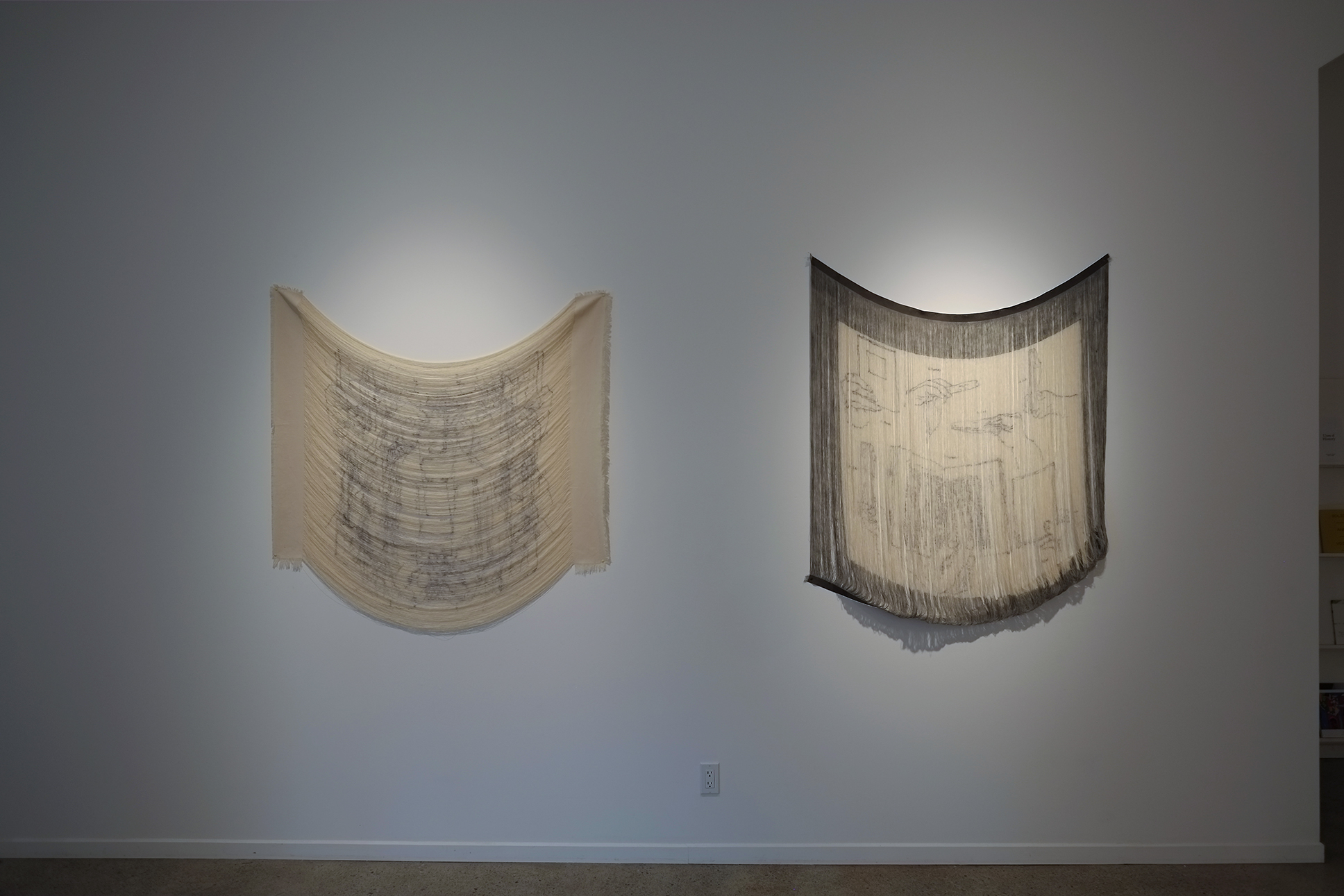
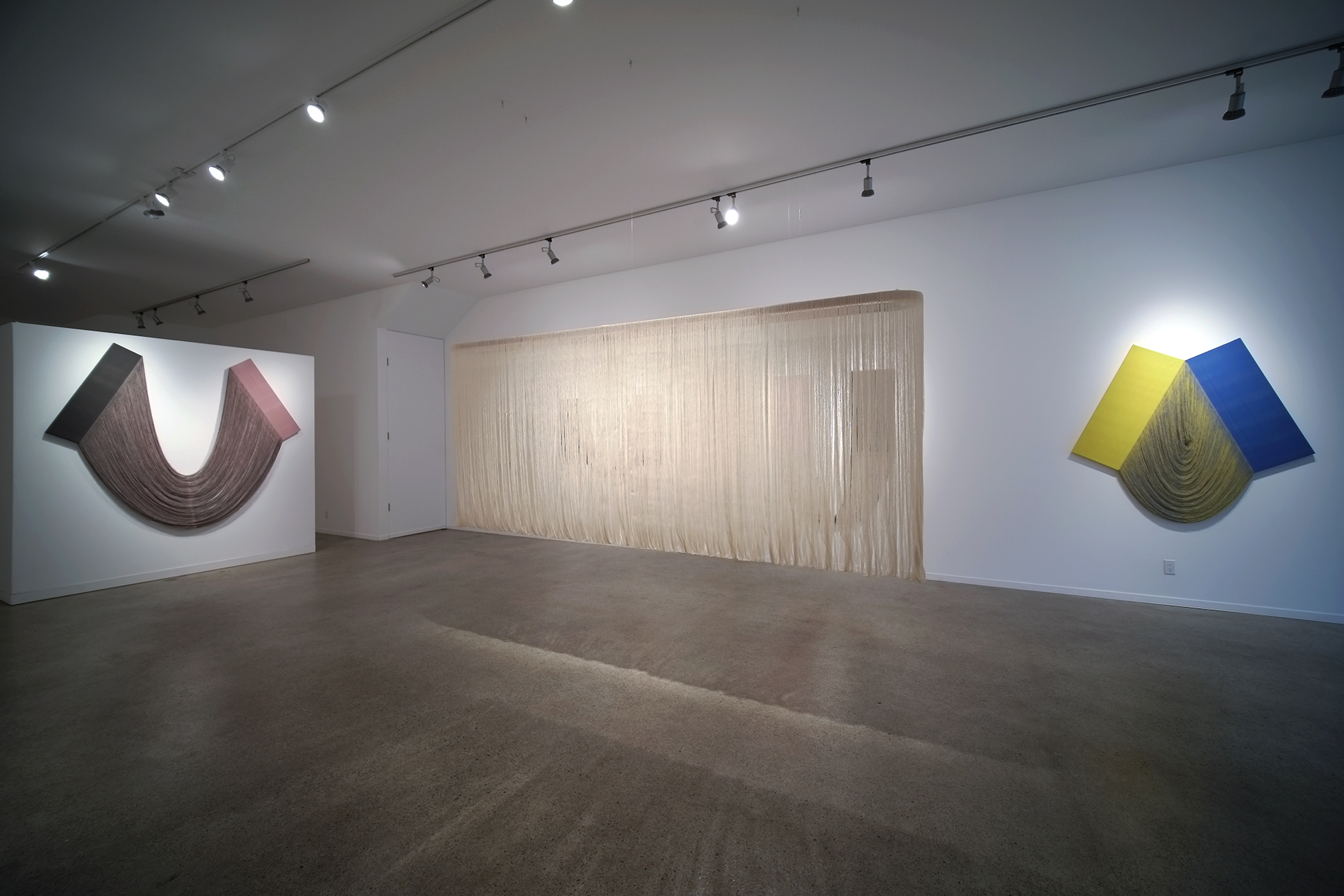
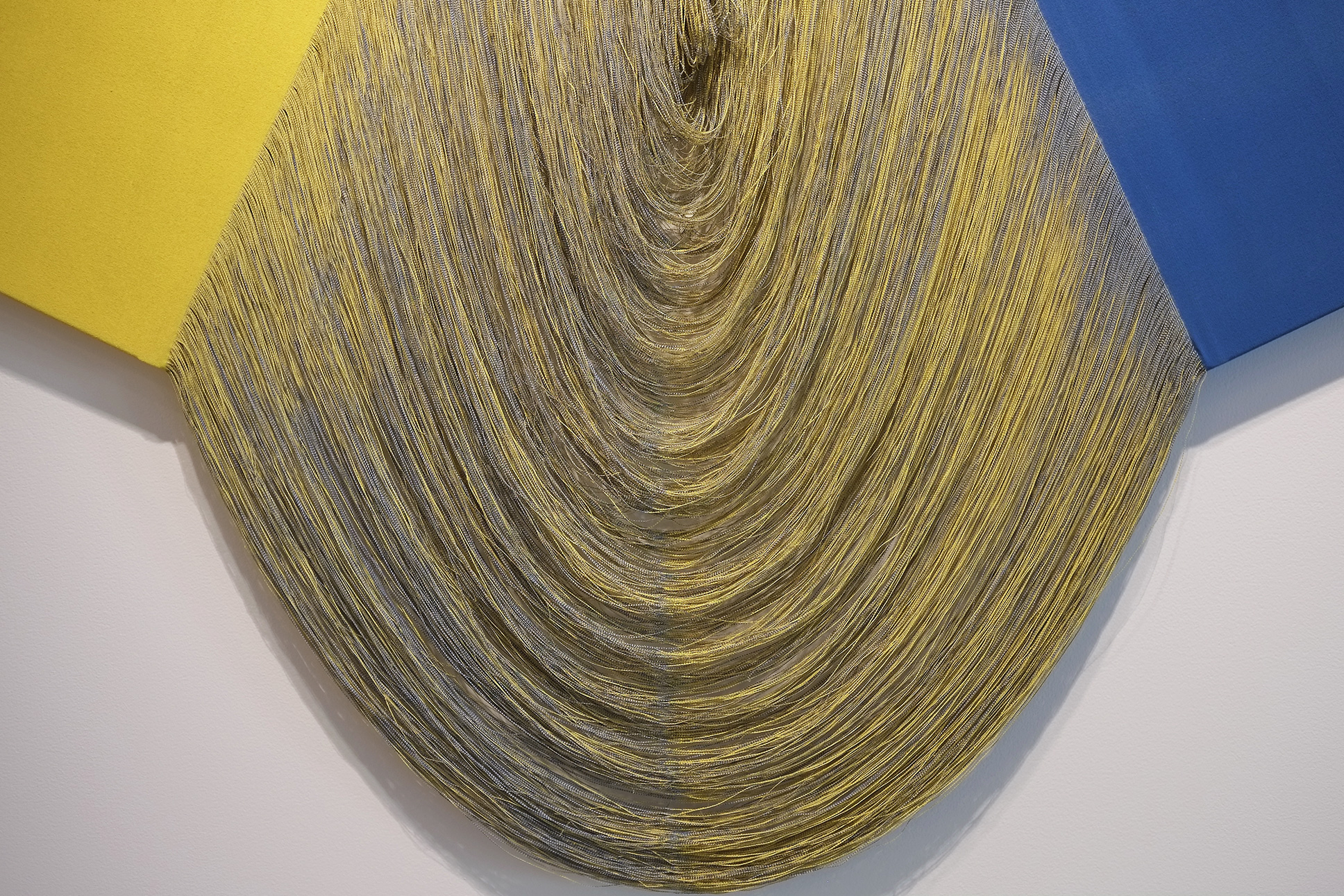

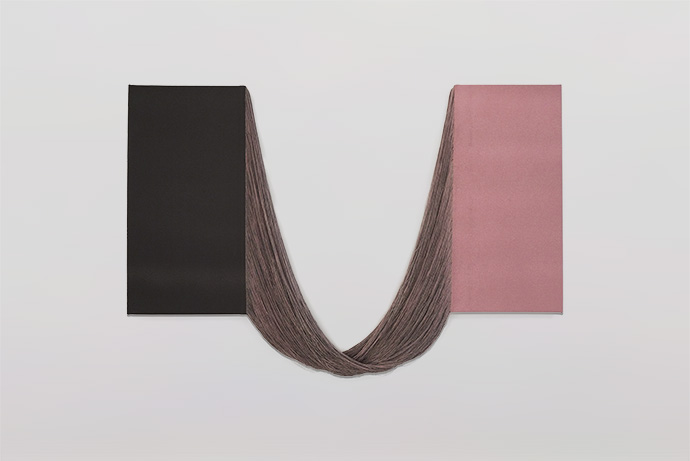
- Top
Installation View - Center hanging piece
Untitled
2022
graphite, partially unwoven canvas, wood
H60 x W150 x D9 inches each each
- Bottom
Untitled
2022
acrylic, graphite, partially unwoven canvas, wood
H42 x W64 x D3 inches
November 5th - December 3rd 2022
"New Work 2022" at studio e gallery, Seattle WA
Installation View - Center hanging piece
Untitled
2022
graphite, partially unwoven canvas, wood
H60 x W150 x D9 inches each each
- Bottom
Untitled
2022
acrylic, graphite, partially unwoven canvas, wood
H42 x W64 x D3 inches
November 5th - December 3rd 2022
"New Work 2022" at studio e gallery, Seattle WA
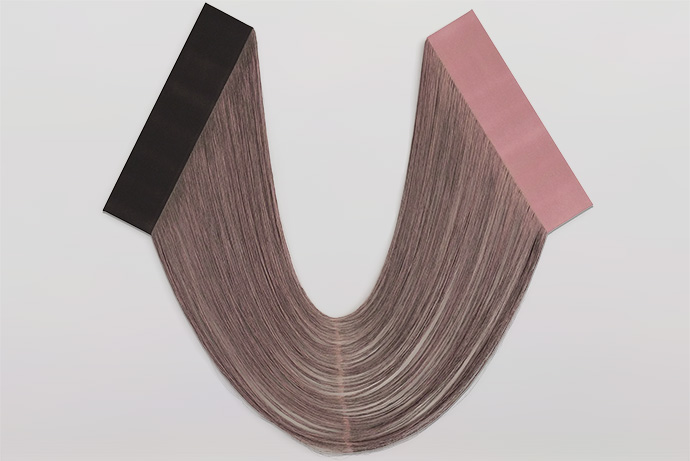




- Above
- Left
Untitled
2022
acrylic, graphite, partially unwoven canvas, wood
H44 x W36 x D2 inches each
*Left piece was selected for USBC Public Art Collection
- Right
Untitled
2022
acrylic, graphite, partially unwoven canvas, wood
H76 x W83 x D2 inches each
November 5th - December 3rd 2022
"New Work 2022" at studio e gallery, Seattle WA
- Left
Untitled
2022
acrylic, graphite, partially unwoven canvas, wood
H44 x W36 x D2 inches each
*Left piece was selected for USBC Public Art Collection
- Right
Untitled
2022
acrylic, graphite, partially unwoven canvas, wood
H76 x W83 x D2 inches each
November 5th - December 3rd 2022
"New Work 2022" at studio e gallery, Seattle WA
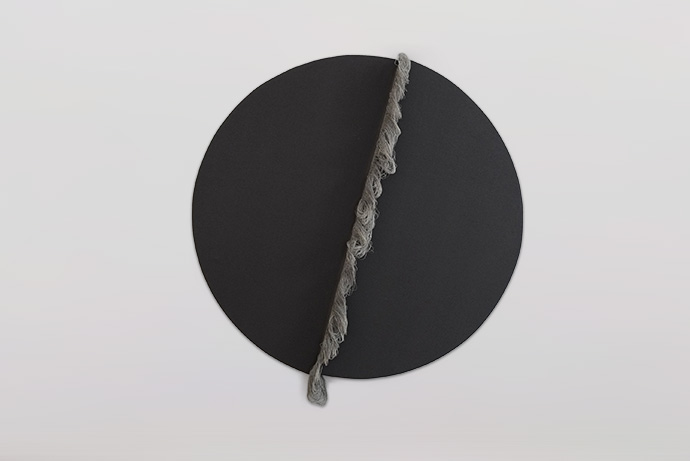

- Top
Untitled
2021
acrylic, graphite, partially unwoven canvas, wood
Dia.39 x D5 inches
A circular wall hanging piece, by slightly shifting the panels together at both ends and applying light diagonal pressure to the area where the threads have been removed, the tension of the thread bundle is used to create a height difference in depth. Using the flat surface of the canvas and the removed thread bundles, arcs of different sizes are expressed with contrasting three-dimensionality.
July 21-24, 2022
Seattle Art Fair - Russo Lee Gallery - Booth C11
- Bottom
Untitled
2022
acrylic, graphite, partially unwoven canvas, wood
H23 x W33 x D2
July 21-24, 2022
Seattle Art Fair - studio e gallery - Booth C07
Untitled
2021
acrylic, graphite, partially unwoven canvas, wood
Dia.39 x D5 inches
A circular wall hanging piece, by slightly shifting the panels together at both ends and applying light diagonal pressure to the area where the threads have been removed, the tension of the thread bundle is used to create a height difference in depth. Using the flat surface of the canvas and the removed thread bundles, arcs of different sizes are expressed with contrasting three-dimensionality.
July 21-24, 2022
Seattle Art Fair - Russo Lee Gallery - Booth C11
- Bottom
Untitled
2022
acrylic, graphite, partially unwoven canvas, wood
H23 x W33 x D2
July 21-24, 2022
Seattle Art Fair - studio e gallery - Booth C07

Since its opening in 1952, the Frye has maintained its dedication to the art and culture of the present through collecting and exhibiting contemporary art. This practice is guided by the example of Museum founders Charles and Emma Frye, who amassed a collection of paintings made within their own lifetimes, often by purchasing works directly from living artists. Over the past twenty years, the Museum has intentionally focused on broadening its holdings of contemporary art to include previously underrepresented identities, perspectives, and forms of expression.
This presentation brings together seven artworks—all acquired in 2019 and on view at the Museum for the first time—by a range of local, national, and international artists. Viewed together, they offer an insightful snapshot of the Museum’s curatorial program, as most of these artists have been featured recently in exhibitions at the Frye. Individually, the artworks expand or complicate narratives around mediums and genres such as painting, landscape, and portraiture that have traditionally been associated with the Frye’s Founding Collection of late nineteenth- and early twentieth-century European and American art.
https://fryemuseum.org/exhibitions/recent-acquisitions-contemporary-art
This presentation brings together seven artworks—all acquired in 2019 and on view at the Museum for the first time—by a range of local, national, and international artists. Viewed together, they offer an insightful snapshot of the Museum’s curatorial program, as most of these artists have been featured recently in exhibitions at the Frye. Individually, the artworks expand or complicate narratives around mediums and genres such as painting, landscape, and portraiture that have traditionally been associated with the Frye’s Founding Collection of late nineteenth- and early twentieth-century European and American art.
https://fryemuseum.org/exhibitions/recent-acquisitions-contemporary-art
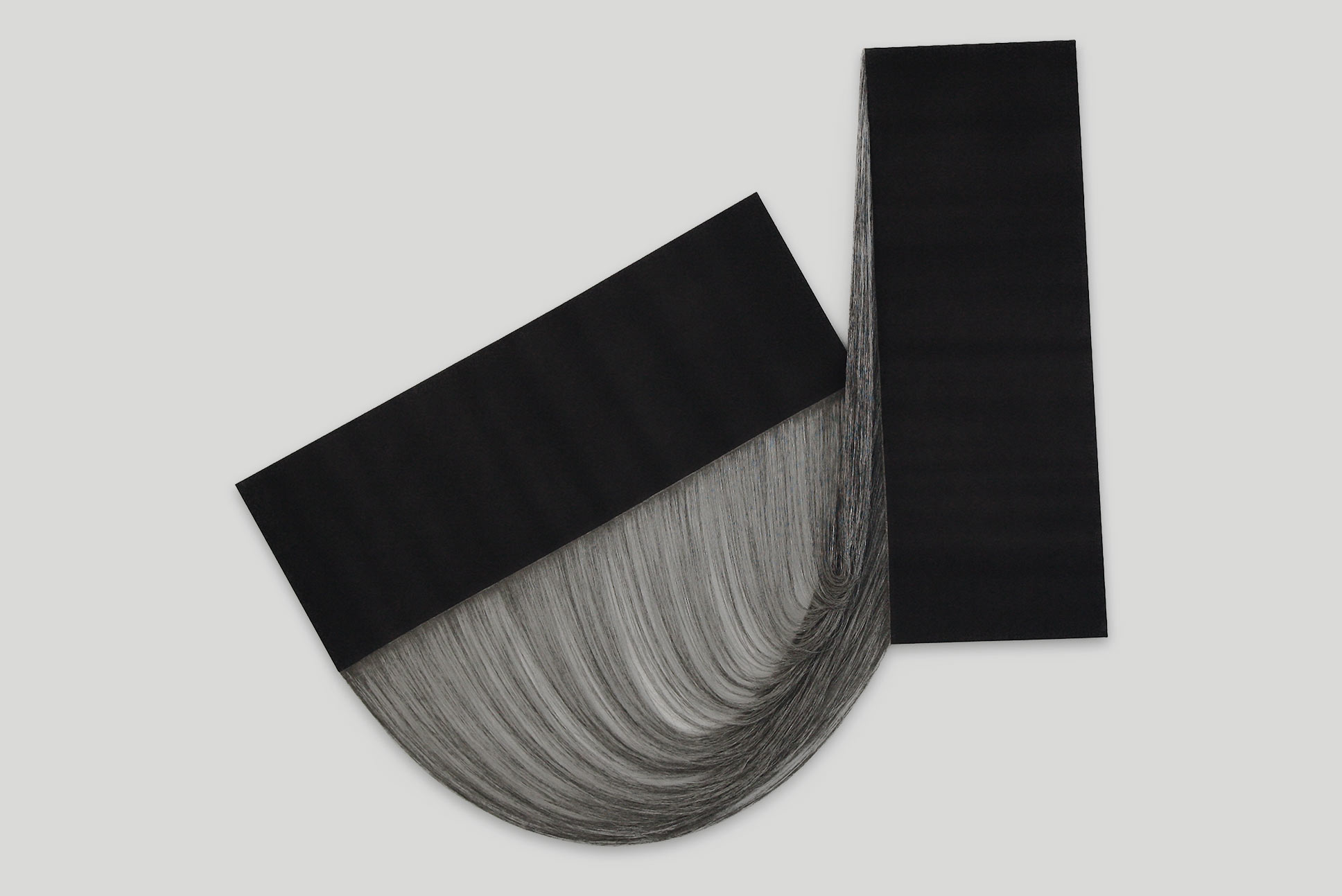
Untitled
2019
acrylic, graphite, partially unwoven canvas, wood
H46 x W90 x D2 inches
Seattle-based artist Ko Kirk Yamahira meticulously removes individual threads from the weave of his canvases, deconstructing his paintings and turning surface into form. In this work, the artist has created two detached segments linked with loose threads by pulling out the vertical strands in the middle section of the canvas and then stretching the intact ends around separate wooden frames. Yamahira does not prescribe a fixed orientation for his pieces, making the arrangement presented here but one of many possible configurations.
Verbal Description: The shape of this sculptural work resembles an accordion. Two solid black rectangular canvases are hung on the wall and connected by medium, gray-colored threads, running along the entire length of the rectangles.
https://collection.fryemuseum.org/objects-1/info/4610?sort=0
September 11th 2021 - January 23rd 2022
"Recent Acquisitions in Contemporary Art" at Frye Art Museum, Seattle WA
2019
acrylic, graphite, partially unwoven canvas, wood
H46 x W90 x D2 inches
Seattle-based artist Ko Kirk Yamahira meticulously removes individual threads from the weave of his canvases, deconstructing his paintings and turning surface into form. In this work, the artist has created two detached segments linked with loose threads by pulling out the vertical strands in the middle section of the canvas and then stretching the intact ends around separate wooden frames. Yamahira does not prescribe a fixed orientation for his pieces, making the arrangement presented here but one of many possible configurations.
Verbal Description: The shape of this sculptural work resembles an accordion. Two solid black rectangular canvases are hung on the wall and connected by medium, gray-colored threads, running along the entire length of the rectangles.
https://collection.fryemuseum.org/objects-1/info/4610?sort=0
September 11th 2021 - January 23rd 2022
"Recent Acquisitions in Contemporary Art" at Frye Art Museum, Seattle WA
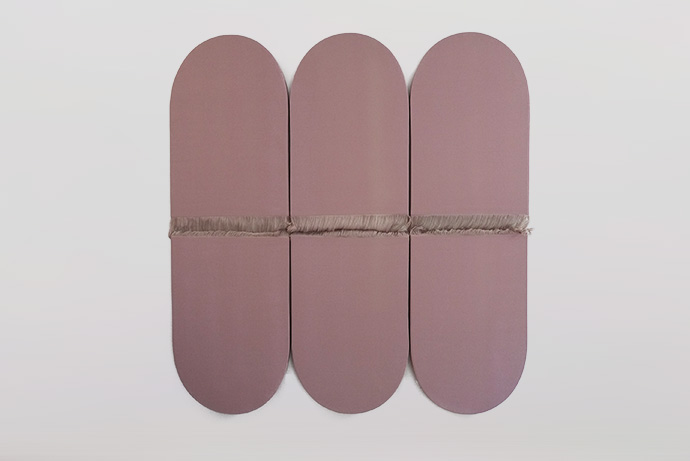
Untitled
2021
acrylic, graphite, partially unwoven canvas, wood
H60 x W60 x D3 inches
August 5th - 28th, 2021
Russo Lee Gallery, Portland OR
*The piece above was seleted for The Soho House's Art Collection, Portland, OR
2021
acrylic, graphite, partially unwoven canvas, wood
H60 x W60 x D3 inches
August 5th - 28th, 2021
Russo Lee Gallery, Portland OR
*The piece above was seleted for The Soho House's Art Collection, Portland, OR





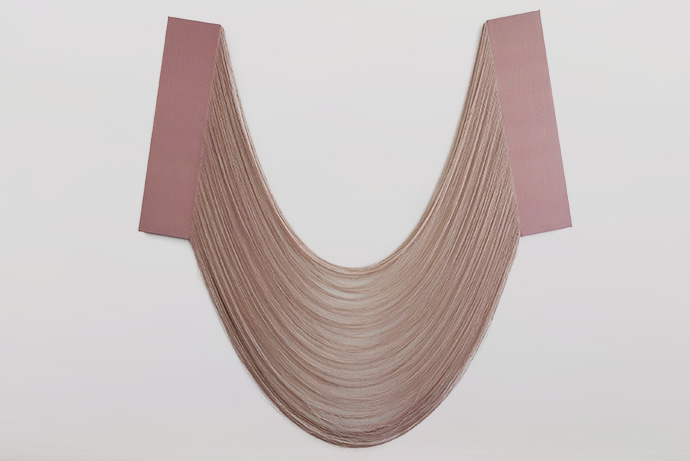
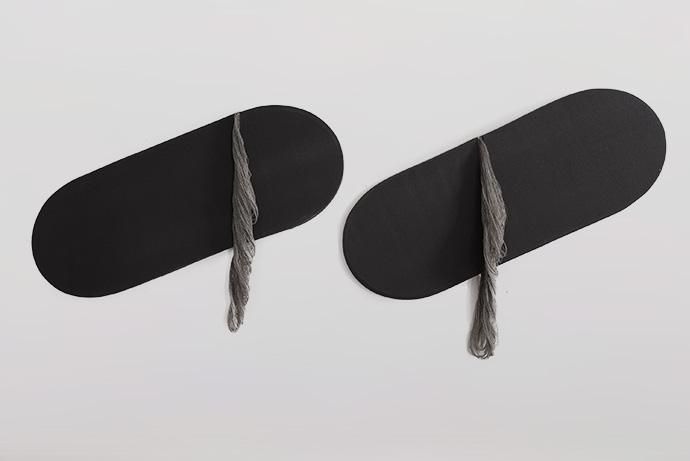
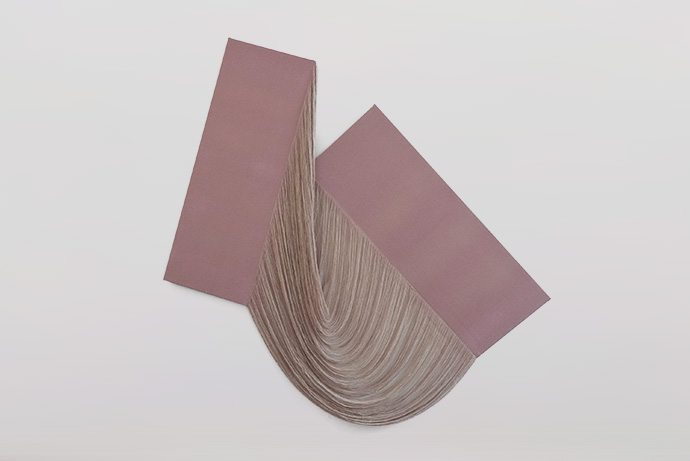
- Top
Untitled
2021
acrylic, graphite, partially unwoven canvas, wood
H84 x W84 x D2 inches
- Middle
Untitled
2021
acrylic, graphite, partially unwoven canvas, wood
H13 x W36 x D3 inches each
- Bottom
Untitled
2021
acrylic, graphite, partially unwoven canvas, wood
H60 x W60 x D2 inches
August 5th - 28th, 2021
Russo Lee Gallery, Portland OR
Untitled
2021
acrylic, graphite, partially unwoven canvas, wood
H84 x W84 x D2 inches
- Middle
Untitled
2021
acrylic, graphite, partially unwoven canvas, wood
H13 x W36 x D3 inches each
- Bottom
Untitled
2021
acrylic, graphite, partially unwoven canvas, wood
H60 x W60 x D2 inches
August 5th - 28th, 2021
Russo Lee Gallery, Portland OR

Untitled
2021
acrylic, graphite, partially unwoven canvas, wood
H13 x W36 x D3 inches each
August 5th - 28th, 2021
Russo Lee Gallery, Portland OR
2021
acrylic, graphite, partially unwoven canvas, wood
H13 x W36 x D3 inches each
August 5th - 28th, 2021
Russo Lee Gallery, Portland OR

Untitled
2021
acrylic, graphite, partially unwoven canvas, wood
H60 x W60 x D2 inches
August 5th - 28th, 2021
Russo Lee Gallery, Portland OR
2021
acrylic, graphite, partially unwoven canvas, wood
H60 x W60 x D2 inches
August 5th - 28th, 2021
Russo Lee Gallery, Portland OR
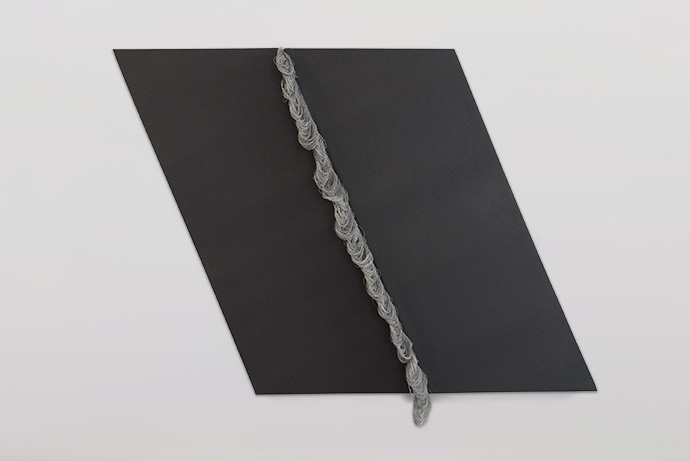
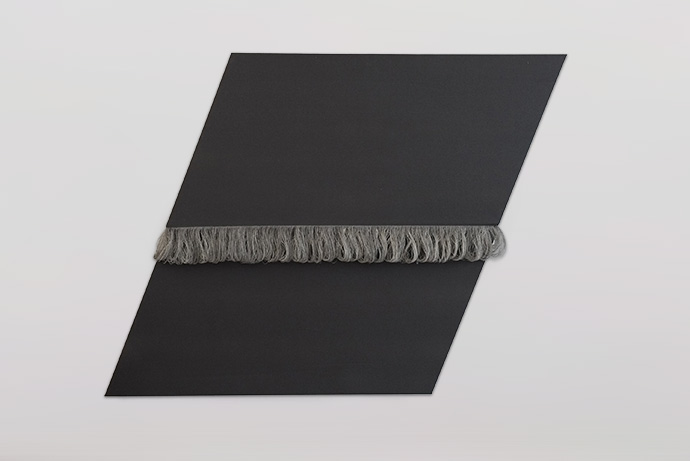
- Top
Untitled
2021
acrylic, graphite, partially unwoven canvas, wood
H40 x W54 x D3 inches
- Bottom
Untitled
2021
acrylic, graphite, partially unwoven canvas, wood
H40 x W54 x D3 inches
August 5th - 28th, 2021
Russo Lee Gallery, Portland OR
Untitled
2021
acrylic, graphite, partially unwoven canvas, wood
H40 x W54 x D3 inches
- Bottom
Untitled
2021
acrylic, graphite, partially unwoven canvas, wood
H40 x W54 x D3 inches
August 5th - 28th, 2021
Russo Lee Gallery, Portland OR

This is my own idiosyncratic way of thinking, but I feel that in perceiving the micro, the existence of the macro too is revealed; and the reverse remains true as well. Nothing particularly special defines this relationship; it applies to many things. Past and future, for instance. Light and shadow. It may apply even to creation and destruction, yet I would suggest something of a more multifaceted nature characterizes this relationship.
From point to line - line to curve - curve to circle - circle to point. All equivalent, all differing.
And here, I suspect, a circle-circle perspective may apply more readily than point-point. I will personally suggest, therefore, deconstruction and reconstruction in the place of creation and destruction. Either, of course, pertains to opposing (relative) elements, a relationship to which the concept I have just touched on will apply.
From what aspect is perception approached? From what angle? At what time? In what way? My sense is that opposing (relative) elements are always associated with equivalent senses of distance, presence, values; they mutually complement each other. This is a perspective of a multifaceted and paradoxical nature. In thinking of things, seeking a grasp of them, a comprehension of them, I’ve come to be intrigued by this sort of relationship between opposing, relative aspects.
Let us delve a bit deeper into multifaceted manners of perception. Here, for example, is a book. In front of everyone, I hold it and show it, this book. Within the scope of what can be seen from directly in front, there are many pieces of information to be taken in. Do I hold it with one hand? Both? From the distance between my thumb and index finger, how thick is it? From the movement of muscles in my hand, to a certain extent, how heavy is it? What is written on its cover? Even if not visually perceptible, each of these pieces of information can be composed in one’s mind to enable a grasp of the book’s three-dimensional form.
Considering all this, we might agree that in forming an image of the book in this way, there exist six relevant facets - or six ways of perceiving facets - top, bottom, right, left, front, back. Including, then, the inside of the book, the number comes to seven. Discovering this new dimension, the equivalent of a seventh facet in a sense, we uncover a new sense of mystery as well, in the same manner, I would suggest. What might be inside this book: text in an unknown language, for instance, or photographs or illustrations yet unseen?
Based on what I have just discussed, I would like to now touch on how I arrived at my practice of removing threads from the canvas. I at first was coming to find a mismatch between my technical skill and creativity. In attempting to make up for that gap, everything I tried was turning into processes of addition, in terms of both the work itself and the concept behind it. Everything was becoming bloated. All the information, techniques and time I projected onto the canvas in so many layers gave rise to a sense of doubt and confusion, and this provided me with the impetus to shift my perspective.
Breaking away from a unidirectional mode of thought, I made a fresh reexamination of my approach and my work with a new perspective informed by a consciousness of relative relationships and multifaceted manners of perception. I proceeded to strip away all the layers that covered my work, one by one, until finally what came to be exposed was the existing canvas itself, the common element I had been using all along, revealed now as a starting point.
I experimented with crumpling the existing canvas; stretching it up, down, right, left; rolling it up; pressing it into a mold; dyeing it; freezing it; immersing it in liquid, drying it and watching how it contracts; cutting it crosswise, lengthwise, diagonally; removing threads. I considered every conceivable perspective and aspect I could find. The relationship between thought and action... beyond thought, action; beyond action, thought.
At the moment the constructed object is destroyed, there is revealed a new aspect; new work is given form to. In my process of taking the existing canvas and removing threads, I came to get this sense.
The process of removing threads from the existing canvas - of breaking or destroying it, in a manner of speaking- intentionally creates deformation and slackening to form expressions of curvature and drape in the new aspect that emerges in the existing canvas through the removal of threads from it. Further forms of expression can be achieved by leaving certain sections flat, where threads are left in place, securing certain portions to the frame, and applying these techniques in various combinations. The process of securing portions to the frame is not an absolute requirement, of course, as a comparable effect can be achieved with the canvas alone, relying on the weight of the canvas itself.
This is a paradoxical addition to my outline here, but the process of removing threads to bring out curvature and drape in a piece requires the canvas to first be flipped over. Most of the remaining process, from removing the threads to bring the work together as a finished piece, proceeds with the canvas flipped over in this way.
The relationship between the process of reconstruction and time is profound. I draw on an understanding of specific characteristics inherent to thread, such as the ways it slackens and deforms, to decide on factors such as the direction in which to remove threads and whether to remove warp or weft threads based on the size and shape of the piece, while repeatedly adjusting parts of the process both intuitive and mathematical.
Finally I would like to touch specifically on this piece. This was strongly informed by a consciousness of flow. Flow as it might relate to waveforms, to the movement of people, to the vibratory nature of the human voice, to natural terrain.
Channeled into this piece is a sense of what I feel here in this place and what I might expect to feel in this building. I drew on rough, abstracted visions of three successive forms that appeared to me as I visualized waveforms to arrive at this piece in three parts that you see. I made a series of fine adjustments to determine the form of the piece, envisioning the way visitors might enjoy viewing it from different angles, the overlapping senses of depth in the piece and various new aspects that emerge from the overlapping of its parts. Regarding color, I referenced the primary colors of the CMY model. Finally, I imagined places’ or buildings’ sense of ambience, the overall interior balance, the people who might come in and out the space, or who might spend a length of time there to settle on factors such as the shape, size and color of the work.
The whole piece can be viewed from directly below, from the same height as the work, and from various angles: front, back, left, right. It is exhibited parallel to the large window in the hope that visitors might enjoy the look of transparency it takes on as the sunlight shines through, the shifting interplay of shadows in and around it, and the countless combinations of other new factors that might emerge with the passage of time.
When a new aspect is revealed, I feel, a sense of mystery is found to be concealed between this aspect and another that cannot be controlled with intentionality. This may be an extreme perspective, but I tend to wonder if aspect itself might finally vanish and be revealed as something akin to the sphere. Point shifts from plane to sphere, and in the way the point appears depending on the angle of viewing, the sphere may be an endpoint and may be a starting point as well.
Meta at Spring District Block 16, Bellevue WA
From point to line - line to curve - curve to circle - circle to point. All equivalent, all differing.
And here, I suspect, a circle-circle perspective may apply more readily than point-point. I will personally suggest, therefore, deconstruction and reconstruction in the place of creation and destruction. Either, of course, pertains to opposing (relative) elements, a relationship to which the concept I have just touched on will apply.
From what aspect is perception approached? From what angle? At what time? In what way? My sense is that opposing (relative) elements are always associated with equivalent senses of distance, presence, values; they mutually complement each other. This is a perspective of a multifaceted and paradoxical nature. In thinking of things, seeking a grasp of them, a comprehension of them, I’ve come to be intrigued by this sort of relationship between opposing, relative aspects.
Let us delve a bit deeper into multifaceted manners of perception. Here, for example, is a book. In front of everyone, I hold it and show it, this book. Within the scope of what can be seen from directly in front, there are many pieces of information to be taken in. Do I hold it with one hand? Both? From the distance between my thumb and index finger, how thick is it? From the movement of muscles in my hand, to a certain extent, how heavy is it? What is written on its cover? Even if not visually perceptible, each of these pieces of information can be composed in one’s mind to enable a grasp of the book’s three-dimensional form.
Considering all this, we might agree that in forming an image of the book in this way, there exist six relevant facets - or six ways of perceiving facets - top, bottom, right, left, front, back. Including, then, the inside of the book, the number comes to seven. Discovering this new dimension, the equivalent of a seventh facet in a sense, we uncover a new sense of mystery as well, in the same manner, I would suggest. What might be inside this book: text in an unknown language, for instance, or photographs or illustrations yet unseen?
Based on what I have just discussed, I would like to now touch on how I arrived at my practice of removing threads from the canvas. I at first was coming to find a mismatch between my technical skill and creativity. In attempting to make up for that gap, everything I tried was turning into processes of addition, in terms of both the work itself and the concept behind it. Everything was becoming bloated. All the information, techniques and time I projected onto the canvas in so many layers gave rise to a sense of doubt and confusion, and this provided me with the impetus to shift my perspective.
Breaking away from a unidirectional mode of thought, I made a fresh reexamination of my approach and my work with a new perspective informed by a consciousness of relative relationships and multifaceted manners of perception. I proceeded to strip away all the layers that covered my work, one by one, until finally what came to be exposed was the existing canvas itself, the common element I had been using all along, revealed now as a starting point.
I experimented with crumpling the existing canvas; stretching it up, down, right, left; rolling it up; pressing it into a mold; dyeing it; freezing it; immersing it in liquid, drying it and watching how it contracts; cutting it crosswise, lengthwise, diagonally; removing threads. I considered every conceivable perspective and aspect I could find. The relationship between thought and action... beyond thought, action; beyond action, thought.
At the moment the constructed object is destroyed, there is revealed a new aspect; new work is given form to. In my process of taking the existing canvas and removing threads, I came to get this sense.
The process of removing threads from the existing canvas - of breaking or destroying it, in a manner of speaking- intentionally creates deformation and slackening to form expressions of curvature and drape in the new aspect that emerges in the existing canvas through the removal of threads from it. Further forms of expression can be achieved by leaving certain sections flat, where threads are left in place, securing certain portions to the frame, and applying these techniques in various combinations. The process of securing portions to the frame is not an absolute requirement, of course, as a comparable effect can be achieved with the canvas alone, relying on the weight of the canvas itself.
This is a paradoxical addition to my outline here, but the process of removing threads to bring out curvature and drape in a piece requires the canvas to first be flipped over. Most of the remaining process, from removing the threads to bring the work together as a finished piece, proceeds with the canvas flipped over in this way.
The relationship between the process of reconstruction and time is profound. I draw on an understanding of specific characteristics inherent to thread, such as the ways it slackens and deforms, to decide on factors such as the direction in which to remove threads and whether to remove warp or weft threads based on the size and shape of the piece, while repeatedly adjusting parts of the process both intuitive and mathematical.
Finally I would like to touch specifically on this piece. This was strongly informed by a consciousness of flow. Flow as it might relate to waveforms, to the movement of people, to the vibratory nature of the human voice, to natural terrain.
Channeled into this piece is a sense of what I feel here in this place and what I might expect to feel in this building. I drew on rough, abstracted visions of three successive forms that appeared to me as I visualized waveforms to arrive at this piece in three parts that you see. I made a series of fine adjustments to determine the form of the piece, envisioning the way visitors might enjoy viewing it from different angles, the overlapping senses of depth in the piece and various new aspects that emerge from the overlapping of its parts. Regarding color, I referenced the primary colors of the CMY model. Finally, I imagined places’ or buildings’ sense of ambience, the overall interior balance, the people who might come in and out the space, or who might spend a length of time there to settle on factors such as the shape, size and color of the work.
The whole piece can be viewed from directly below, from the same height as the work, and from various angles: front, back, left, right. It is exhibited parallel to the large window in the hope that visitors might enjoy the look of transparency it takes on as the sunlight shines through, the shifting interplay of shadows in and around it, and the countless combinations of other new factors that might emerge with the passage of time.
When a new aspect is revealed, I feel, a sense of mystery is found to be concealed between this aspect and another that cannot be controlled with intentionality. This may be an extreme perspective, but I tend to wonder if aspect itself might finally vanish and be revealed as something akin to the sphere. Point shifts from plane to sphere, and in the way the point appears depending on the angle of viewing, the sphere may be an endpoint and may be a starting point as well.
Meta at Spring District Block 16, Bellevue WA





Untitled
2021
acrylic, graphite, partially unwoven canvas, wood
H57 x W180 x D15 inches each each
This hanging triptych is a masterful exploration of color, form, and the ephemeral. The three pieces act as a profound reference to the primary color models of cyan, magenta, and yellow, establishing a vibrant chromatic foundation. Beyond their color, the works also challenge traditional notions of shape, visualizing it as a dynamic waveform composed of continuous, rhythmic movements. Each piece is thoughtfully divided into three distinct patterns, creating a complex visual narrative.
The power of this installation lies in its dynamic arrangement. When the pieces are configured side by side, a subtle interplay of overlapping colors and shapes comes into view. This is further enhanced by fleeting, unpredictable aspects that emerge from the environment itself—the reflection of light and the gentle flow of air. These external forces are not obstacles to the work but integral to it, revealing hidden aspects and shifting relationships between the pieces that cannot be intentionally controlled. My approach involves embracing this element of chance, allowing the work to exist in a state of constant, fluid transformation, and offering a unique and ever-changing experience with each viewing.
*Meta - Spring District Block 16, Bellevue WA - Image courtesy of Meta / Photo: Meta Open Arts
2021
acrylic, graphite, partially unwoven canvas, wood
H57 x W180 x D15 inches each each
This hanging triptych is a masterful exploration of color, form, and the ephemeral. The three pieces act as a profound reference to the primary color models of cyan, magenta, and yellow, establishing a vibrant chromatic foundation. Beyond their color, the works also challenge traditional notions of shape, visualizing it as a dynamic waveform composed of continuous, rhythmic movements. Each piece is thoughtfully divided into three distinct patterns, creating a complex visual narrative.
The power of this installation lies in its dynamic arrangement. When the pieces are configured side by side, a subtle interplay of overlapping colors and shapes comes into view. This is further enhanced by fleeting, unpredictable aspects that emerge from the environment itself—the reflection of light and the gentle flow of air. These external forces are not obstacles to the work but integral to it, revealing hidden aspects and shifting relationships between the pieces that cannot be intentionally controlled. My approach involves embracing this element of chance, allowing the work to exist in a state of constant, fluid transformation, and offering a unique and ever-changing experience with each viewing.
*Meta - Spring District Block 16, Bellevue WA - Image courtesy of Meta / Photo: Meta Open Arts
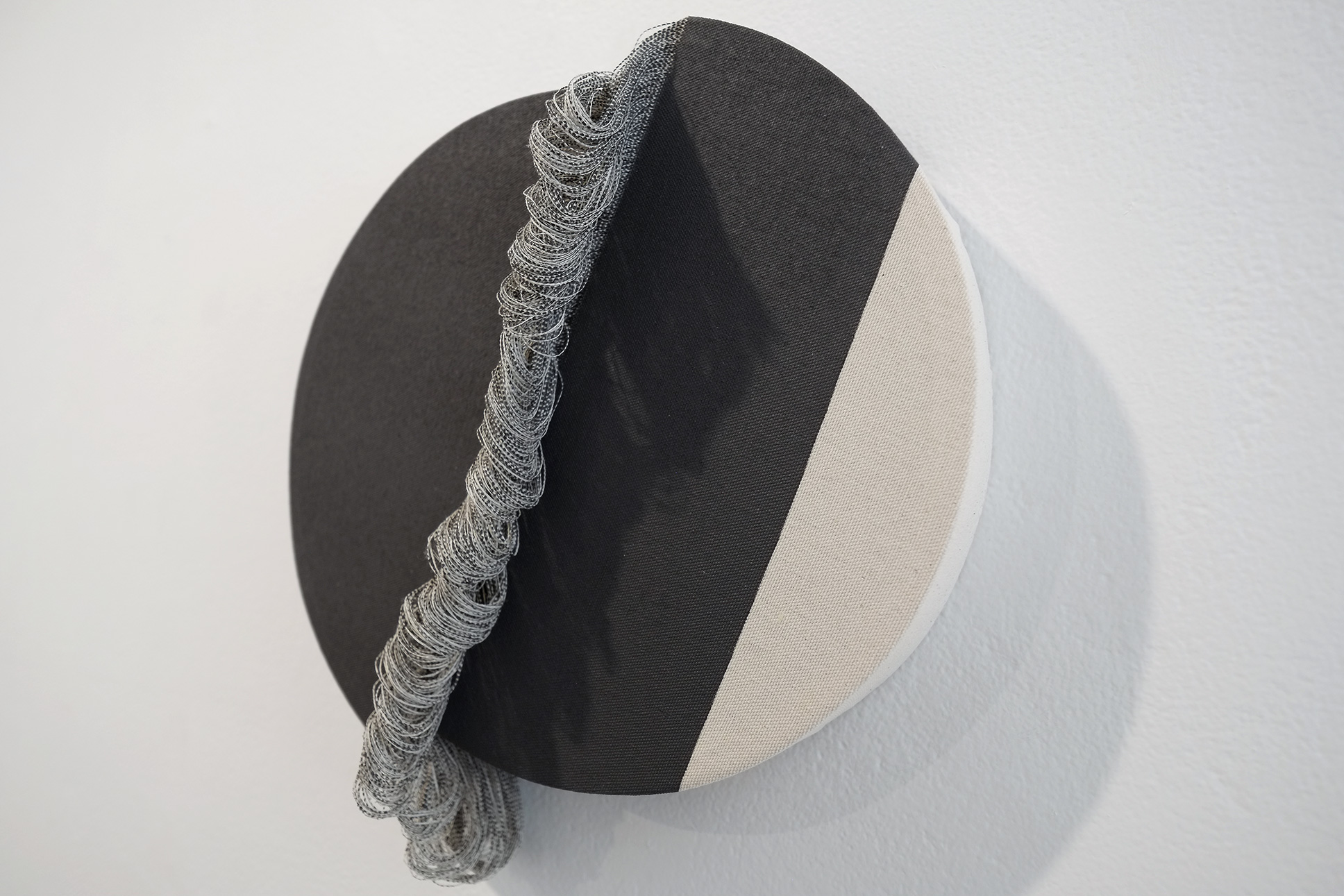



- Bottom
From left to right
Untitled
2019
paper, ink, artist frame
H16 x W13 x D2 inches
Untitled
2021
acrylic, graphite, partially unwoven canvas, wood
H57 x W7 x D2 inches
Untitled
2021
acrylic, graphite, partially unwoven canvas, wood
H16 x 60 x D2 inches
Untitled
2021
H32 x W9 x D2 inches
acrylic, graphite, partially unwoven canvas, wood
Untitled
2021
acrylic, graphite, partially unwoven canvas, wood
H13.5 x W12.5 x D5.5 inches
June 3rd - 26th, 2021
"New Works" at Soil Gallery, Seattle WA
From left to right
Untitled
2019
paper, ink, artist frame
H16 x W13 x D2 inches
Untitled
2021
acrylic, graphite, partially unwoven canvas, wood
H57 x W7 x D2 inches
Untitled
2021
acrylic, graphite, partially unwoven canvas, wood
H16 x 60 x D2 inches
Untitled
2021
H32 x W9 x D2 inches
acrylic, graphite, partially unwoven canvas, wood
Untitled
2021
acrylic, graphite, partially unwoven canvas, wood
H13.5 x W12.5 x D5.5 inches
June 3rd - 26th, 2021
"New Works" at Soil Gallery, Seattle WA

Emily Counts & Ko Kirk Yamahira
“We both are creating bridges, loops and connections,” says Emily Counts, adding: “We want to bring happiness to the viewer.” Indeed, the current show manifests the artists’ understanding of art as a playground, where both meditative and hands-on experiences are fused in the joyful and tranquil presence of their art pieces. The artwork on display showcases the artists’ craft and sensitivity, offering intriguing, multifaceted ways of viewing. Each artist chooses an approach that may seem radically different (Counts focuses on connectivity, joining apparently incongruous objects into relationship chains, whereas Yamahira fashions solitary abstract objects by picking apart woven canvas threads and re-threading those on their re-composed frames). But as the dissimilar pieces communicate with one another, they reach a level of uncanny and profound intimacy, wielding the notion of belonging, togetherness and oneness: the core of true happiness for many, and a poignant message for current times.
- Elena Deem
https://studioegallery.net/Emily-Counts-Ko-Kirk-Yamahira
- Right
Untitled
2021
acrylic, graphite, partially unwoven canvas, wood
H60 x W100 x D2 inches
July 17th – Sept 12th, 2020
"Emily Counts & Ko Kirk Yamahira" at studio e gallery, Seattle WA
“We both are creating bridges, loops and connections,” says Emily Counts, adding: “We want to bring happiness to the viewer.” Indeed, the current show manifests the artists’ understanding of art as a playground, where both meditative and hands-on experiences are fused in the joyful and tranquil presence of their art pieces. The artwork on display showcases the artists’ craft and sensitivity, offering intriguing, multifaceted ways of viewing. Each artist chooses an approach that may seem radically different (Counts focuses on connectivity, joining apparently incongruous objects into relationship chains, whereas Yamahira fashions solitary abstract objects by picking apart woven canvas threads and re-threading those on their re-composed frames). But as the dissimilar pieces communicate with one another, they reach a level of uncanny and profound intimacy, wielding the notion of belonging, togetherness and oneness: the core of true happiness for many, and a poignant message for current times.
- Elena Deem
https://studioegallery.net/Emily-Counts-Ko-Kirk-Yamahira
- Right
Untitled
2021
acrylic, graphite, partially unwoven canvas, wood
H60 x W100 x D2 inches
July 17th – Sept 12th, 2020
"Emily Counts & Ko Kirk Yamahira" at studio e gallery, Seattle WA


- Center
Untitled
2020
acrylic, graphite, partially unwoven canvas, wood
H44 x W50 x D2 inches
July 17th – Sept 12th, 2020
"Emily Counts & Ko Kirk Yamahira" at studio e gallery, Seattle WA
Untitled
2020
acrylic, graphite, partially unwoven canvas, wood
H44 x W50 x D2 inches
July 17th – Sept 12th, 2020
"Emily Counts & Ko Kirk Yamahira" at studio e gallery, Seattle WA


- Center
Untitled
2020
acrylic, graphite, partially unwoven canvas, wood
H36 x W36 x D2 inches
July 17th – Sept 12th, 2020
"Emily Counts & Ko Kirk Yamahira" at studio e gallery, Seattle WA
Untitled
2020
acrylic, graphite, partially unwoven canvas, wood
H36 x W36 x D2 inches
July 17th – Sept 12th, 2020
"Emily Counts & Ko Kirk Yamahira" at studio e gallery, Seattle WA


Top - Center
Untitled
2020
acrylic, graphite, partially unwoven canvas, wood
H80 x W90 x D2 inches
Top - Right and bottom
Untitled
2020
acrylic, graphite, partially unwoven canvas, wood
H30 x W30 x D2 inches each
July 17th – Sept 12th, 2020
"Emily Counts & Ko Kirk Yamahira" at studio e gallery, Seattle WA
Untitled
2020
acrylic, graphite, partially unwoven canvas, wood
H80 x W90 x D2 inches
Top - Right and bottom
Untitled
2020
acrylic, graphite, partially unwoven canvas, wood
H30 x W30 x D2 inches each
July 17th – Sept 12th, 2020
"Emily Counts & Ko Kirk Yamahira" at studio e gallery, Seattle WA
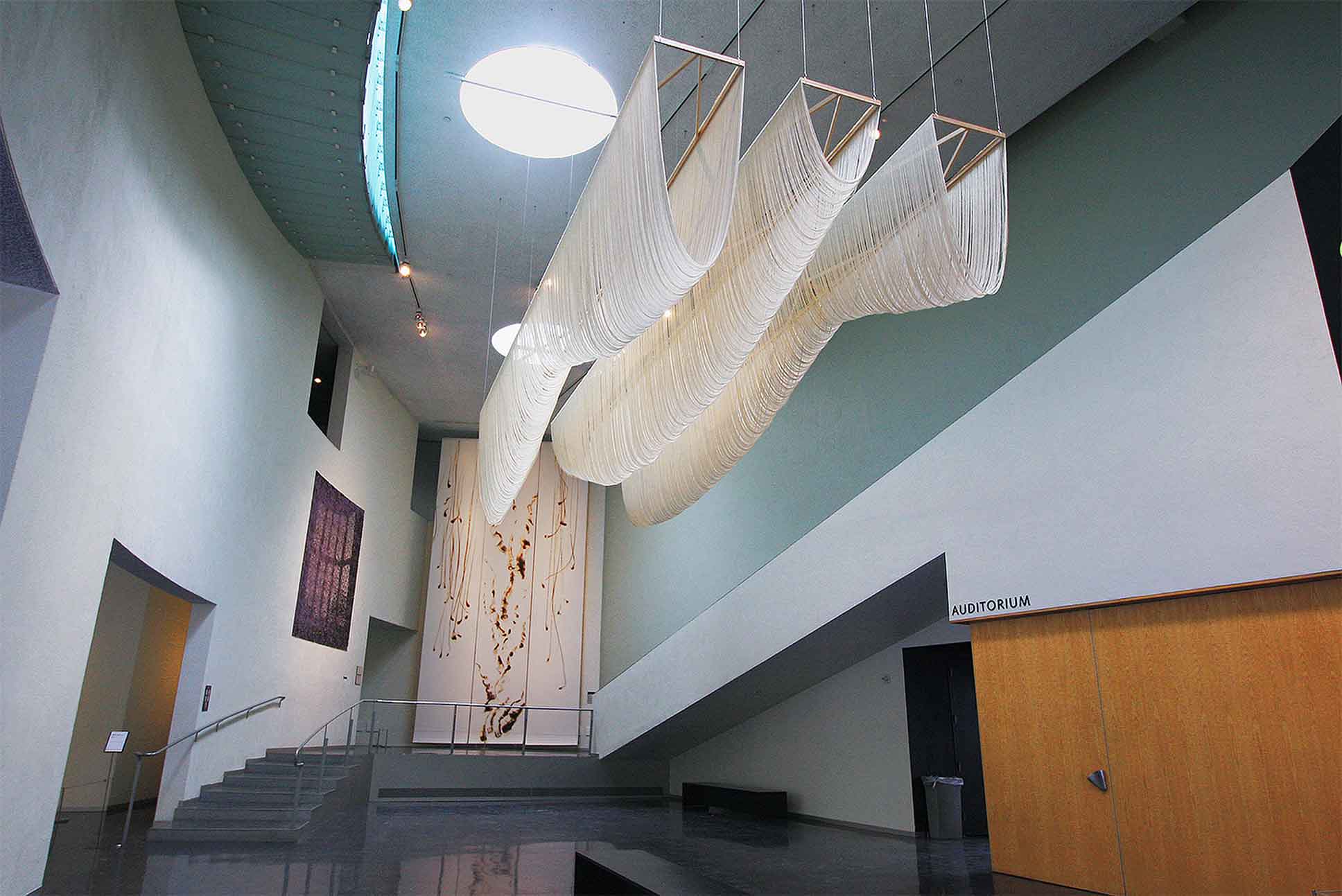

Untitled
2018
Partially unwoven canvas, wood
H80 x W280 x D24 inches each
In dialogue with Steven Holl's phenomenological design principles and his architectural concept of "tripleness," artist Ko Kirk Yamahira thoughtfully developed a large-scale, suspended installation for the Bellevue Arts Museum. This work was conceived as a deeply personal introspection and an elegant reconstruction of the fluid relationship between light, time, and space that the building was respectfully designed to embody.
The piece, which features three gracefully overlapping arcs, was carefully positioned within the museum's central elliptical atrium, known as the Forum. It was delicately designed to be experienced from multiple, dynamic perspectives as visitors gently move through the space, harmoniously mirroring the building's own kind invitation to "see, explore, and make art."
As one encounters the work - perhaps from directly below on the ground floor, from various sides while ascending the gently curving stairs, or from the galleries above - their perception of the artwork is intended to be in constant, subtle flux. This thoughtful and dynamic interaction between the esteemed viewer, the artist's respectful expression, and the magnificent architecture itself offers a truly multi-layered experience, one that is deeply rooted in the museum's considered design philosophy.
*Bellevue Arts Museum designed by architect Steven Holl
Bellevue Arts Museum, Bellevue WA
2018
Partially unwoven canvas, wood
H80 x W280 x D24 inches each
In dialogue with Steven Holl's phenomenological design principles and his architectural concept of "tripleness," artist Ko Kirk Yamahira thoughtfully developed a large-scale, suspended installation for the Bellevue Arts Museum. This work was conceived as a deeply personal introspection and an elegant reconstruction of the fluid relationship between light, time, and space that the building was respectfully designed to embody.
The piece, which features three gracefully overlapping arcs, was carefully positioned within the museum's central elliptical atrium, known as the Forum. It was delicately designed to be experienced from multiple, dynamic perspectives as visitors gently move through the space, harmoniously mirroring the building's own kind invitation to "see, explore, and make art."
As one encounters the work - perhaps from directly below on the ground floor, from various sides while ascending the gently curving stairs, or from the galleries above - their perception of the artwork is intended to be in constant, subtle flux. This thoughtful and dynamic interaction between the esteemed viewer, the artist's respectful expression, and the magnificent architecture itself offers a truly multi-layered experience, one that is deeply rooted in the museum's considered design philosophy.
*Bellevue Arts Museum designed by architect Steven Holl
Bellevue Arts Museum, Bellevue WA
Ko Kirk Yamahira's sculptures at BAM were created by meticulously unravelling, parting, and disentangling a single sheet of artist's canvas.
Take a quick virtual trip to Bellevue Arts Museum! In today’s curator talk, BAM’s Executive Director & Chief Curator discusses 'Untitled' by Ko Kirk Yamahira, and how the work is a meditation on artmaking.
Take a quick virtual trip to Bellevue Arts Museum! In today’s curator talk, BAM’s Executive Director & Chief Curator discusses 'Untitled' by Ko Kirk Yamahira, and how the work is a meditation on artmaking.
Fiber 2020
Fiber 2020 explores diverse ways artists are working in fiber and textiles. Over thirty-five artists are featured in this large group exhibition, from traditional fiber arts through contemporary works and installations. Media include lace, embroidery, quilts, wearables — reconstituted and repurposed objects — conceptual sculptures and art installations.
https://www.biartmuseum.org/exhibitions/fiber-2020/
March 6th – December 31st, 2020
Fiber 2020 - Bainbridge Island Museum of Art, Feferman Gallery, Bainbridge Island WA
*From about 1 minute and 35seconds
Untitled
2020
acrylic, graphite, partially unwoven canvas, wood
H50 x W60 x D2 inches
Fiber 2020 explores diverse ways artists are working in fiber and textiles. Over thirty-five artists are featured in this large group exhibition, from traditional fiber arts through contemporary works and installations. Media include lace, embroidery, quilts, wearables — reconstituted and repurposed objects — conceptual sculptures and art installations.
https://www.biartmuseum.org/exhibitions/fiber-2020/
March 6th – December 31st, 2020
Fiber 2020 - Bainbridge Island Museum of Art, Feferman Gallery, Bainbridge Island WA
*From about 1 minute and 35seconds
Untitled
2020
acrylic, graphite, partially unwoven canvas, wood
H50 x W60 x D2 inches

*Installation view - left to right
- Left
Untitled
2019
acrylic, graphite, partially unwoven canvas, wood
H91 x W91 x D3 inches
- Right
Untitled
2019
acrylic, graphite, partially unwoven canvas, wood
H91 x W91 x D3 inches
CFJC - Judge Patricia H. Clark Children and Family Justice Center
Image courtesy of the King County Public Art Collection, Photo: Joe Freeman Jr.
- Left
Untitled
2019
acrylic, graphite, partially unwoven canvas, wood
H91 x W91 x D3 inches
- Right
Untitled
2019
acrylic, graphite, partially unwoven canvas, wood
H91 x W91 x D3 inches
CFJC - Judge Patricia H. Clark Children and Family Justice Center
Image courtesy of the King County Public Art Collection, Photo: Joe Freeman Jr.




- Above
- Left to right
Untitled
2019
silkscreen, acrylic, graphite, partially unwoven canvas, wood
H40 x W80 inches
Untitled
2019
H80 x W130 x D2 inches
acrylic, graphite, partially unwoven canvas, wood
Untitled
2019
acrylic, graphite, partially unwoven canvas, wood
H46 x W130 x D2 each
Untitled
2019
acrylic, graphite, partially unwoven canvas, wood
H30 x W100 x D5 inches
*left to right from the installation photo above.
January 2nd – February 1st, 2020
fractions at Russo Lee Gallery, Portland OR
- Left to right
Untitled
2019
silkscreen, acrylic, graphite, partially unwoven canvas, wood
H40 x W80 inches
Untitled
2019
H80 x W130 x D2 inches
acrylic, graphite, partially unwoven canvas, wood
Untitled
2019
acrylic, graphite, partially unwoven canvas, wood
H46 x W130 x D2 each
Untitled
2019
acrylic, graphite, partially unwoven canvas, wood
H30 x W100 x D5 inches
*left to right from the installation photo above.
January 2nd – February 1st, 2020
fractions at Russo Lee Gallery, Portland OR



- Top
Untitled
2019
acrylic, graphite, partially unwoven canvas, wood
H46 x W90 x D2 inches
- Bottom
Untitled
2019
silkscreen, acrylic, graphite, partially unwoven canvas, wood
H40 x W80 x D10 inches
Wall-mounted piece, imagery capturing the moment a friend stands up from the sofa, flipped and combined into one, is silkscreened on the canvas, with the weft threads removed from the wooden frame to the left and warp threads removed elsewhere. The combination of fast and slow motion, compression and expansion of the canvas’s threads, and the contrasting removal of warp and weft threads between the left and right sides of the piece yields varied appearances in the work, along with complex, multiple shadows to create a multifaceted mode of surface expression.
November 7th – December 5th, 2019
Gallery 4Culture, Seattle WA
Image courtesy of Gallery 4Culture, Photo: Joe Freeman Jr.
Untitled
2019
acrylic, graphite, partially unwoven canvas, wood
H46 x W90 x D2 inches
- Bottom
Untitled
2019
silkscreen, acrylic, graphite, partially unwoven canvas, wood
H40 x W80 x D10 inches
Wall-mounted piece, imagery capturing the moment a friend stands up from the sofa, flipped and combined into one, is silkscreened on the canvas, with the weft threads removed from the wooden frame to the left and warp threads removed elsewhere. The combination of fast and slow motion, compression and expansion of the canvas’s threads, and the contrasting removal of warp and weft threads between the left and right sides of the piece yields varied appearances in the work, along with complex, multiple shadows to create a multifaceted mode of surface expression.
November 7th – December 5th, 2019
Gallery 4Culture, Seattle WA
Image courtesy of Gallery 4Culture, Photo: Joe Freeman Jr.

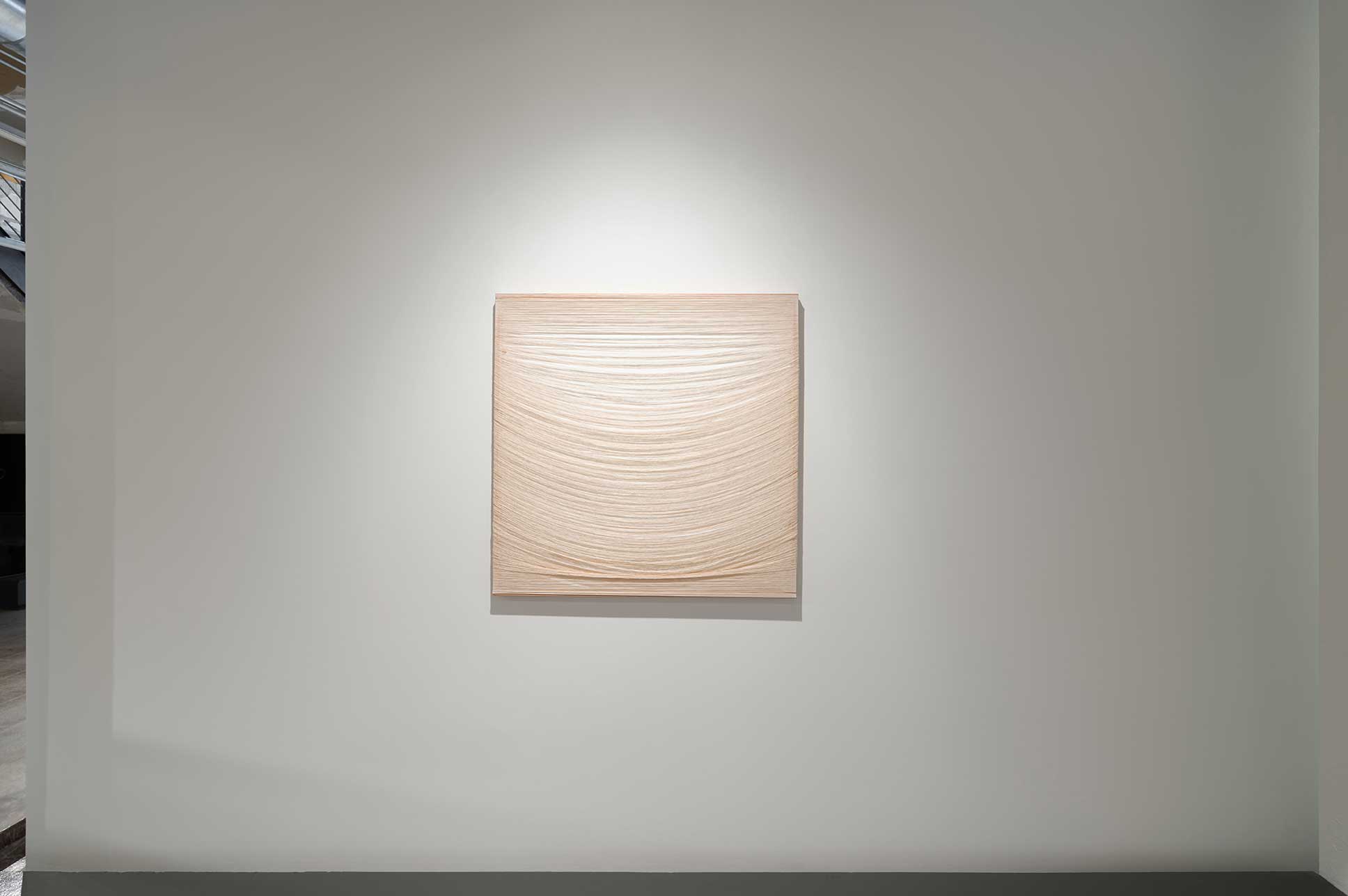
- Top
Untitled
2019
acrylic, graphite, partially unwoven canvas
H50 x W90 x D8 inches
- Bottom
Untitled
2019
acrylic, graphite, partially unwoven canvas, wood
H41 x W41 x D2 inches
November 7th – December 5th, 2019
Gallery 4Culture, Seattle WA
Image courtesy of Gallery 4Culture, Photo: Joe Freeman Jr.
Untitled
2019
acrylic, graphite, partially unwoven canvas
H50 x W90 x D8 inches
- Bottom
Untitled
2019
acrylic, graphite, partially unwoven canvas, wood
H41 x W41 x D2 inches
November 7th – December 5th, 2019
Gallery 4Culture, Seattle WA
Image courtesy of Gallery 4Culture, Photo: Joe Freeman Jr.


- Top
Left
Untitled
2019
acrylic, graphite, partially unwoven canvas, wood
H46 x W130 x D2 inches
Right
Untitled
2019
acrylic, graphite, partially unwoven canvas, wood
H60 x W180 x D9 inches
November 7th – December 5th, 2019
Gallery 4Culture, Seattle WA
Image courtesy of Gallery 4Culture, Photo: Joe Freeman Jr.
Left
Untitled
2019
acrylic, graphite, partially unwoven canvas, wood
H46 x W130 x D2 inches
Right
Untitled
2019
acrylic, graphite, partially unwoven canvas, wood
H60 x W180 x D9 inches
November 7th – December 5th, 2019
Gallery 4Culture, Seattle WA
Image courtesy of Gallery 4Culture, Photo: Joe Freeman Jr.

In 2019, my solo exhibition at the non-profit Deluge Contemporary Art in Victoria, BC, was a culmination of artistic inquiry. This installation photograph, taken from the front of the gallery, captures the harmonious interplay of diverse works. The gallery, a vibrant space nestled in the heart of Victoria, is a wonderful and international setting, easily accessible by ferry from Seattle, which contributed to the experience. Pieces of varying styles—including wall-mounted, suspended, and framed works—converged to create a rich visual dialogue, even incorporating readings to extend the conversation beyond static objects.
While each piece was born from distinct visual and technical processes, a consistent thematic thread united them all. The collective installation allowed viewers to trace the singular idea that manifested in multiple forms, inviting a deeper consideration of the creative process itself. This synthesis of diversity and unity transformed the exhibition into more than a display of objects; it was a cohesive statement, an immersive experience where every element reinforced the core concept. The resulting atmosphere was a sincere testament to the power of a consistent artistic vision, revealed through varied and deliberate execution.
While each piece was born from distinct visual and technical processes, a consistent thematic thread united them all. The collective installation allowed viewers to trace the singular idea that manifested in multiple forms, inviting a deeper consideration of the creative process itself. This synthesis of diversity and unity transformed the exhibition into more than a display of objects; it was a cohesive statement, an immersive experience where every element reinforced the core concept. The resulting atmosphere was a sincere testament to the power of a consistent artistic vision, revealed through varied and deliberate execution.

I was hoping to find something that could be shared between us;
just something minor is what I had in mind.
I thought I would take this time to give a reading of my words, if I may, in my own voice.
So, to begin now:
Right now as I’m forming the words in my mind,
the future they are meant for has not yet arrived -
and right now, as I stand before you reading those words,
that future has become this present moment.
(And that too is already past.)
What do you feel as you hold this paper in your hands? What do you feel as you read these words of mine, and not in my voice but in the voice of your own? Can you get a sense of it, I wonder? Can you get a sense of the sort of index of time that exists there; that exists in this present moment of now, on paper, between me and you?
You see: the future there is already something nostalgic for me, while for you reading my words, that past is something new. This might be a sudden shift, but: Vibrations. They are just purely captivating. Wavering and trembling. Continuous, sustained and momentary. Sensual and sensory. Ripples that are static or dynamic. Sound and voice. The place where I was raised was by the seashore. That’s a relevant fact, it seems, but it might not be. Or irrelevant then, but it might not be that either.
My intention here is to offer a glimpse of some part of myself, and I might employ some rhetoric along the way. I don’t know how much of the substance I will be able to convey. Not all perhaps, but perhaps some, or maybe I’ll just feel I’ve gotten the drift myself. Even when we’re virtually face to face, or close enough to be knee to knee, as one might say, we often rely on satellites drifting in space to relay our messages back and forth. That has gotten to be such a common approach these days, and whether that’s for better or for worse is a topic for another day… But there is one thing I can add about that: The use of an emoticon, or maybe a smiley face sticker, can really smooth out communication in certain situations.
And now you might be wondering: when will I be lifting my face up? I understand you might wonder… and don’t mean to be impolite. There’s an obvious contrast between the type of communication I’ve just described, with the reliance on technology that is so common now. And yet… it does seem that there is one common thread between them: You’re not able to see my face while I’m talking now either. Let me offer a word of explanation for you, the reader who is not in attendance now: I’m standing in front of visitors who’ve come to the opening reception, and I’m shoegazing, as they say, as I read out loud these words I’ve written. I tend to get nervous, and I’m poor at conversation. To make a statement like that, though, before there’s been a chance for the conversation to begin, is to shut a door and might discourage you from approaching me. But there’s a simple question I wonder about: Are any of us really completely comfortable talking to people we’re meeting for the first time?
Is it possible that the people who are the most sociable, talking and laughing non-stop, might also be the ones who are less comfortable, in some sense, filling in every gap in the conversation to avoid having a wordless moment? There are two sides to the coin, and this is like a doorway into a labyrinth of such observations.
Dots, assembled, produce the Line, the Line forms a Circle, and the Circle too forms a Dot.
If one recognizes that everything is interconnected like this, then it might be knowing oneself that offers a guidepost, or a first step towards unlocking a door. Do we want to know the answer? Will we find out? Will we stay in the dark? Will we just pretend to know? Is it even meaningful to know? Is meaning something that can be found? Is it merely a waypoint? Despite what we might expect, is it no big deal? Will we be happier not to know? And what is happiness anyway? To not understand is to understand, and to understand is to not understand. What is it that we might actually grasp? And what are we ourselves? Before we even know it, we might find ourselves on the outside looking in.
This might come as a sudden shift again, but I would like to add an observation: Expressions of appreciation have beauty, even just the ring they have, and I imagine that must be true in any language. So to you who are listening to my voice now: Thank you. To you who have read this far ahead of me: Thank you. To you who have come at a later time, taken this paper in your hand and read through to this point: I’m pleased to meet you, and thank you too. That you have given me the opportunity to share this time with you, I am very grateful. This has been me and my voice.
March 8th – April 6th, 2019
Deluge Contemporary Art, Victoria BC
What do you feel as you hold this paper in your hands? What do you feel as you read these words of mine, and not in my voice but in the voice of your own? Can you get a sense of it, I wonder? Can you get a sense of the sort of index of time that exists there; that exists in this present moment of now, on paper, between me and you?
You see: the future there is already something nostalgic for me, while for you reading my words, that past is something new. This might be a sudden shift, but: Vibrations. They are just purely captivating. Wavering and trembling. Continuous, sustained and momentary. Sensual and sensory. Ripples that are static or dynamic. Sound and voice. The place where I was raised was by the seashore. That’s a relevant fact, it seems, but it might not be. Or irrelevant then, but it might not be that either.
My intention here is to offer a glimpse of some part of myself, and I might employ some rhetoric along the way. I don’t know how much of the substance I will be able to convey. Not all perhaps, but perhaps some, or maybe I’ll just feel I’ve gotten the drift myself. Even when we’re virtually face to face, or close enough to be knee to knee, as one might say, we often rely on satellites drifting in space to relay our messages back and forth. That has gotten to be such a common approach these days, and whether that’s for better or for worse is a topic for another day… But there is one thing I can add about that: The use of an emoticon, or maybe a smiley face sticker, can really smooth out communication in certain situations.
And now you might be wondering: when will I be lifting my face up? I understand you might wonder… and don’t mean to be impolite. There’s an obvious contrast between the type of communication I’ve just described, with the reliance on technology that is so common now. And yet… it does seem that there is one common thread between them: You’re not able to see my face while I’m talking now either. Let me offer a word of explanation for you, the reader who is not in attendance now: I’m standing in front of visitors who’ve come to the opening reception, and I’m shoegazing, as they say, as I read out loud these words I’ve written. I tend to get nervous, and I’m poor at conversation. To make a statement like that, though, before there’s been a chance for the conversation to begin, is to shut a door and might discourage you from approaching me. But there’s a simple question I wonder about: Are any of us really completely comfortable talking to people we’re meeting for the first time?
Is it possible that the people who are the most sociable, talking and laughing non-stop, might also be the ones who are less comfortable, in some sense, filling in every gap in the conversation to avoid having a wordless moment? There are two sides to the coin, and this is like a doorway into a labyrinth of such observations.
Dots, assembled, produce the Line, the Line forms a Circle, and the Circle too forms a Dot.
If one recognizes that everything is interconnected like this, then it might be knowing oneself that offers a guidepost, or a first step towards unlocking a door. Do we want to know the answer? Will we find out? Will we stay in the dark? Will we just pretend to know? Is it even meaningful to know? Is meaning something that can be found? Is it merely a waypoint? Despite what we might expect, is it no big deal? Will we be happier not to know? And what is happiness anyway? To not understand is to understand, and to understand is to not understand. What is it that we might actually grasp? And what are we ourselves? Before we even know it, we might find ourselves on the outside looking in.
This might come as a sudden shift again, but I would like to add an observation: Expressions of appreciation have beauty, even just the ring they have, and I imagine that must be true in any language. So to you who are listening to my voice now: Thank you. To you who have read this far ahead of me: Thank you. To you who have come at a later time, taken this paper in your hand and read through to this point: I’m pleased to meet you, and thank you too. That you have given me the opportunity to share this time with you, I am very grateful. This has been me and my voice.
March 8th – April 6th, 2019
Deluge Contemporary Art, Victoria BC

Untitled
2019
acrylic, graphite, partially unwoven canvas, wood
H46 x W45 x D3 inches
Wall-mounted piece, the widths of the flat surface and the surface with the threads removed are paired, allowing the piece to expand horizontally in an arc as it alternates between them. Also, the tension in the threads causes them to arrange themselves in a ring shape, creating difference in height and depth.
*The piece was seleted for The Microsoft Collection Art Collection
March 8th – April 6th, 2019
Deluge Contemporary Art, Victoria BC
2019
acrylic, graphite, partially unwoven canvas, wood
H46 x W45 x D3 inches
Wall-mounted piece, the widths of the flat surface and the surface with the threads removed are paired, allowing the piece to expand horizontally in an arc as it alternates between them. Also, the tension in the threads causes them to arrange themselves in a ring shape, creating difference in height and depth.
*The piece was seleted for The Microsoft Collection Art Collection
March 8th – April 6th, 2019
Deluge Contemporary Art, Victoria BC




- From left to right
Untitled
2019
graphite, partially unwoven canvas, wood
H18 x W90 x D6 inches
Untitled
2019
acrylic, graphite, partially unwoven canvas
H41 x W41 x D3 inches
Untitled
2019
acrylic, graphite, partially unwoven canvas, wood
H60 x W100 x D6 inches
Untitled
2019
acrylic, graphite, partially unwoven canvas, wood
H46 x W45 x D3 inches
*The piece was seleted for The Microsoft Collection Art Collection
Untitled
2019
acrylic, graphite, partially unwoven canvas, wood
H18 x W90 x D2 inches
March 8th – April 6th, 2019
Deluge Contemporary Art, Victoria BC
Untitled
2019
graphite, partially unwoven canvas, wood
H18 x W90 x D6 inches
Untitled
2019
acrylic, graphite, partially unwoven canvas
H41 x W41 x D3 inches
Untitled
2019
acrylic, graphite, partially unwoven canvas, wood
H60 x W100 x D6 inches
Untitled
2019
acrylic, graphite, partially unwoven canvas, wood
H46 x W45 x D3 inches
*The piece was seleted for The Microsoft Collection Art Collection
Untitled
2019
acrylic, graphite, partially unwoven canvas, wood
H18 x W90 x D2 inches
March 8th – April 6th, 2019
Deluge Contemporary Art, Victoria BC
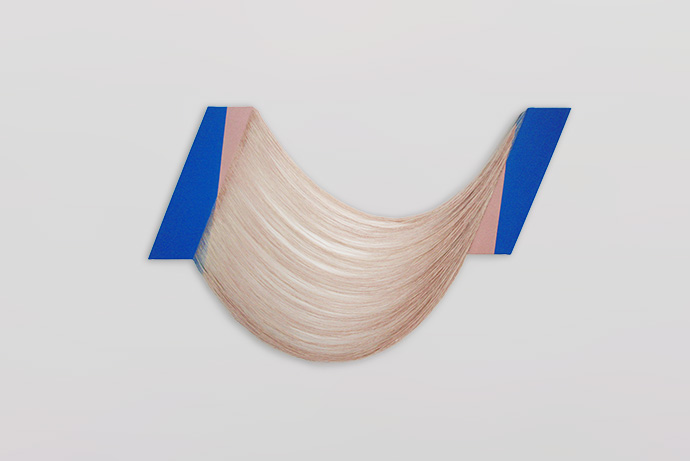
Untitled
2019
acrylic, graphite, partially unwoven canvas, wood
H22 x W58.5 inches
2019
acrylic, graphite, partially unwoven canvas, wood
H22 x W58.5 inches
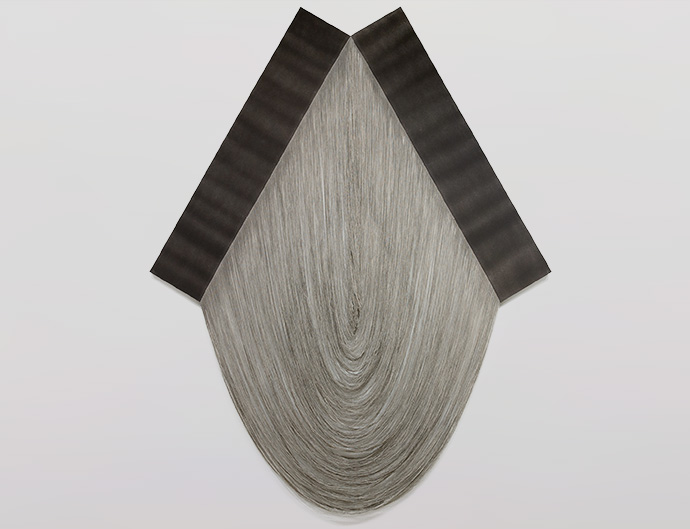
Untitled
2018
acrylic, graphite, partially unwoven canvas, wood
H112 x W89 x D2 inches
October 4th - October 27th, 2018
Russo Lee Gallery, Portland OR
2018
acrylic, graphite, partially unwoven canvas, wood
H112 x W89 x D2 inches
October 4th - October 27th, 2018
Russo Lee Gallery, Portland OR

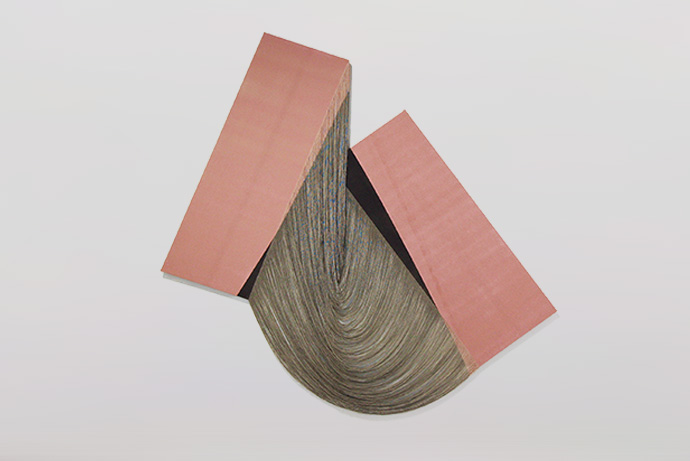
- Bottom
Untitled
2018
acrylic, graphite, partially unwoven canvas, wood
H90 x W113 x D2 inches
October 4th - October 27th, 2018
Russo Lee Gallery, Portland OR
Untitled
2018
acrylic, graphite, partially unwoven canvas, wood
H90 x W113 x D2 inches
October 4th - October 27th, 2018
Russo Lee Gallery, Portland OR
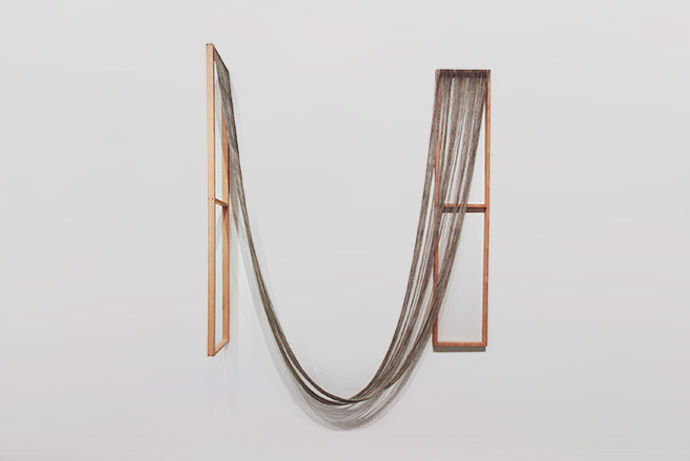
Untitled
2018
acrylic, graphite, partially unwoven canvas, wood H80 x W70 x D6 inches
October 4th - October 27th, 2018
Russo Lee Gallery, Portland OR
2018
acrylic, graphite, partially unwoven canvas, wood H80 x W70 x D6 inches
October 4th - October 27th, 2018
Russo Lee Gallery, Portland OR

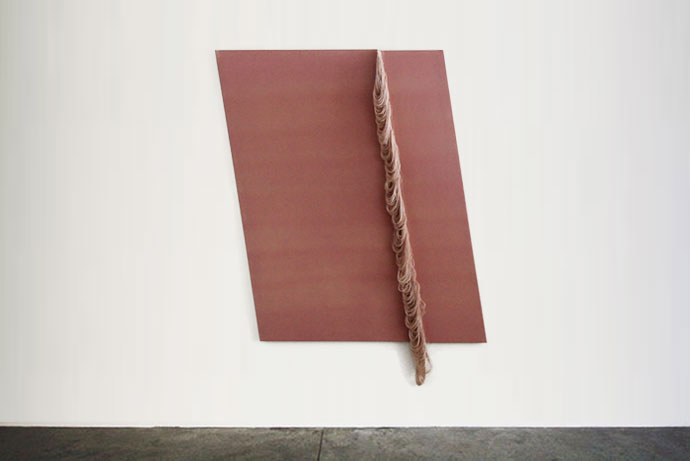


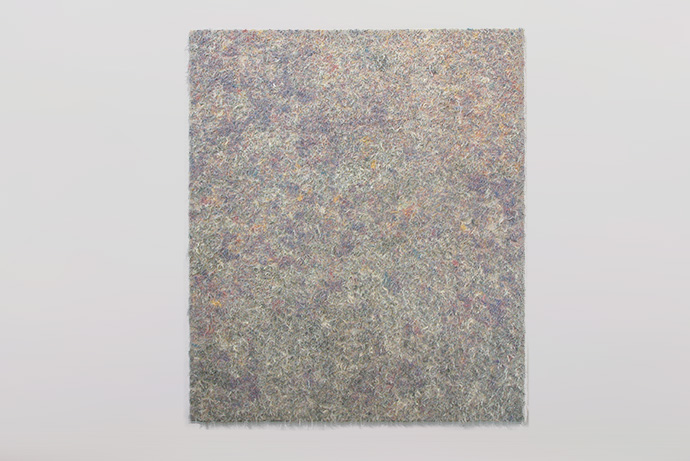
- 2nd from the top
Untitled
2017
acrylic, graphite, partially unwoven canvas, wood
H67 x W60 inches
- Bottom
Untitled
2018
shred threads from CMYK painted canvas, wood
H67 x W60 inches
A wall-hanging piece, four individual pieces painted in each of the CMYK (cyan, magenta, yellow, and black) colors are deconstructed (through thread removal) so that the fragments of removed threads the deconstruction process has yielded are combined to form a new whole. The assemblage of thread fragments reveals varying appearances depending on the viewer’s distance from the piece; in a sense, the work represents a pure projection of the visualization of unwritten rules.
October 4th - October 27th, 2018
Russo Lee Gallery, Portland OR
Untitled
2017
acrylic, graphite, partially unwoven canvas, wood
H67 x W60 inches
- Bottom
Untitled
2018
shred threads from CMYK painted canvas, wood
H67 x W60 inches
A wall-hanging piece, four individual pieces painted in each of the CMYK (cyan, magenta, yellow, and black) colors are deconstructed (through thread removal) so that the fragments of removed threads the deconstruction process has yielded are combined to form a new whole. The assemblage of thread fragments reveals varying appearances depending on the viewer’s distance from the piece; in a sense, the work represents a pure projection of the visualization of unwritten rules.
October 4th - October 27th, 2018
Russo Lee Gallery, Portland OR


- Bottom, center
Untitled
2018
graphite, partially unwoven canvas, wood
H262 x W15 x D60 inches
October 4th - October 27th, 2018
Russo Lee Gallery, Portland OR
Untitled
2018
graphite, partially unwoven canvas, wood
H262 x W15 x D60 inches
October 4th - October 27th, 2018
Russo Lee Gallery, Portland OR
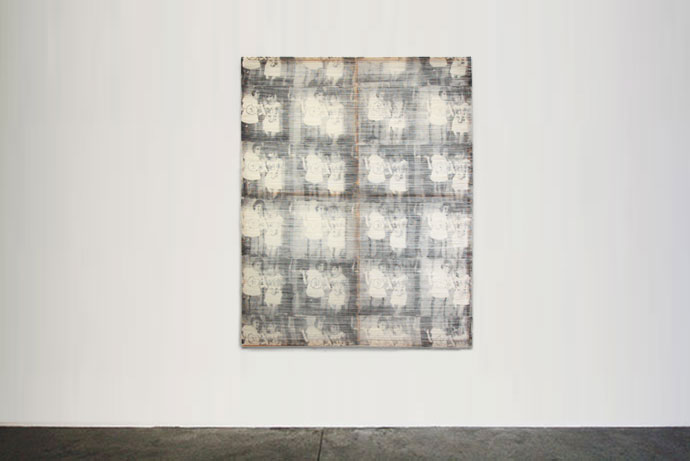
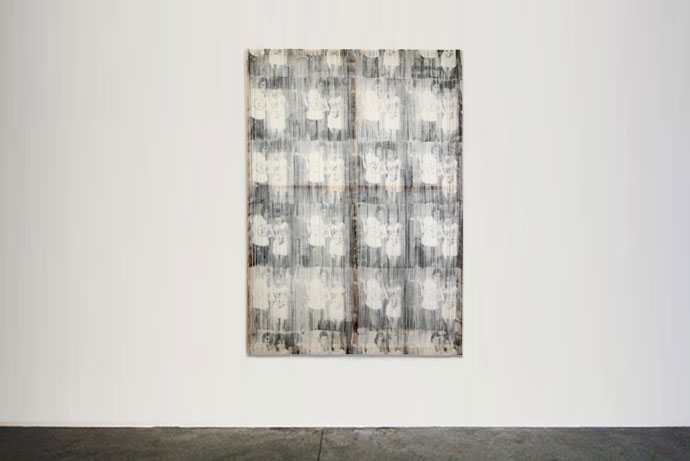
- Top
Untitled
2017
silkscreen, acrylic, graphite, partially unwoven canvas, wood
H65 x W53 xD2 inches
- Bottom
Untitled
2017
silkscreen, acrylic, graphite, partially unwoven canvas, wood
H69 x W49 xD2 inches
October 4th - October 27th, 2018
Russo Lee Gallery, Portland OR
Untitled
2017
silkscreen, acrylic, graphite, partially unwoven canvas, wood
H65 x W53 xD2 inches
- Bottom
Untitled
2017
silkscreen, acrylic, graphite, partially unwoven canvas, wood
H69 x W49 xD2 inches
October 4th - October 27th, 2018
Russo Lee Gallery, Portland OR

"The Veil” Group exhibition curated by Sequoia Day O'Connell at Bridge Productions, Seattle, WA
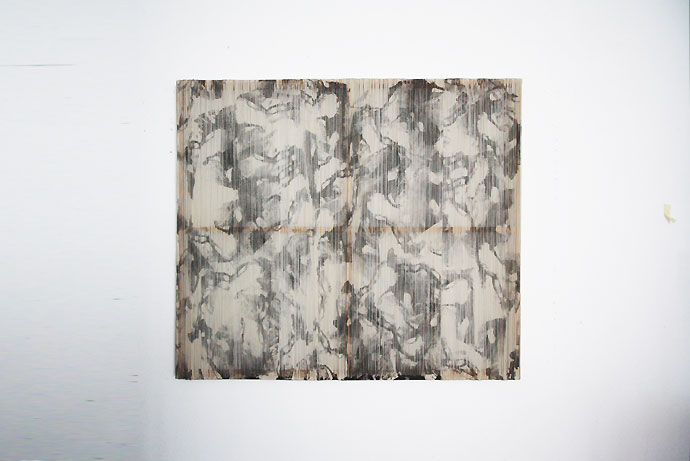
Untitled
2018
silkscreen, acrylic, graphite, partially unwoven canvas, wood
H67 x W91 xD2 inches
2018
silkscreen, acrylic, graphite, partially unwoven canvas, wood
H67 x W91 xD2 inches
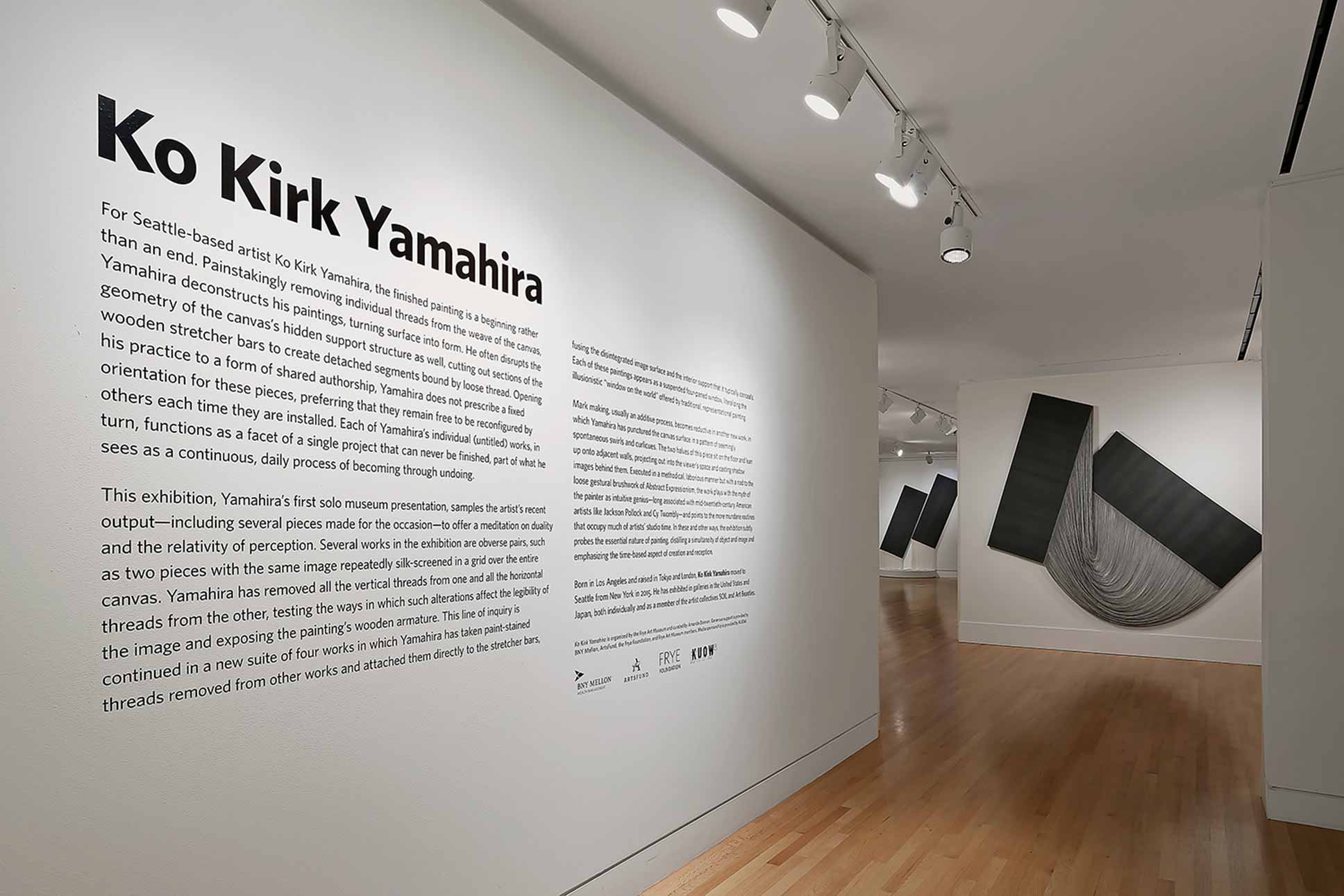
For Seattle-based artist Ko Kirk Yamahira, the finished painting is a beginning rather than an end. Painstakingly removing individual threads from the weave of the canvas, Yamahira deconstructs his paintings, turning surface into form. He often disrupts the geometry of the canvas’s hidden support structure as well, cutting out sections of the wooden stretcher bars to create detached segments bound by loose thread. Opening his practice to a form of shared authorship, Yamahira does not prescribe a fixed orientation for these pieces, preferring that they remain free to be reconfigured by others each time they are installed. Each of Yamahira’s individual (untitled) works functions as a facet of a single project that can never be finished, part of what he sees as a continuous, daily process of becoming through undoing.
This exhibition, Yamahira’s first solo museum presentation, samples the artist’s recent output—including several pieces made for the occasion—to offer a meditation on duality and the relativity of perception. Several works in the exhibition are obverse pairs, such as two pieces with the same image repeatedly silk-screened in a grid over the entire canvas. Yamahira has removed all the vertical threads from one and all the horizontal threads from the other, testing the ways in which such alterations affect the legibility of the image, and exposing the painting’s wooden armature. This line of inquiry is continued in a new suite of four works in which Yamahira has taken paint-stained threads removed from other works and attached them directly to the stretcher bars, fusing the disintegrated image surface and the interior support that it typically conceals. Each of these paintings appears as a suspended four-paned window, literalizing the illusionistic “window on the world” offered by traditional, representational painting.
Mark making, usually an additive process, becomes reductive in another new work, in which Yamahira has punctured the canvas surface in a pattern of seemingly spontaneous swirls and curlicues. The two halves of this piece sit on the floor and lean up onto adjacent walls, projecting out into the viewer’s space and casting a shadow image behind them. Executed in a methodical, laborious manner but with a nod to the loose gestural brushwork of Abstract Expressionism, the work plays with the idea of the painter as intuitive genius, a myth associated with that mid-twentieth-century movement, and points to the more mundane routines that occupy much of artists’ studio time. In these and other ways, the exhibition subtly probes the essential nature of painting, distilling a simultaneity of object and image and emphasizing the time-based aspect of creation and reception.
https://fryemuseum.org/exhibitions/ko-kirk-yamahira
February 17th - June 3rd, 2018
Frye Art Museum, Seattle WA
Image courtesy of the Frye Art Museum, Photo: Mark Woods
This exhibition, Yamahira’s first solo museum presentation, samples the artist’s recent output—including several pieces made for the occasion—to offer a meditation on duality and the relativity of perception. Several works in the exhibition are obverse pairs, such as two pieces with the same image repeatedly silk-screened in a grid over the entire canvas. Yamahira has removed all the vertical threads from one and all the horizontal threads from the other, testing the ways in which such alterations affect the legibility of the image, and exposing the painting’s wooden armature. This line of inquiry is continued in a new suite of four works in which Yamahira has taken paint-stained threads removed from other works and attached them directly to the stretcher bars, fusing the disintegrated image surface and the interior support that it typically conceals. Each of these paintings appears as a suspended four-paned window, literalizing the illusionistic “window on the world” offered by traditional, representational painting.
Mark making, usually an additive process, becomes reductive in another new work, in which Yamahira has punctured the canvas surface in a pattern of seemingly spontaneous swirls and curlicues. The two halves of this piece sit on the floor and lean up onto adjacent walls, projecting out into the viewer’s space and casting a shadow image behind them. Executed in a methodical, laborious manner but with a nod to the loose gestural brushwork of Abstract Expressionism, the work plays with the idea of the painter as intuitive genius, a myth associated with that mid-twentieth-century movement, and points to the more mundane routines that occupy much of artists’ studio time. In these and other ways, the exhibition subtly probes the essential nature of painting, distilling a simultaneity of object and image and emphasizing the time-based aspect of creation and reception.
https://fryemuseum.org/exhibitions/ko-kirk-yamahira
February 17th - June 3rd, 2018
Frye Art Museum, Seattle WA
Image courtesy of the Frye Art Museum, Photo: Mark Woods


- Bottom
Untitled
2018
shred threads from CMYK painted canvas, wood
H56 x W30 inches each
February 17th - June 3rd, 2018
Frye Art Museum, Seattle WA
Image courtesy of the Frye Art Museum, Photo: Mark Woods
Untitled
2018
shred threads from CMYK painted canvas, wood
H56 x W30 inches each
February 17th - June 3rd, 2018
Frye Art Museum, Seattle WA
Image courtesy of the Frye Art Museum, Photo: Mark Woods




- Top
Untitled
2018
acrylic, graphite, partially unwoven canvas, wood
H90 x W113 x D2 inches
- 3rd from the top, left to right
Left
Untitled
2018
acrylic, graphite, partially unwoven canvas, wood
H90 x W113 x D2 inches
MIddle
Untitled
2017
acrylic, graphite, partially unwoven canvas, wood
H60 x W67 x D3 inches
Right
Untitled
2017
acrylic, graphite, partially unwoven canvas, wood
H67 x W60 x D3 inches
February 17th - June 3rd, 2018
Frye Art Museum, Seattle WA
Image courtesy of the Frye Art Museum, Photo: Mark Woods
Untitled
2018
acrylic, graphite, partially unwoven canvas, wood
H90 x W113 x D2 inches
- 3rd from the top, left to right
Left
Untitled
2018
acrylic, graphite, partially unwoven canvas, wood
H90 x W113 x D2 inches
MIddle
Untitled
2017
acrylic, graphite, partially unwoven canvas, wood
H60 x W67 x D3 inches
Right
Untitled
2017
acrylic, graphite, partially unwoven canvas, wood
H67 x W60 x D3 inches
February 17th - June 3rd, 2018
Frye Art Museum, Seattle WA
Image courtesy of the Frye Art Museum, Photo: Mark Woods


Untitled
2018
partially unwoven canvas, wood and mirror
H80 x W280 x D24 inches each
February 17th - June 3rd, 2018
Frye Art Museum, Seattle WA
Image courtesy of the Frye Art Museum, Photo: Mark Woods
2018
partially unwoven canvas, wood and mirror
H80 x W280 x D24 inches each
February 17th - June 3rd, 2018
Frye Art Museum, Seattle WA
Image courtesy of the Frye Art Museum, Photo: Mark Woods


- Top
Untitled
2017
silkscreen, acrylic, graphite, partially unwoven canvas, wood
H53 x W53 xD2 inches
February 17th - June 3rd, 2018
Frye Art Museum, Seattle WA
Image courtesy of the Frye Art Museum, Photo: Mark Woods
Untitled
2017
silkscreen, acrylic, graphite, partially unwoven canvas, wood
H53 x W53 xD2 inches
February 17th - June 3rd, 2018
Frye Art Museum, Seattle WA
Image courtesy of the Frye Art Museum, Photo: Mark Woods
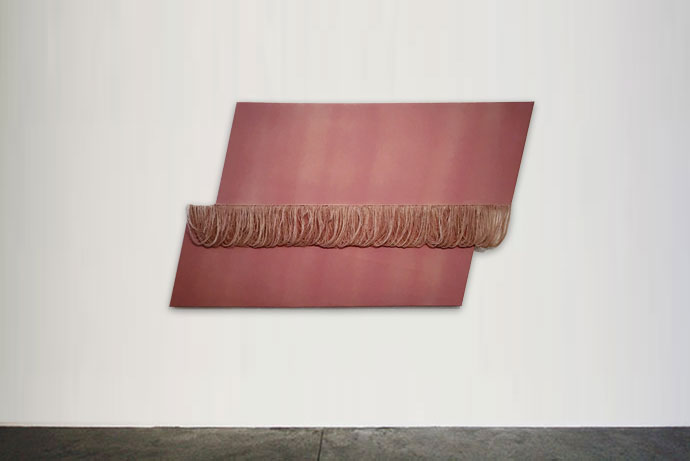
Untitled
2017
silkscreen, acrylic, graphite, partially unwoven canvas, wood
H60 x W67 xD2 inches
SEVEN BODIES - New Member's Show
For the month of August, SOIL Gallery presents seven new members navigating through themes of connectivity in the group exhibition, Seven Bodies. This diverse group of artists create works that form intersections with and relationships to their new community. Notions of the body are woven through the interdisciplinary works on display.
https://soilart.org/2017-exhibitions/aug-seven-bodies-new-members-show
August 3rd - September 2nd
SOIL Gallery, Seattle WA
2017
silkscreen, acrylic, graphite, partially unwoven canvas, wood
H60 x W67 xD2 inches
SEVEN BODIES - New Member's Show
For the month of August, SOIL Gallery presents seven new members navigating through themes of connectivity in the group exhibition, Seven Bodies. This diverse group of artists create works that form intersections with and relationships to their new community. Notions of the body are woven through the interdisciplinary works on display.
https://soilart.org/2017-exhibitions/aug-seven-bodies-new-members-show
August 3rd - September 2nd
SOIL Gallery, Seattle WA



Untitled
2017
acrylic, graphite, partially unwoven canvas, wood
H11 x W262 inches
2017
acrylic, graphite, partially unwoven canvas, wood
H11 x W262 inches
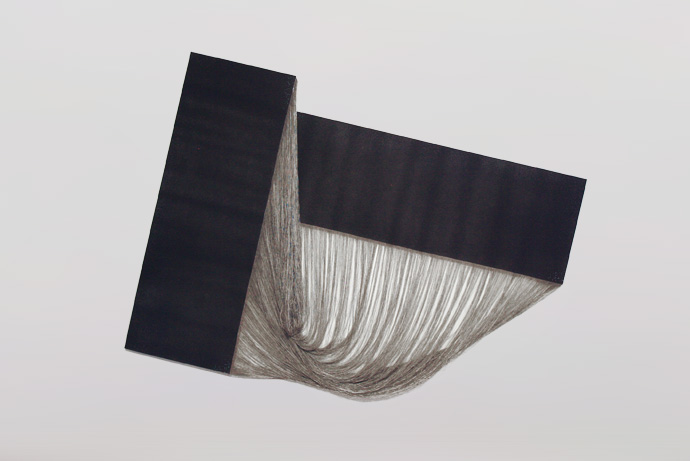
Untitled
2017
acrylic, graphite, partially unwoven canvas, wood
H70 x W90 x D2 inches
2017
acrylic, graphite, partially unwoven canvas, wood
H70 x W90 x D2 inches
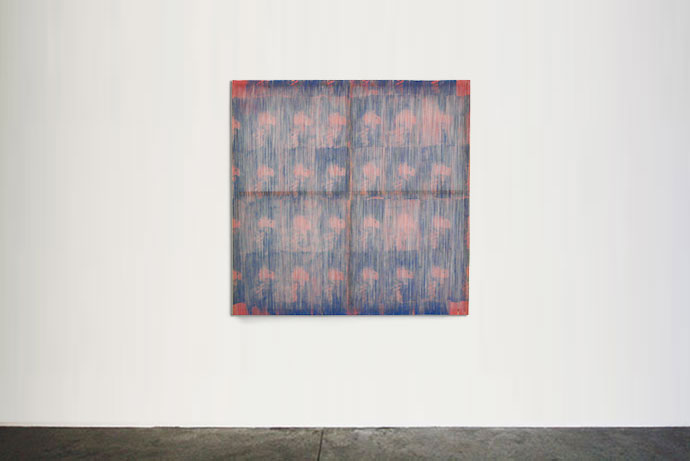
Untitled
2017
acrylic, graphite, partially unwoven canvas, wood
H50 x W50 x D2 inches each
2017
acrylic, graphite, partially unwoven canvas, wood
H50 x W50 x D2 inches each



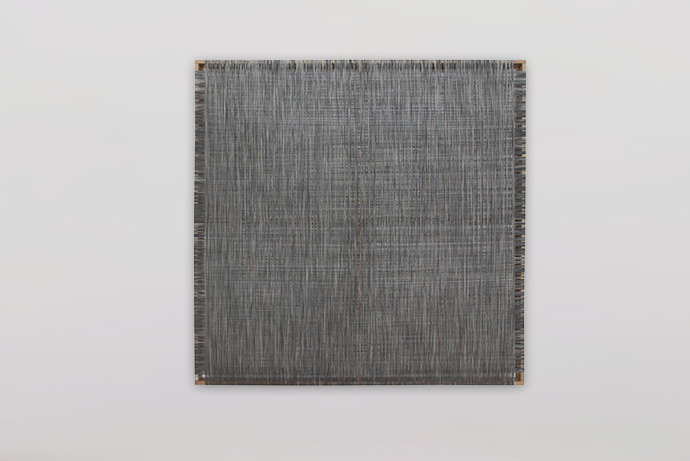

- Bottom
Untitled
2017
acrylic, graphite, partially unwoven canvas, wood
H53 x W53 x D2 inches
After coloring the two canvases, leave a few inches on both sides to stretch them on the wooden frame, remove all the threads on one side, the warp, and the weft on the other. The canvas with the weft removed is stretched vertically on the wooden frame, and the canvas with the warp removed is stretched horizontally. These works are usually exhibited as a pair, with the paired work made up of the shred threads removed from the two canvases. During the creative process, the two intersect, one gradually losing its shape while the other is gradually added to, reconstructing the work.
"Deconstruction” at Mithun Design Threshold Gallery, Seattle, WA
Untitled
2017
acrylic, graphite, partially unwoven canvas, wood
H53 x W53 x D2 inches
After coloring the two canvases, leave a few inches on both sides to stretch them on the wooden frame, remove all the threads on one side, the warp, and the weft on the other. The canvas with the weft removed is stretched vertically on the wooden frame, and the canvas with the warp removed is stretched horizontally. These works are usually exhibited as a pair, with the paired work made up of the shred threads removed from the two canvases. During the creative process, the two intersect, one gradually losing its shape while the other is gradually added to, reconstructing the work.
"Deconstruction” at Mithun Design Threshold Gallery, Seattle, WA
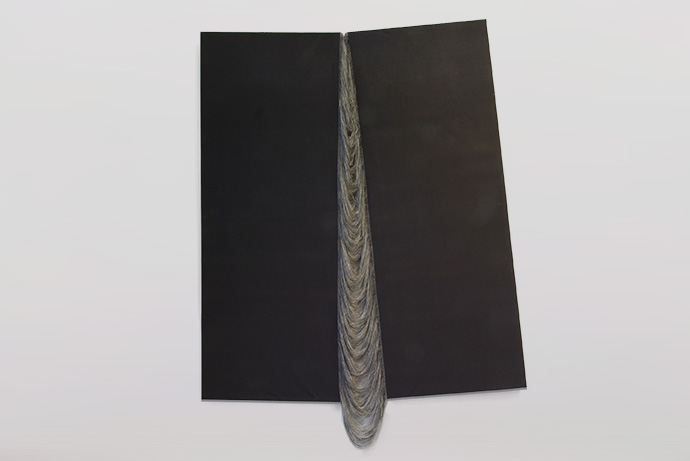
Untitled
2017
acrylic, graphite, partially unwoven canvas, wood
H67 x W53 x D2 inches
The original canvas was a square, and after coloring with a mixture of CMY colors, all the warp threads in the central 7-inch width were removed. The top two ends were aligned, and a slight angle was added to the bottom right frame. Although the work is physically the same length and width, it appears visually different just by removing the threads and giving it a slight angle. Deconstructing and reconstructing the work gives it new dimensions and defines how to perceive the aspects presents in the subject.
2017
acrylic, graphite, partially unwoven canvas, wood
H67 x W53 x D2 inches
The original canvas was a square, and after coloring with a mixture of CMY colors, all the warp threads in the central 7-inch width were removed. The top two ends were aligned, and a slight angle was added to the bottom right frame. Although the work is physically the same length and width, it appears visually different just by removing the threads and giving it a slight angle. Deconstructing and reconstructing the work gives it new dimensions and defines how to perceive the aspects presents in the subject.
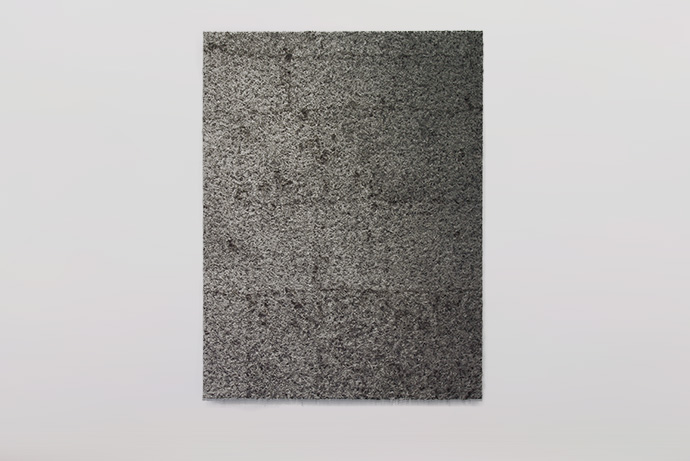
Untitled
2017
acrylic, graphite, partially unwoven canvas, wood
H67 x W48 x D2 inches
2017
acrylic, graphite, partially unwoven canvas, wood
H67 x W48 x D2 inches


Untitled
2017
acrylic, graphite, partially unwoven canvas, wood
H60 x W42 x D2 inches
2017
acrylic, graphite, partially unwoven canvas, wood
H60 x W42 x D2 inches



Untitled
2017
acrylic, graphite, partially unwoven canvas, wood
H32 x W16 x D2 inches each
2017
acrylic, graphite, partially unwoven canvas, wood
H32 x W16 x D2 inches each